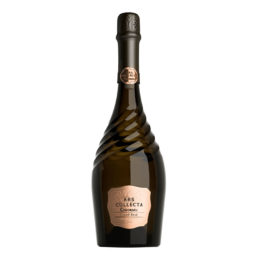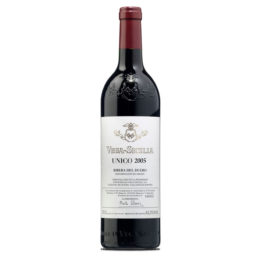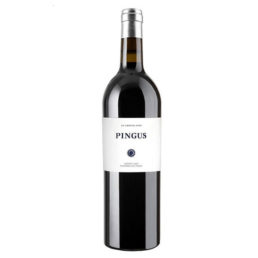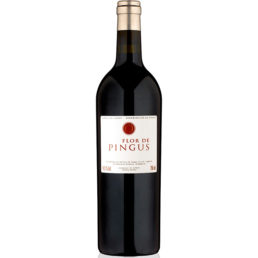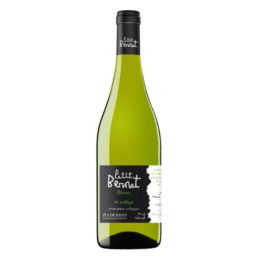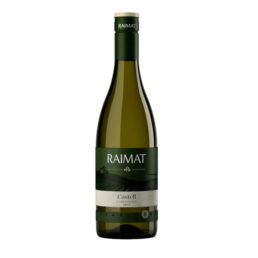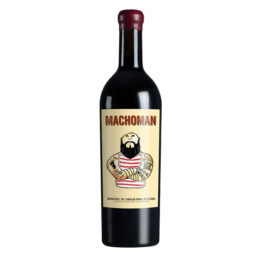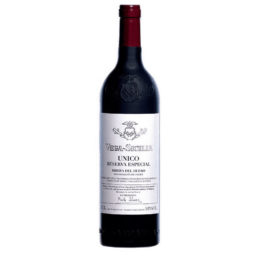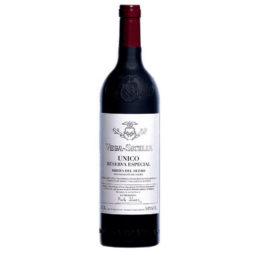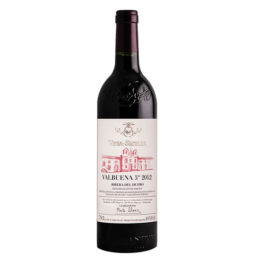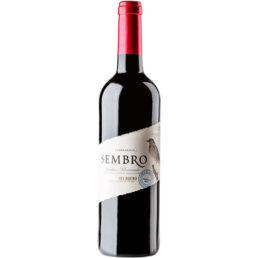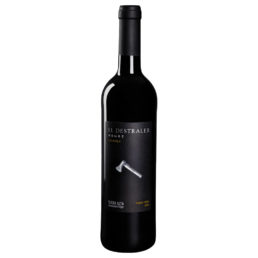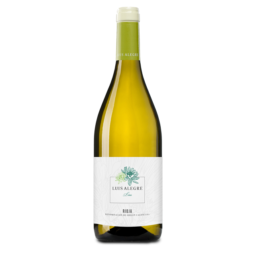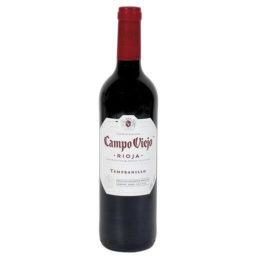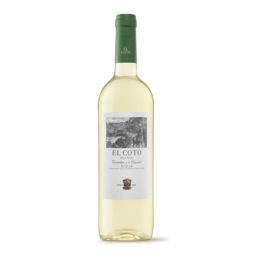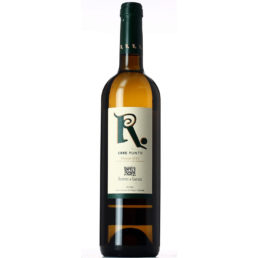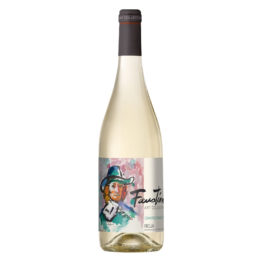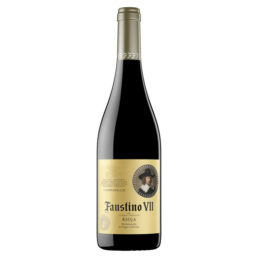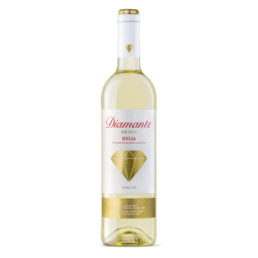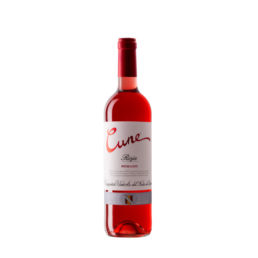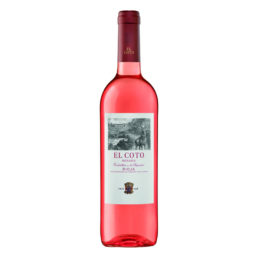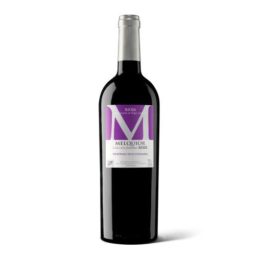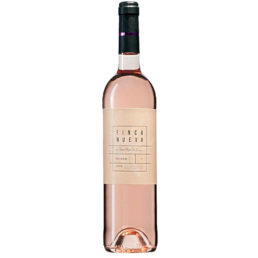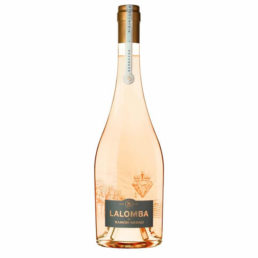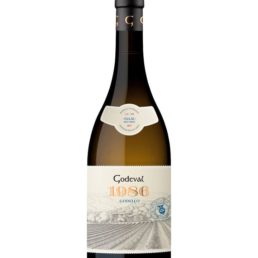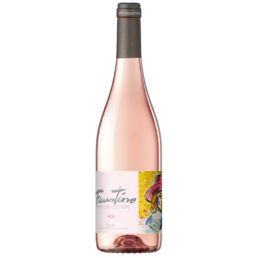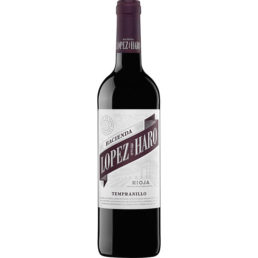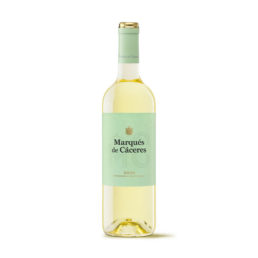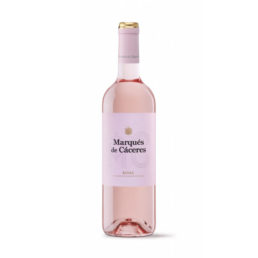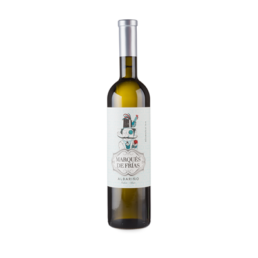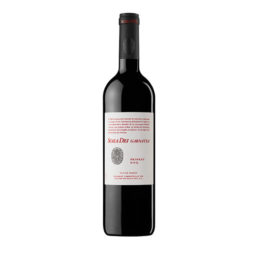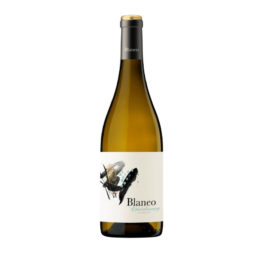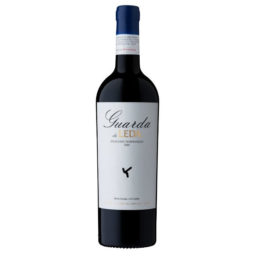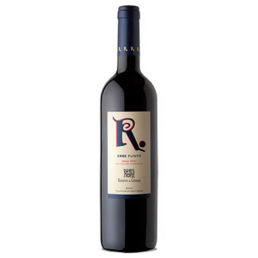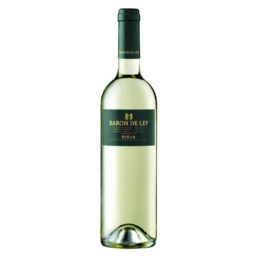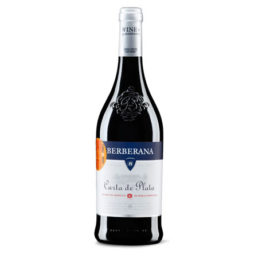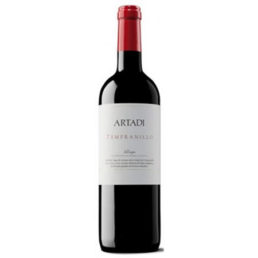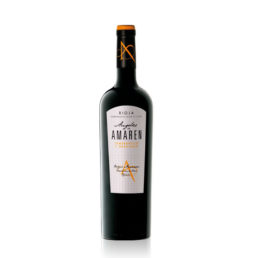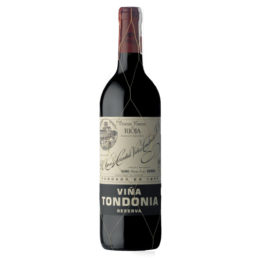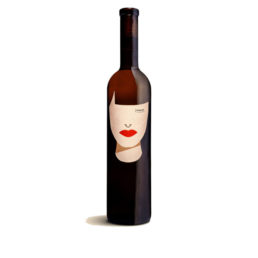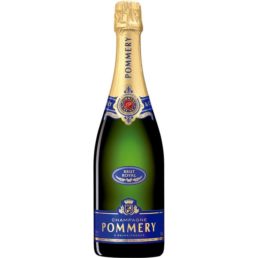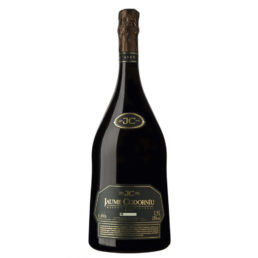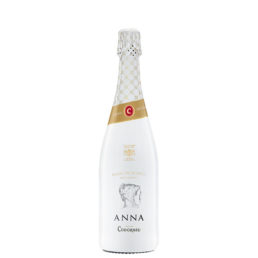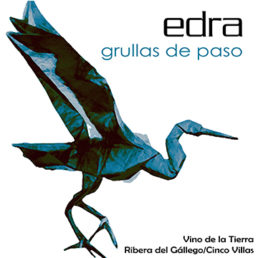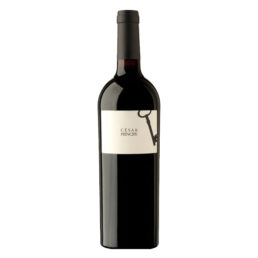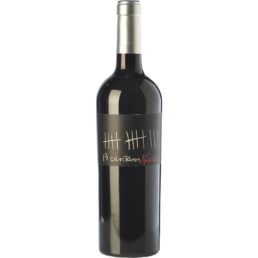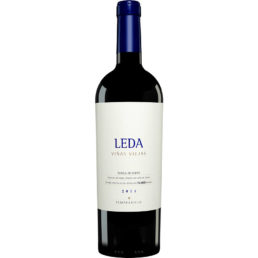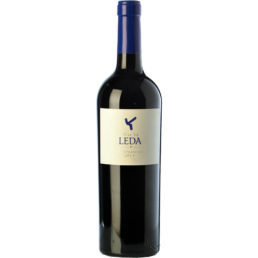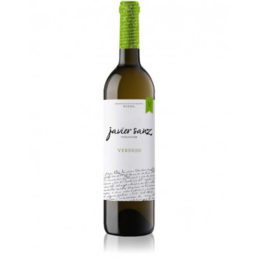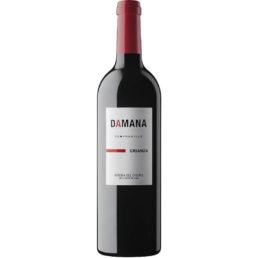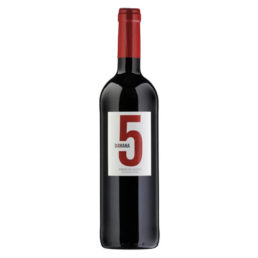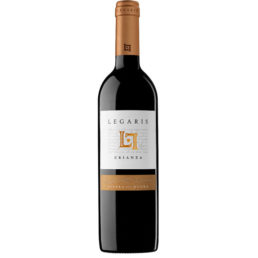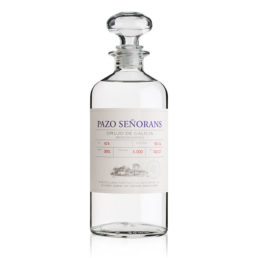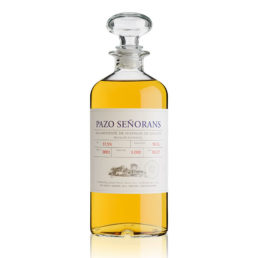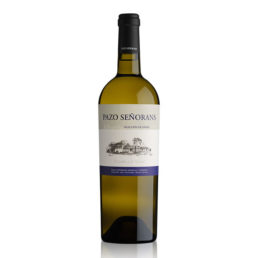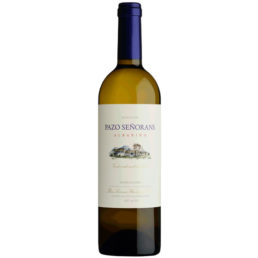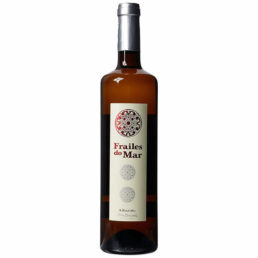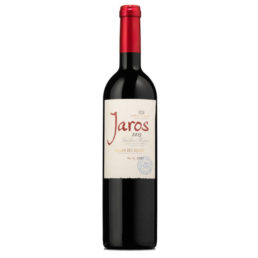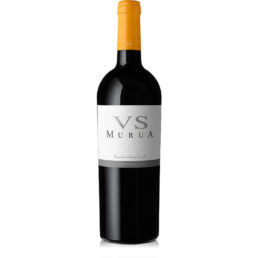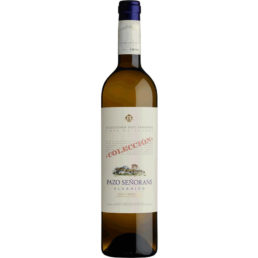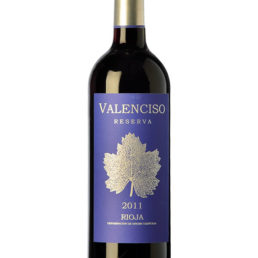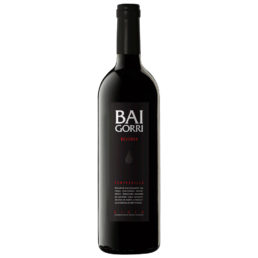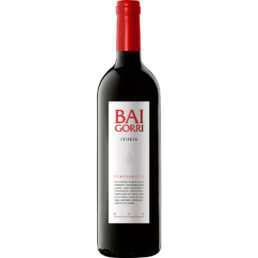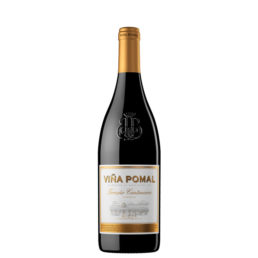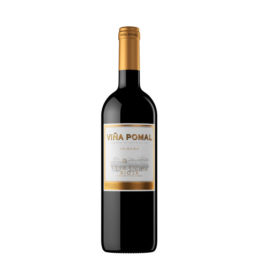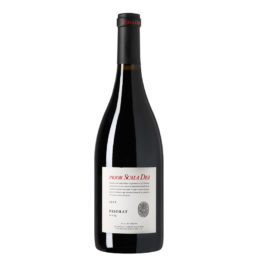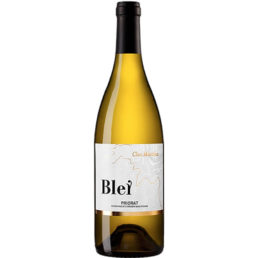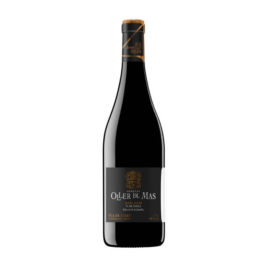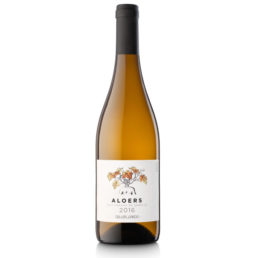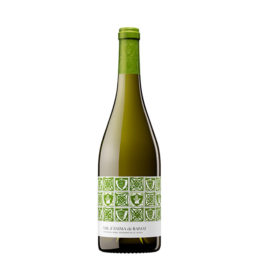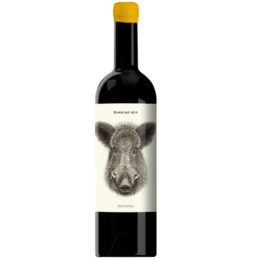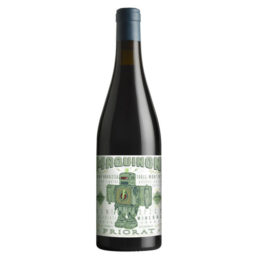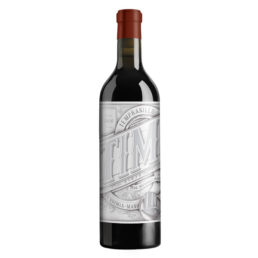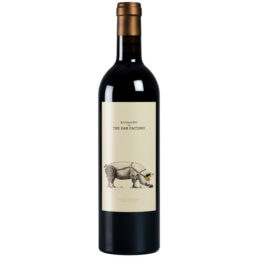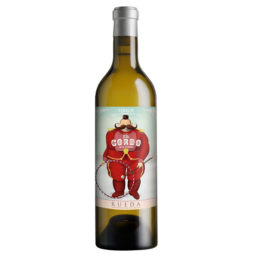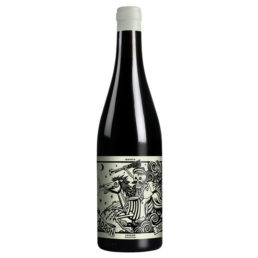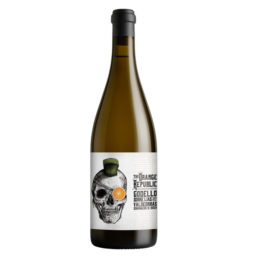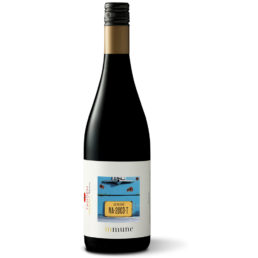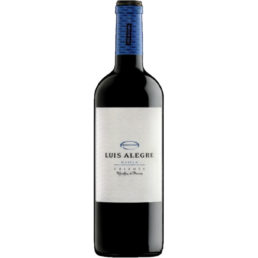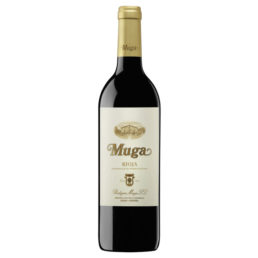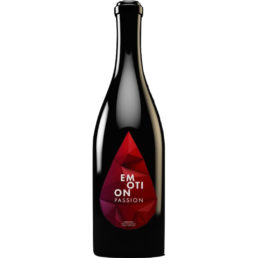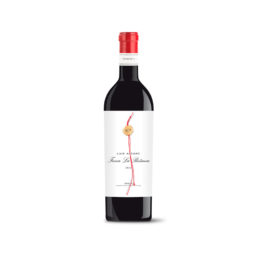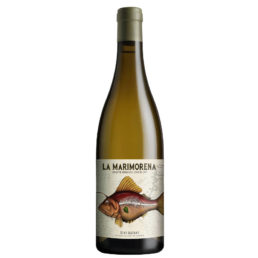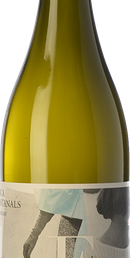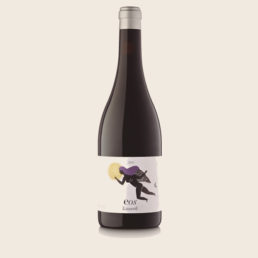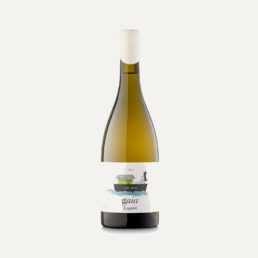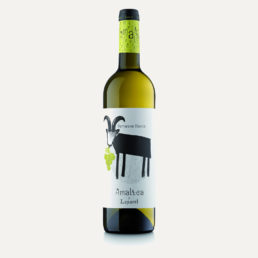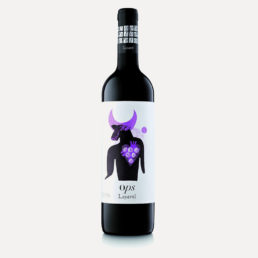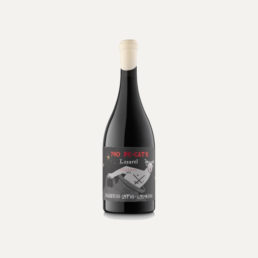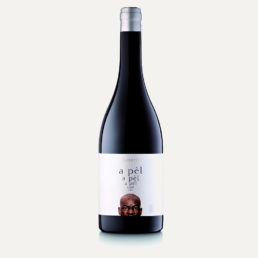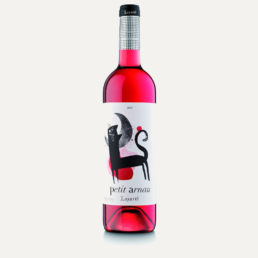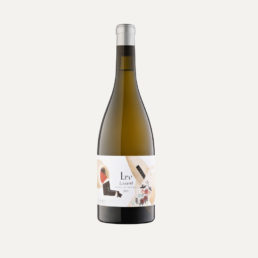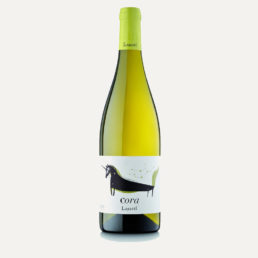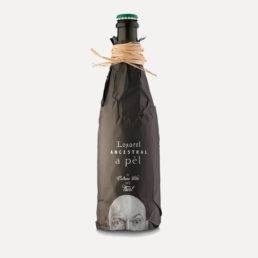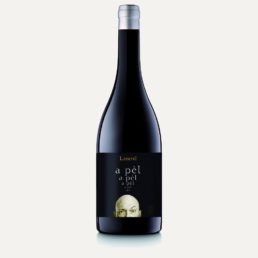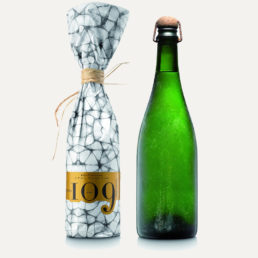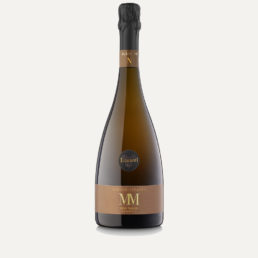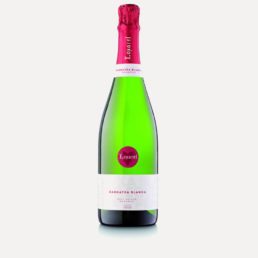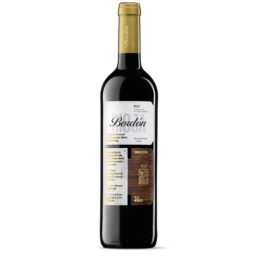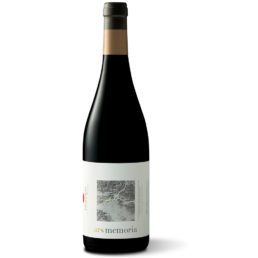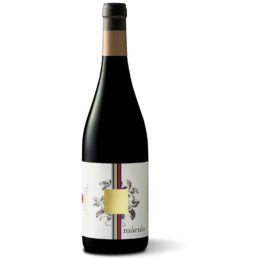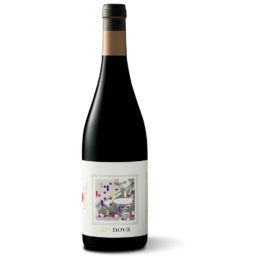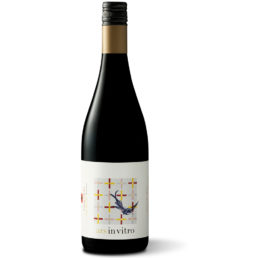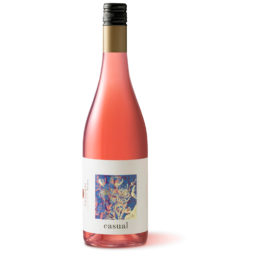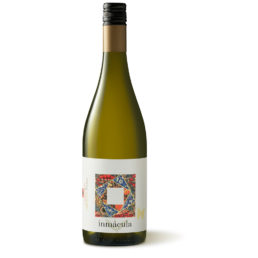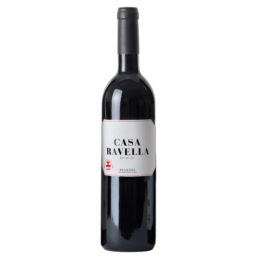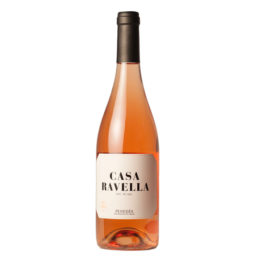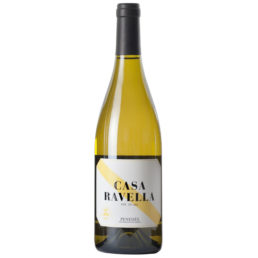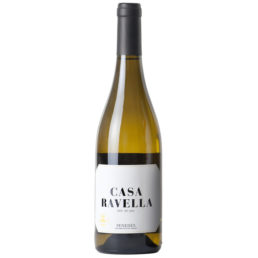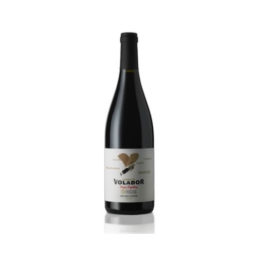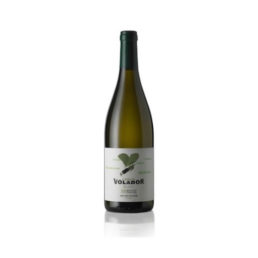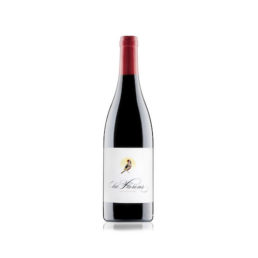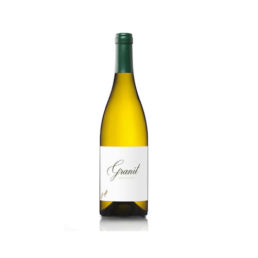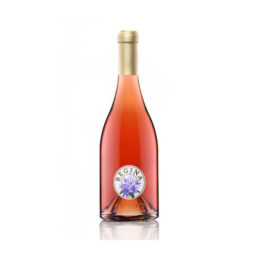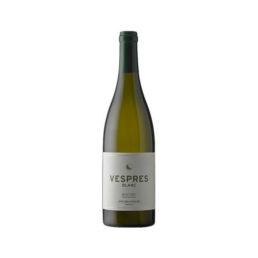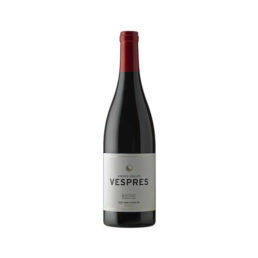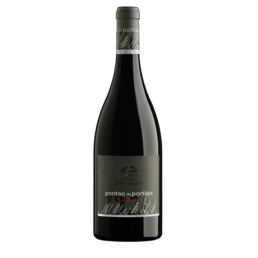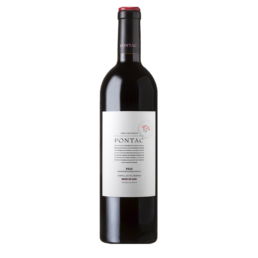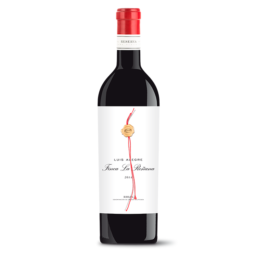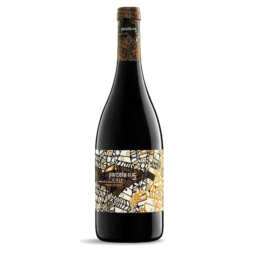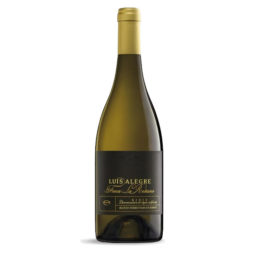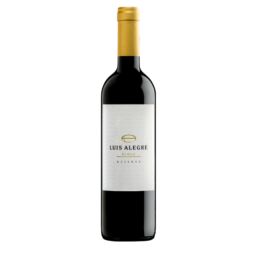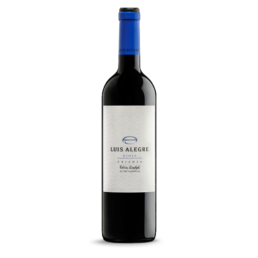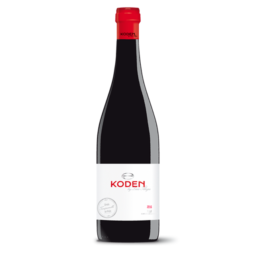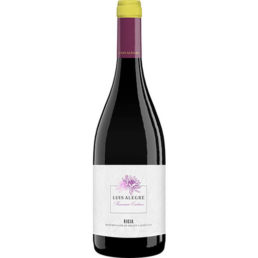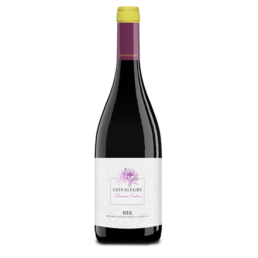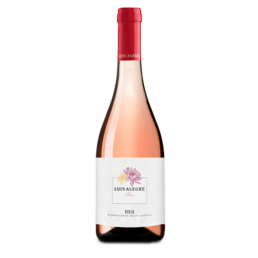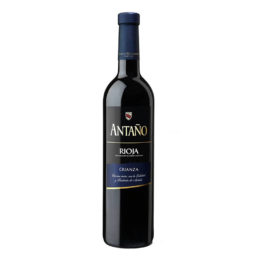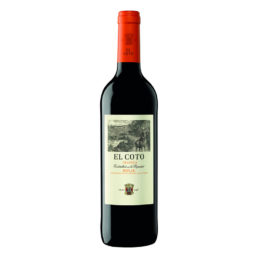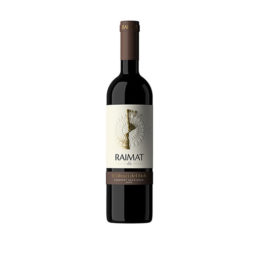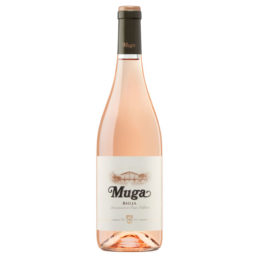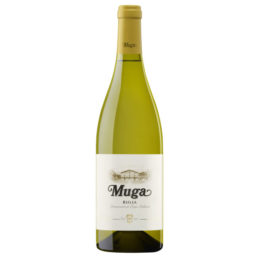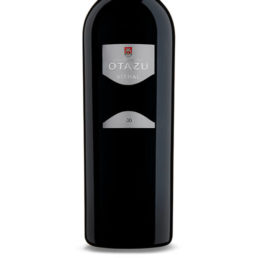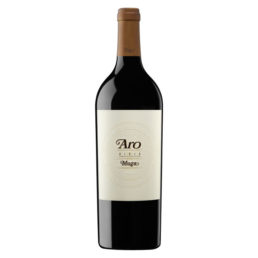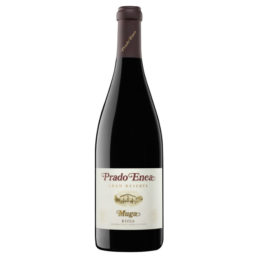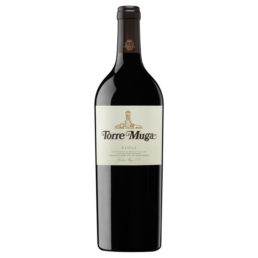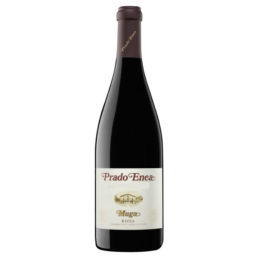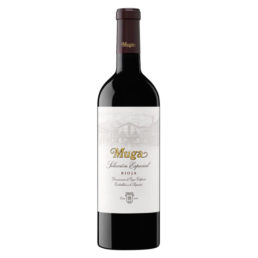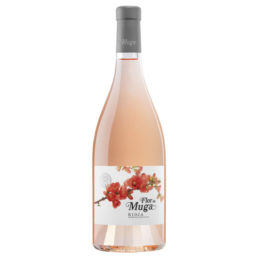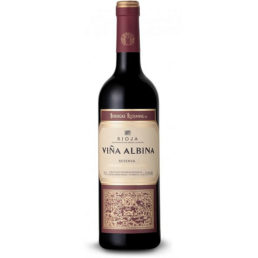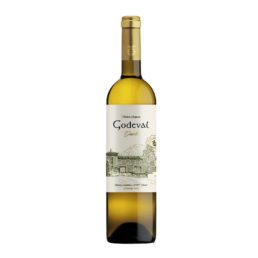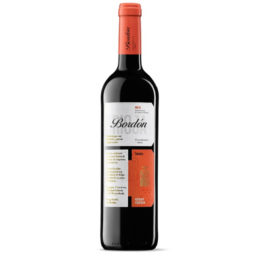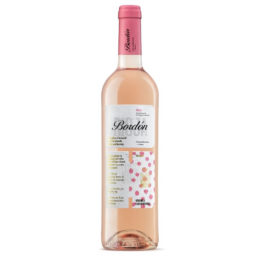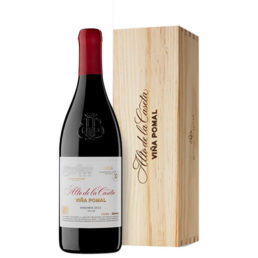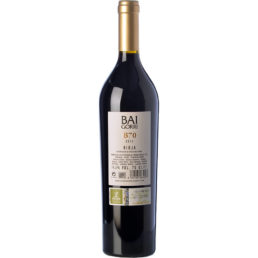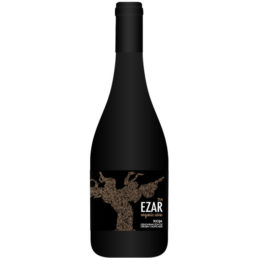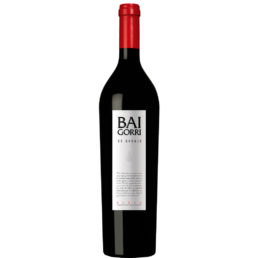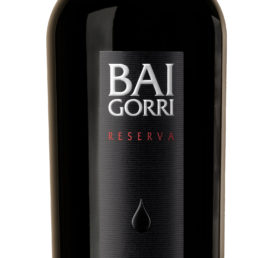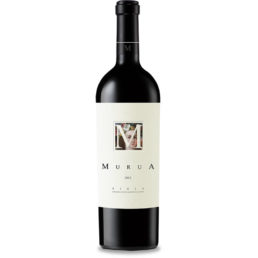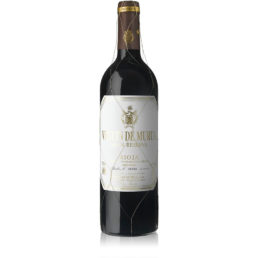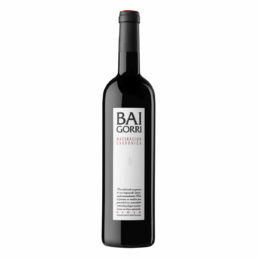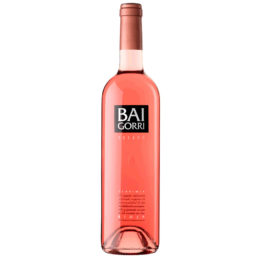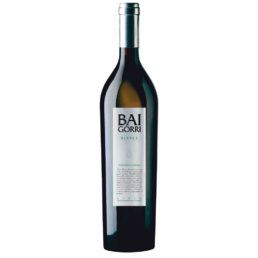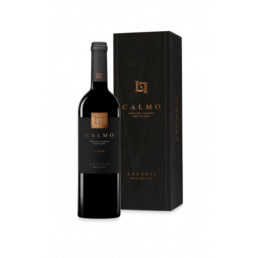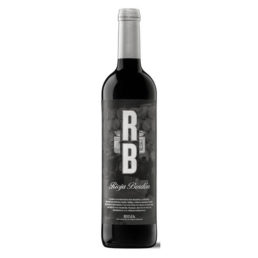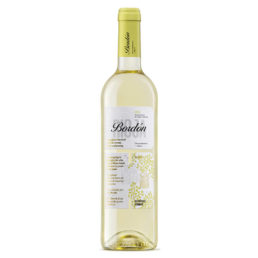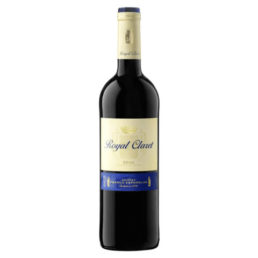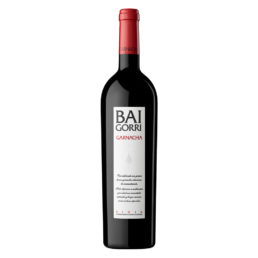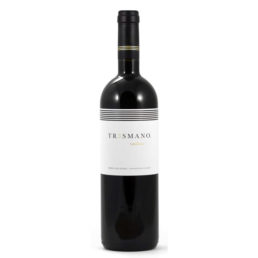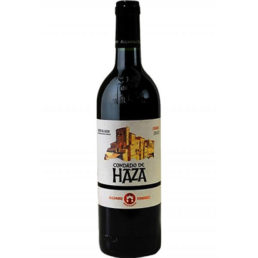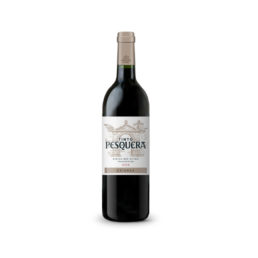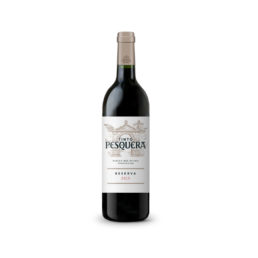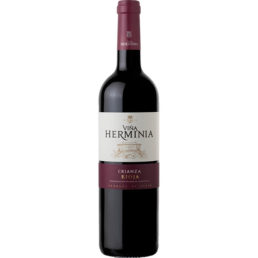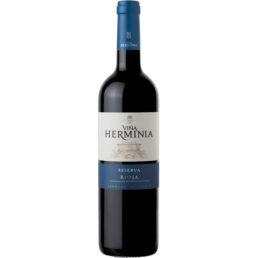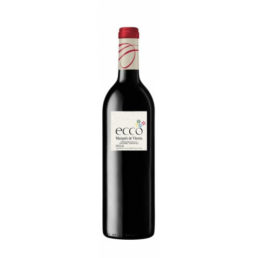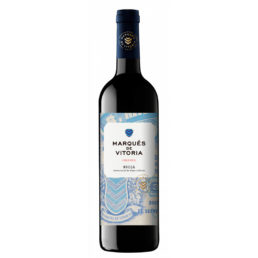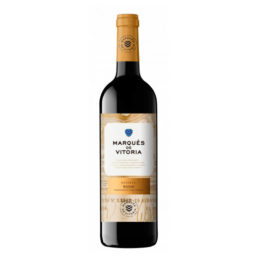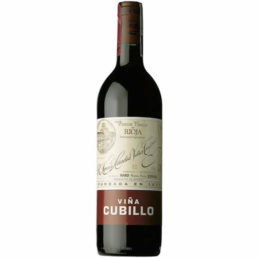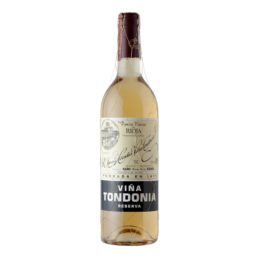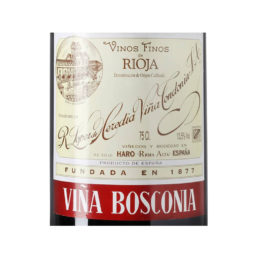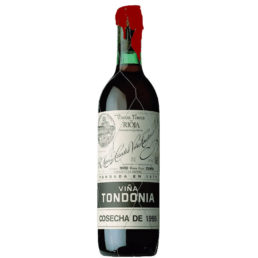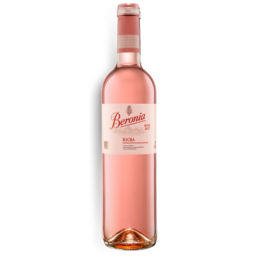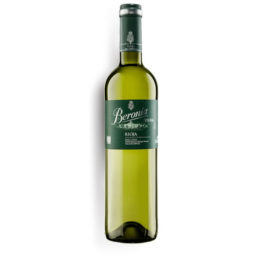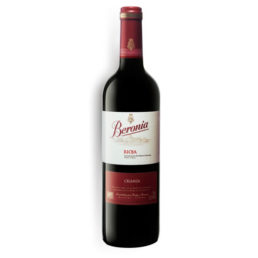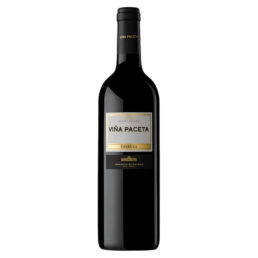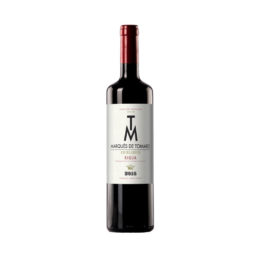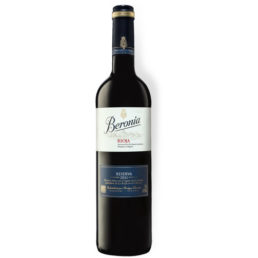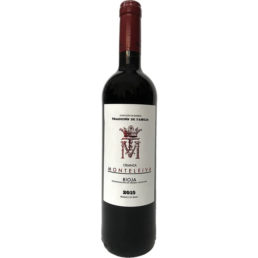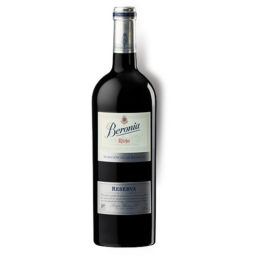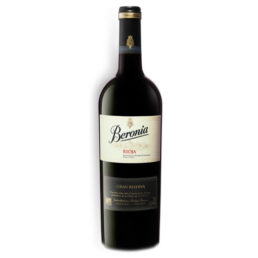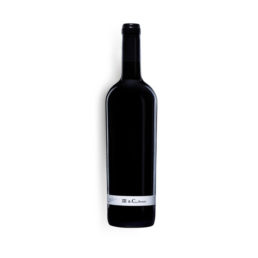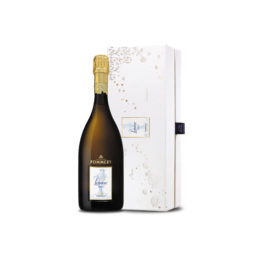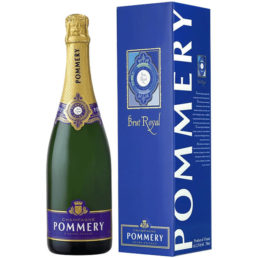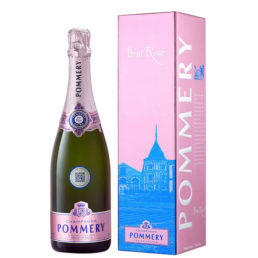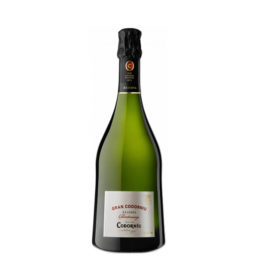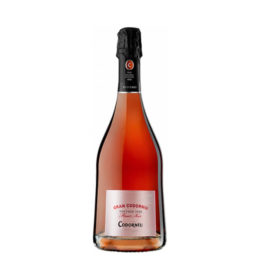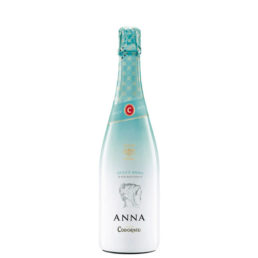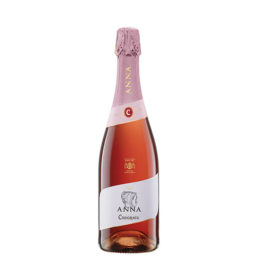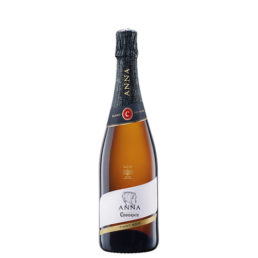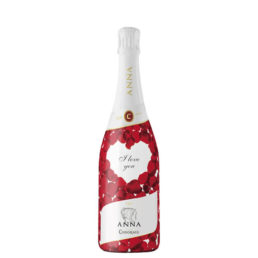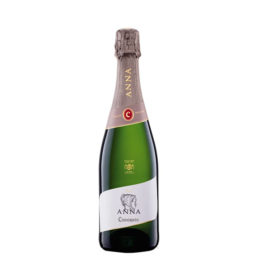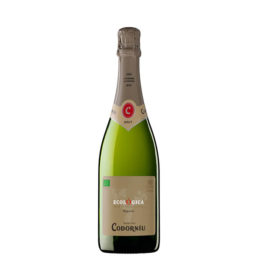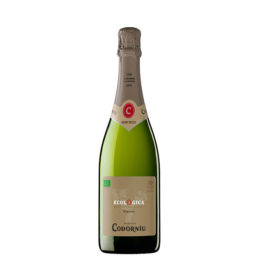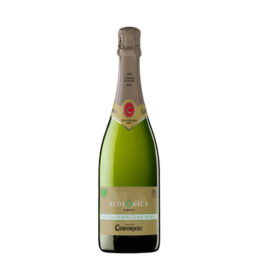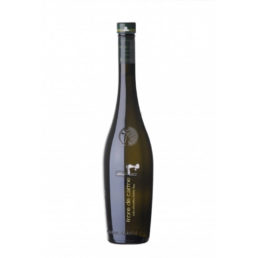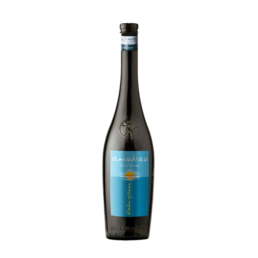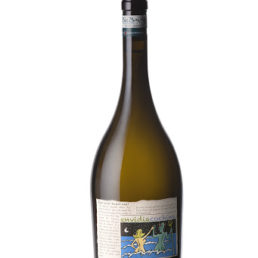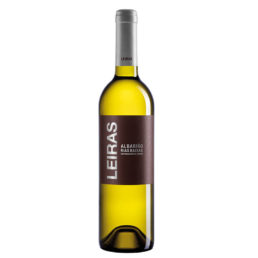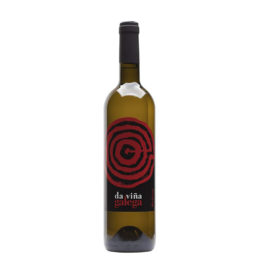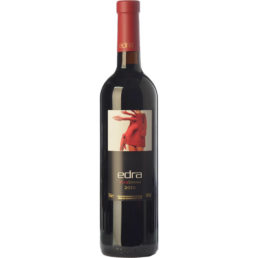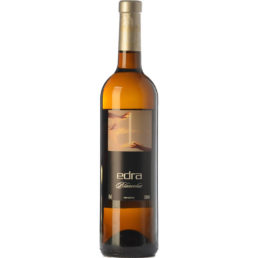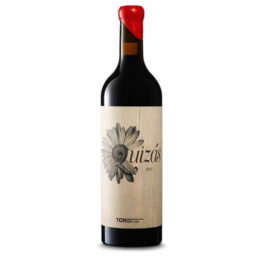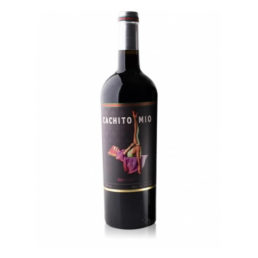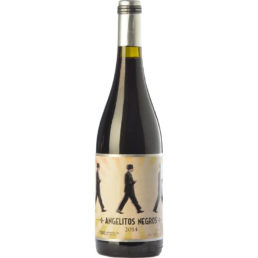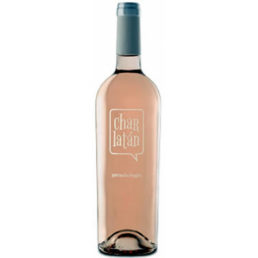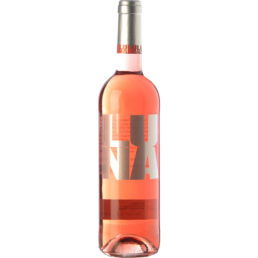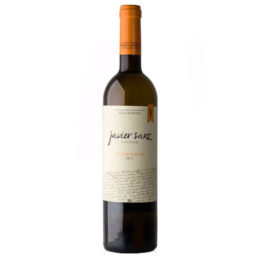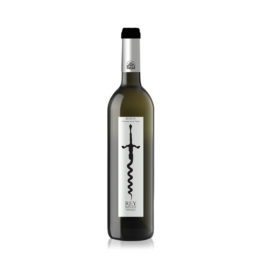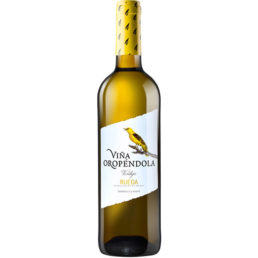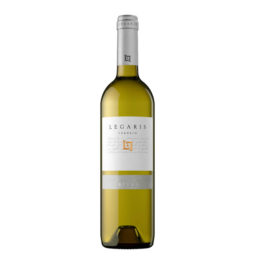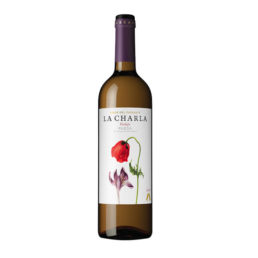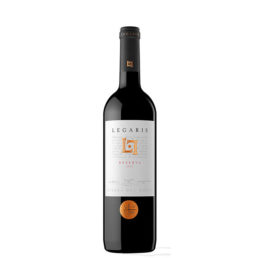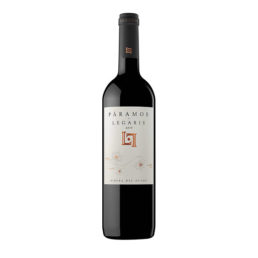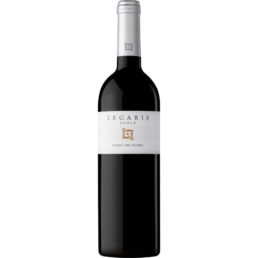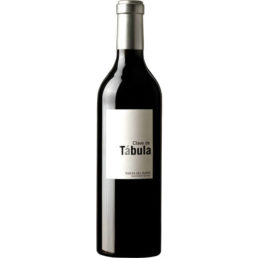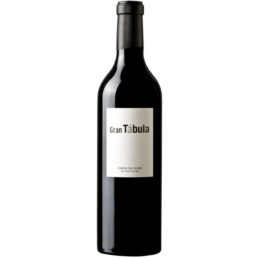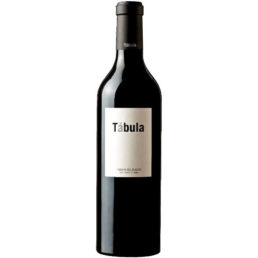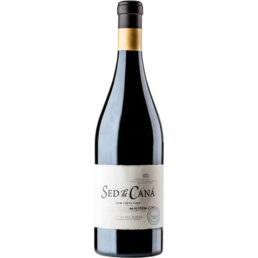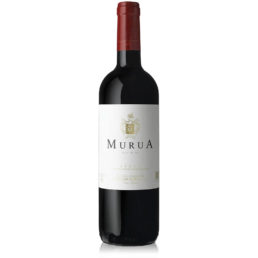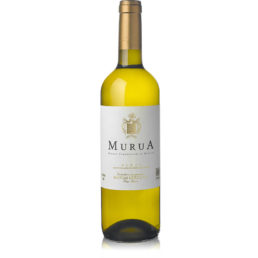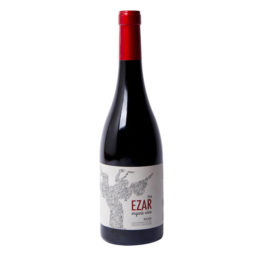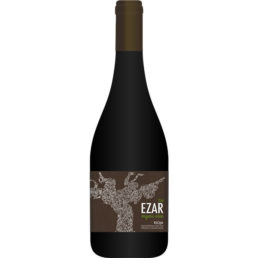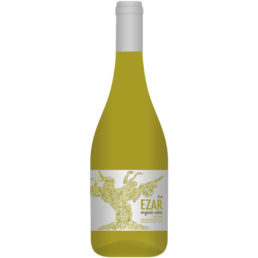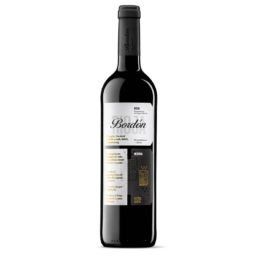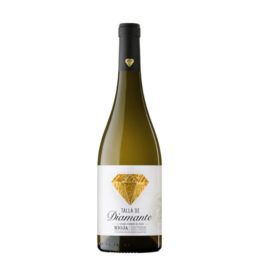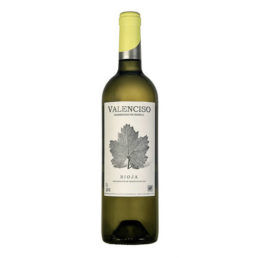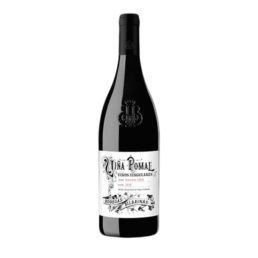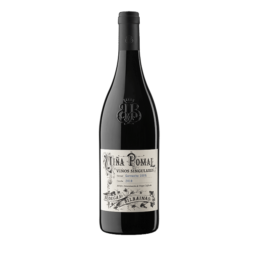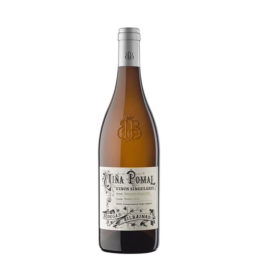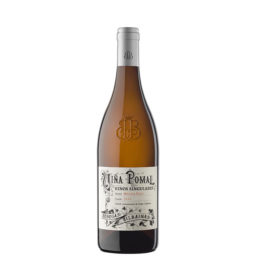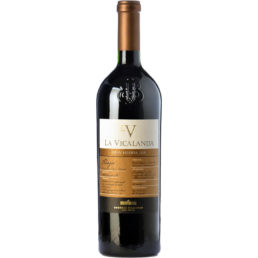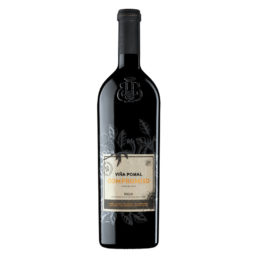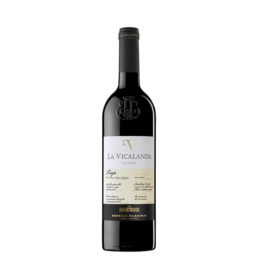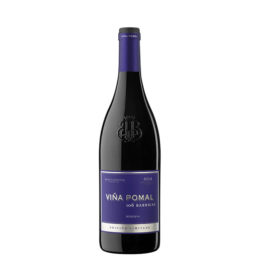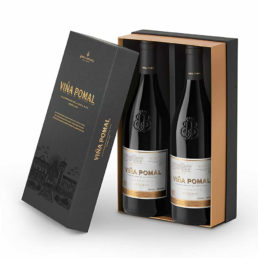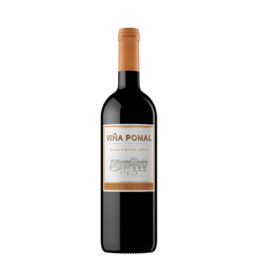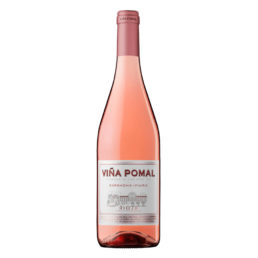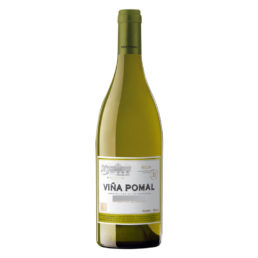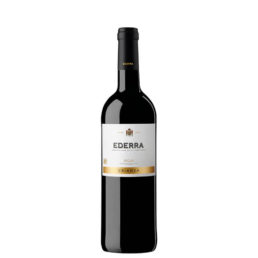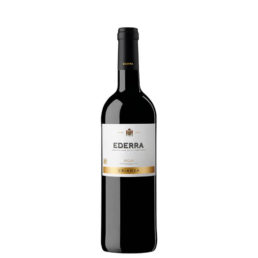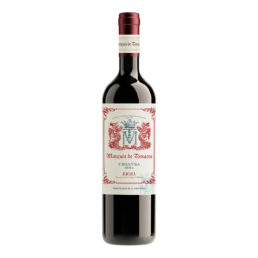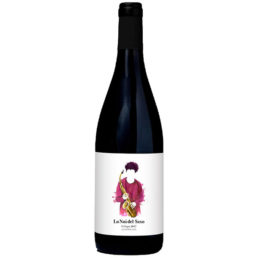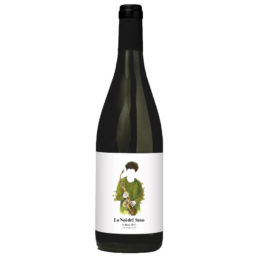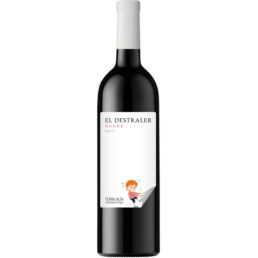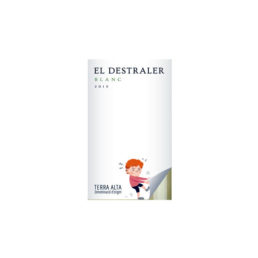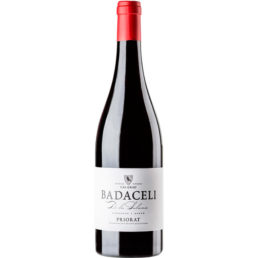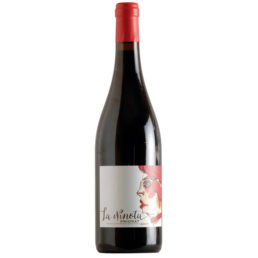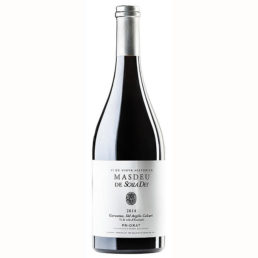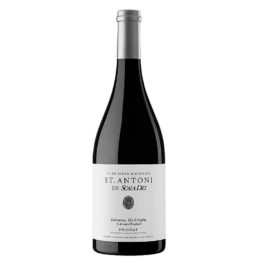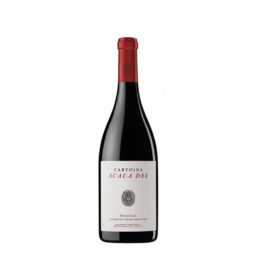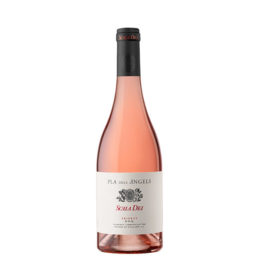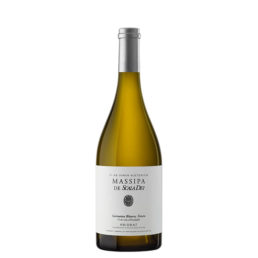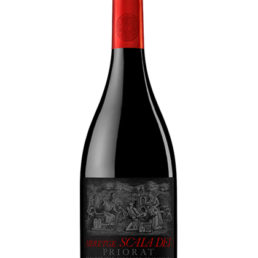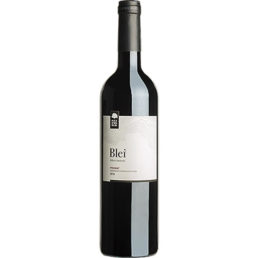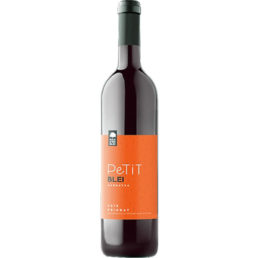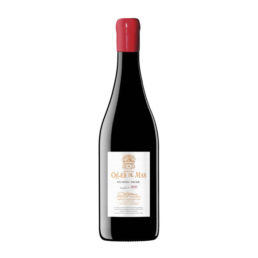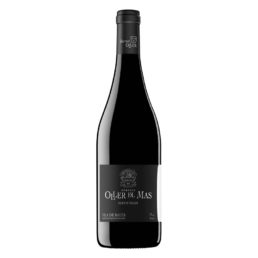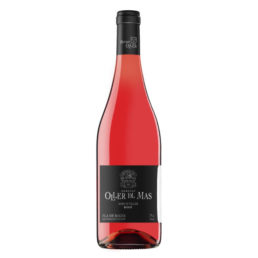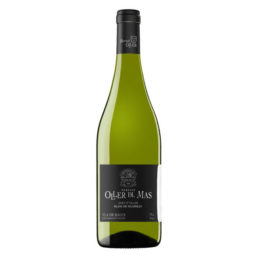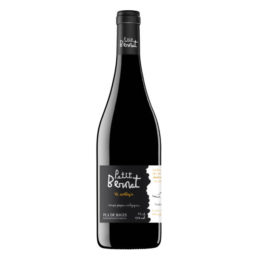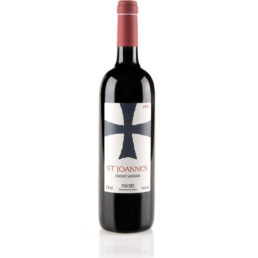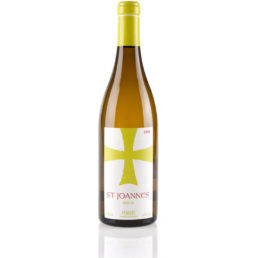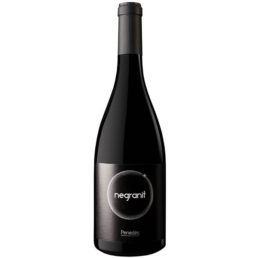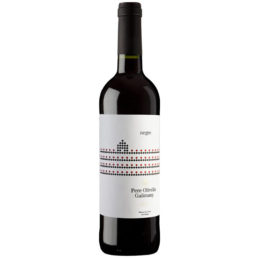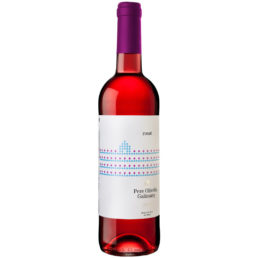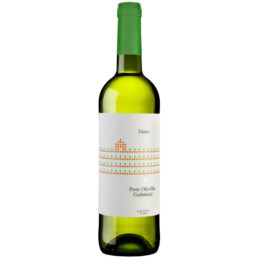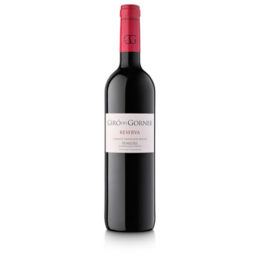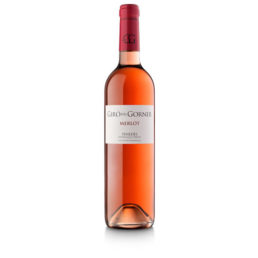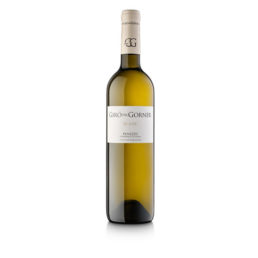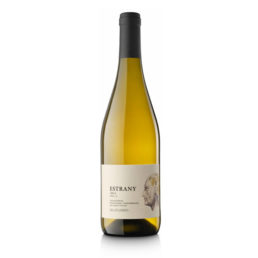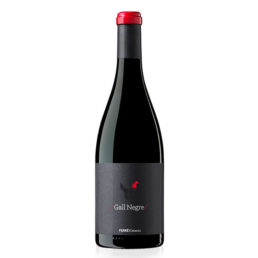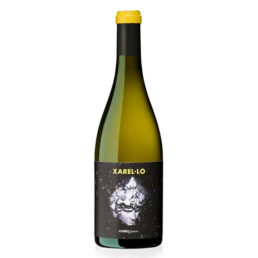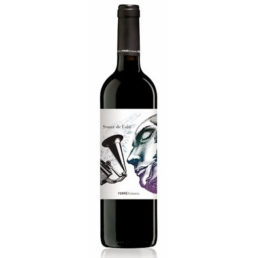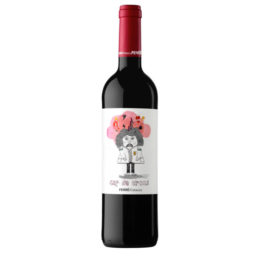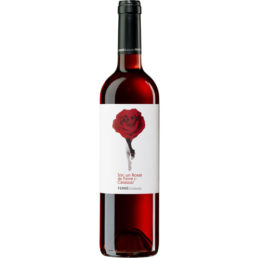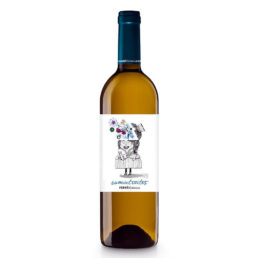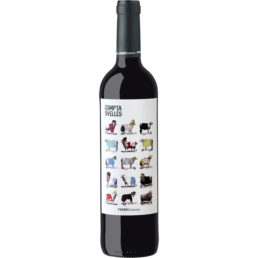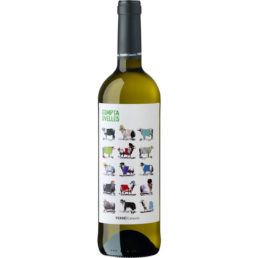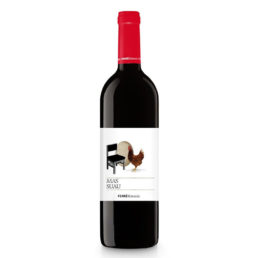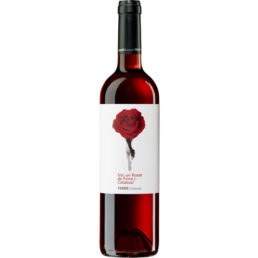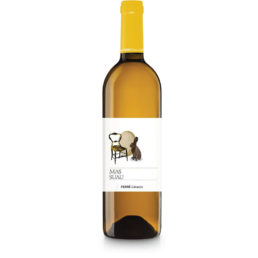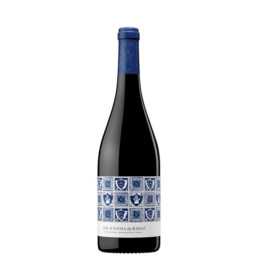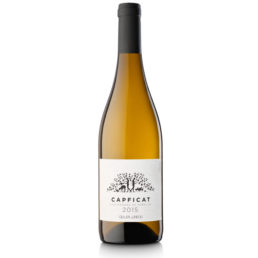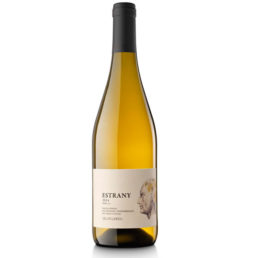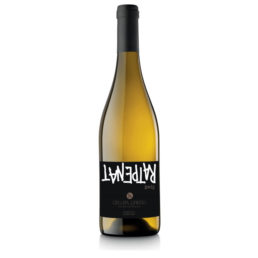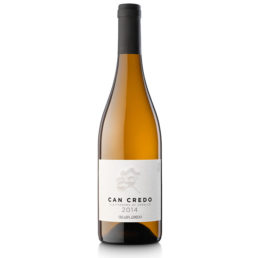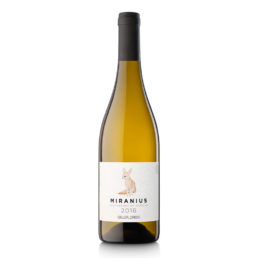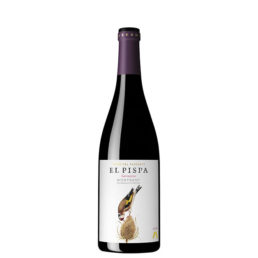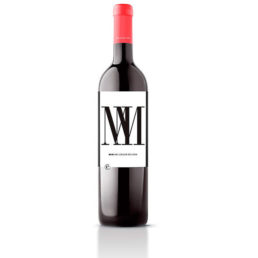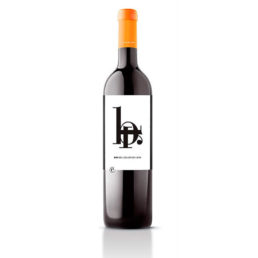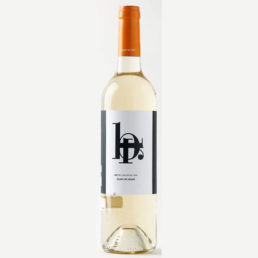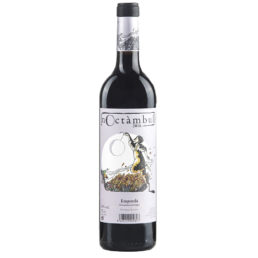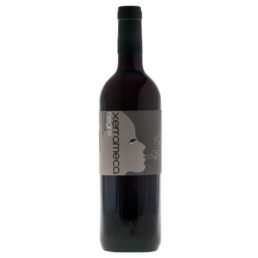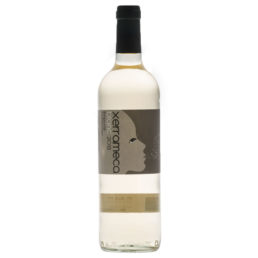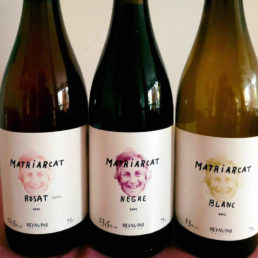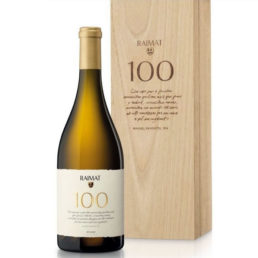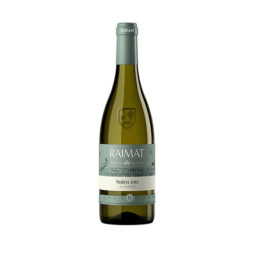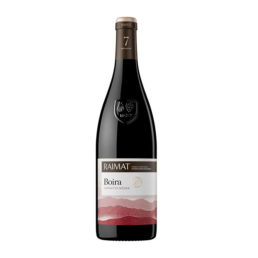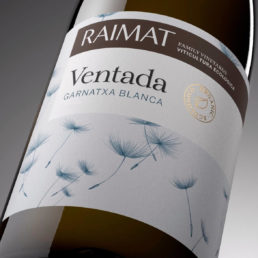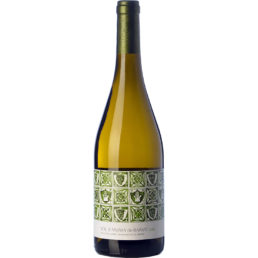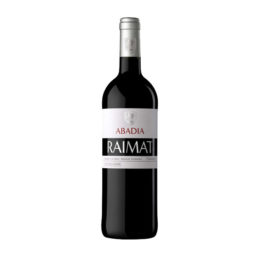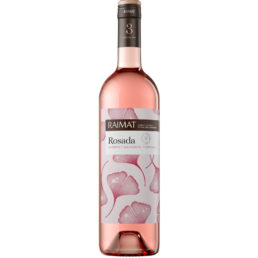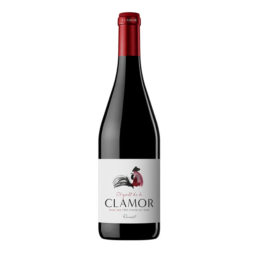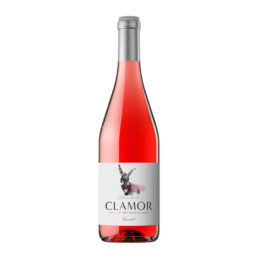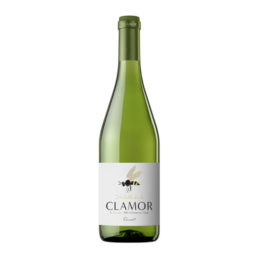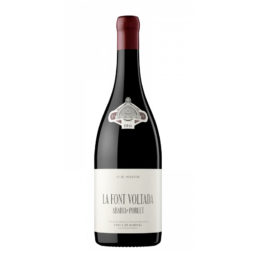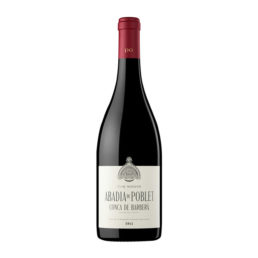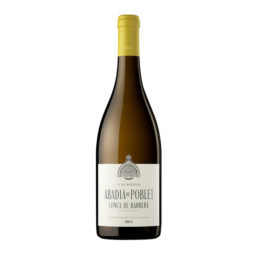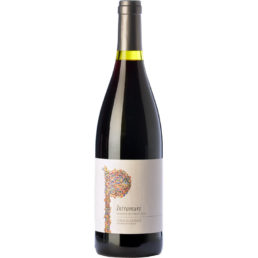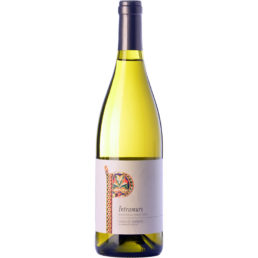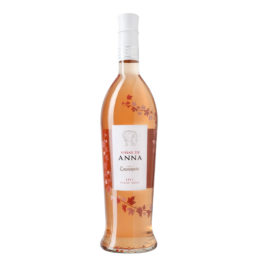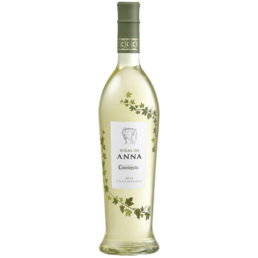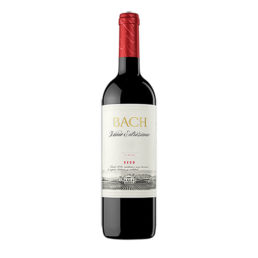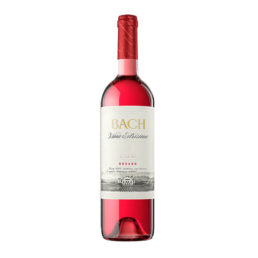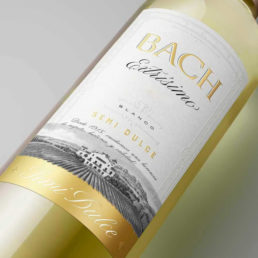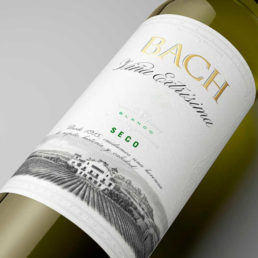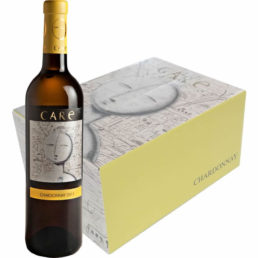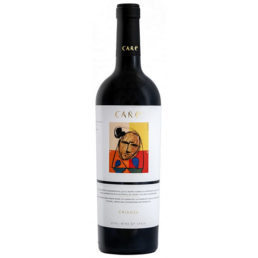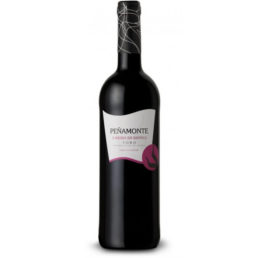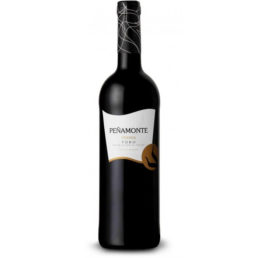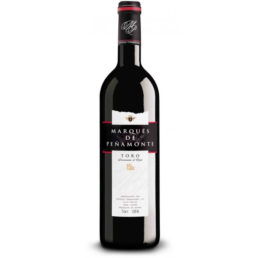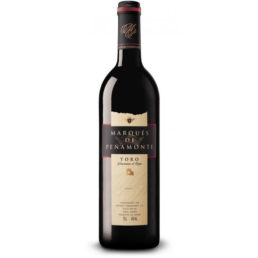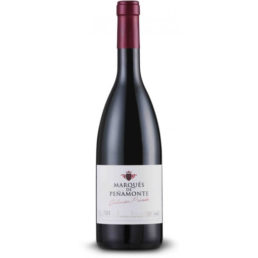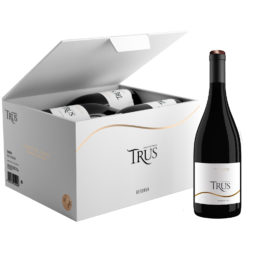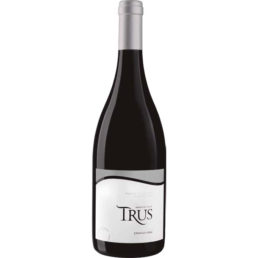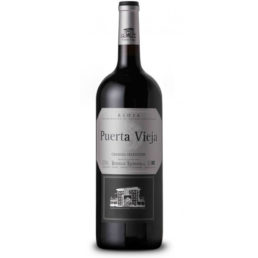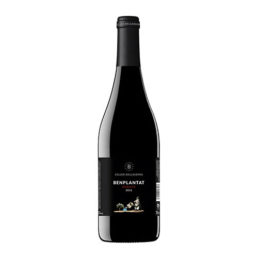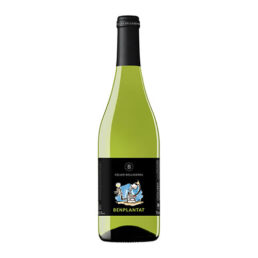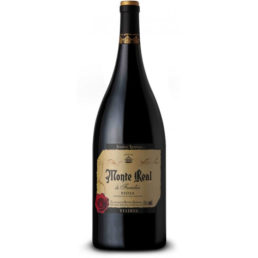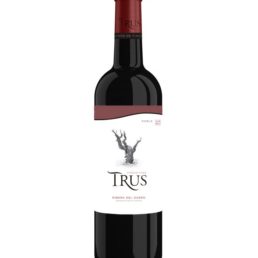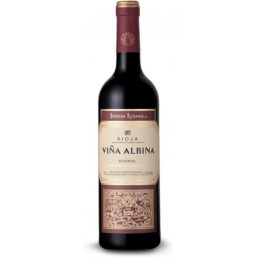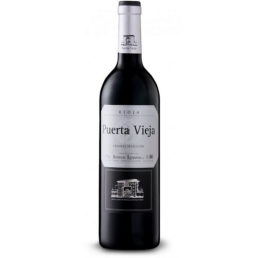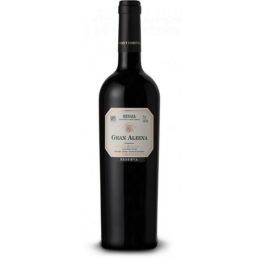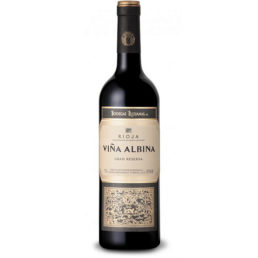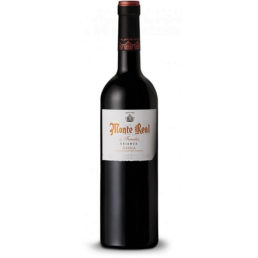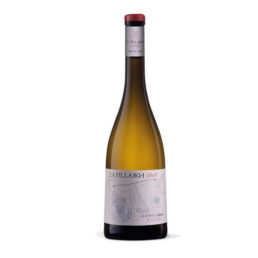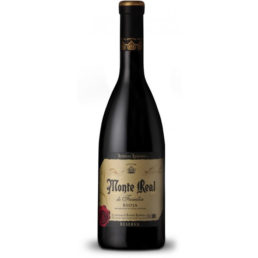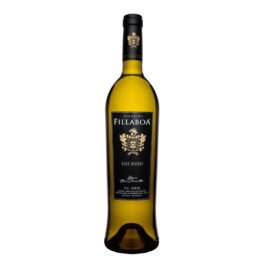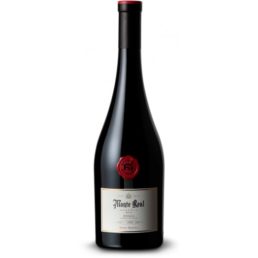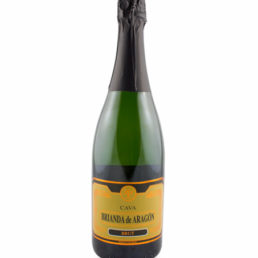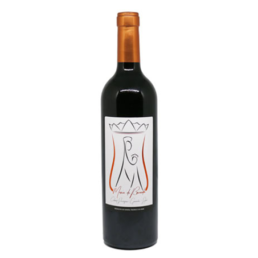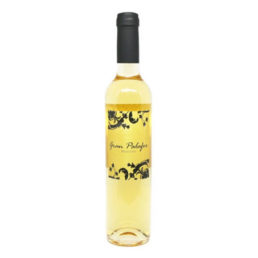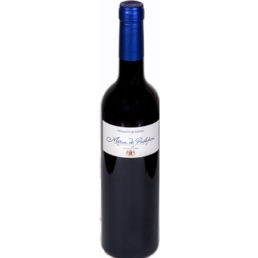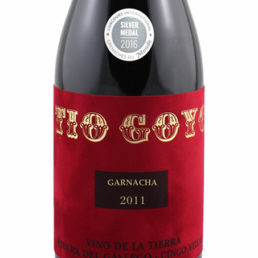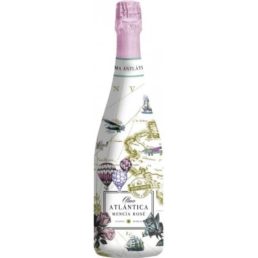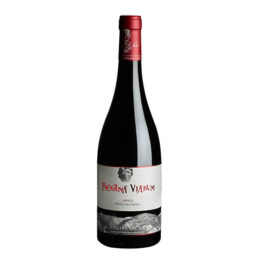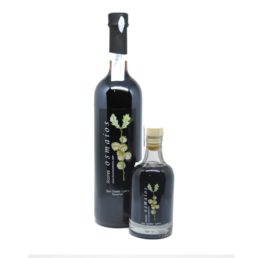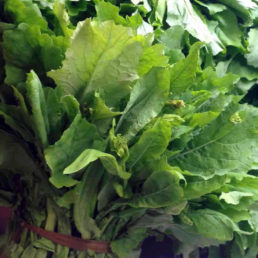Spain
-
Pink cava Grand Rosé Ars Codorníu Collection 2015
Rose Art Grand Opening
The Ars Collecta range responds to the oenological legacy of more than five centuries creating cavas in Codorníu. These are made in an artisanal way at Celler Jaume, a micro-winery where innovation, research and an exhaustive previous care of the vineyards give rise to cavas of the highest quality, expressive and guaranteed longevity. Ars Collecta Grand Rosé Gran Reserva has a unique blend of the varieties: Pinot Noir, trepat and xarel lo. At the international Bacchus competition 2020 was awarded a Gold Medal. You already have one more excuse to toast with this excellent rosé cava. -
Vega Sicilia Only 2011
Vega Sicilia Only 2011 *
Of the nearly 1.000 acres that comprise the estate Vega Sicilia, 210 they are devoted to the cultivation of the vine, coexist 19 types of soils, divided for their management in 52 lots of different and very specific. In the formation of these soils has been a vital influence in the course of the river Duero and the passage of time. 40 of these hectares are used to produce Unique. A farm unique and magical, which combined with superb handling of the vineyard, allows the elaboration of wines mythical. The upbringing of the One is probably the longest in the world, lasting for a minimum of ten years between wood and bottle. Wood French and american, barrels 225 litres new and used, tinos of 20.000 liters... A long and complex process for a legendary wine. Unico is a wine for eternity. The extraordinary ability of aging that shows the wine can only be find in some terroirs of the world. Wine of inimitable style and mature, where the process of ageing gives rise to the mysticism of the essence. Maximum 2 bottles per customer * Check vintage availability before buying -
Vega Sicilia Only 2005
Vega Sicilia Only 2005 *
Of the nearly 1.000 acres that comprise the estate Vega Sicilia, 210 they are devoted to the cultivation of the vine, coexist 19 types of soils, divided for their management in 52 lots of different and very specific. In the formation of these soils has been a vital influence in the course of the river Duero and the passage of time. 40 of these hectares are used to produce Unique. A farm unique and magical, which combined with superb handling of the vineyard, allows the elaboration of wines mythical. The upbringing of the One is probably the longest in the world, lasting for a minimum of ten years between wood and bottle. Wood French and american, barrels 225 litres new and used, tinos of 20.000 liters... A long and complex process for a legendary wine. Unico is a wine for eternity. The extraordinary ability of aging that shows the wine can only be find in some terroirs of the world. Wine of inimitable style and mature, where the process of ageing gives rise to the mysticism of the essence. * Check vintage availability before buying -
Pingus wine 2018
Pingus 2018, red wine made by Dominio de Pingus from the Ribera del Duero area (Spain) Dominio de Pingus is a small winery located at 30 kilometers from Roa, in the D. O. Ribera del Douro. In it the precious wines of Peter Sisseck are made, where for its artisanal elaboration and its low productions, allows them to strive for the high quality of the final product. -
Pingus wine 2017
Pingus 2017, red wine made by Dominio de Pingus from the Ribera del Duero area (Spain) -
Pingus wine 2016
Pingus 2016, red wine made by Dominio de Pingus from the Ribera del Duero area (Spain) -
Wine Flor de Pingus 2018
The Flower of Pingus 2018 It is the second wine from the Dominio de Pingus winery and it is one of the most successful, a benchmark among the wines of the Ribera del Duero appellation. Flor de Pingus has achieved very good results in the latest edition of the Peñín Guide, standing thus on the podium of the best Spanish wines. Peter Sisseck, the famed winemaker Danish settled in the Ribera del Duero, get add after add outstanding scores for their wines. -
White wine – Petit Bernat 2018
White Wine Petit Bernat 2018 Production: 24.267 bottles Wine:Pressing, clarification, fermentation and rearing on mothers. Cold maceration before pressing. Alcoholic fermentation of 21 days at 16ºC.Oller del Mas is part of the Denomination of Origin Pla de Bages, a privileged area, surrounded by mountains like Montserrat, or the Parc Natural de Sant Llorenç del Munt i l'obac. -
White wine Raimat Castell Chardonnay
Chardonnay is the varietal emblematic of Raimat. Crafted from the years 70, Chardonnay Raimat offers white wines, very aromatic, complex, fresh and fruity. Raimat Castell is the dream of a visionary, and his castle is the memory. A shield engraved in stone, found over one hundred years ago on the entry door shows a bunch of grapes and a hand. This symbol became the origin of the name Raimat (“Raïm”, grapes in Catalan, and “mà”, hand) and in the image of the brand. With Raimat Castell, we commemorate the origins of Raimat who endure with steadfastness as the walls of his castle. DEVELOPMENT (VINIFICATION)The Chardonnay is gathered in three phases: the first with a potential alcohol of the 12% (to get the citrus flavors), the second with 13% (tropical flavors) and the third time with potential alcohol of 14% (flavors of ripe apricots). The grape arrives during the night, fact that allows it to reach low temperatures, to preserve the aromas of the variety and avoid oxidation of unwanted. Is performed a pressing immediate, to then make a natural clarification at low temperatures during 24-48h. Once clean, the wort, is decanted into a stainless steel tank with cooling system for performing a controlled fermentation between 16-18 ºC. After the alcoholic fermentation, the wines are preserved in tanks, avoiding oxidation, until the time of bottling. Thanks to the possibility of being able to harvest in a step-like manner, you get different styles of Chardonnay. The blend consists in mixing these styles to give complexity to this wine white, without straying from the initial goal: to maintain the expression of the fruit and the freshness.PAIRINGRaimat Castell Chardonnay is the perfect complement to dishes containing white meat, fish, shellfish, rice, folders, and salads.PRIZES ADD 2017GOLD MEDAL MUNDUS VINI - 2018 -
White wine Raimat Solana
Raimat has a continental climate with very strong and contrasted: it's very hot during the day and the evenings are very cool. This phenomenon gives the grapes a very intense. Therefore, the sun bathes the vineyards of Raimat is one of the principales the protagonists of our farm and Raimat Solana, a white wine smooth and creamy, with floral notes and white fruit, it represents.DEVELOPMENT (VINIFICATION)The grape harvest is during the night; fact that allows it to reach low temperatures, to avoid oxidation unwanted.After pressing, the wort passes through a heat exchanger of cold to get a temperature lower than 10 C to make a clarification of static and at the same time preserve the primary aromas. The must clean is decanted into a stainless steel tank with cooling system for performing a controlled fermentation to 16 ºC during 2 the 3 weeks. After the alcoholic fermentation, trasegamos wines (always with carbon dioxide gas in the tanks to prevent oxidation). The two varieties of grapes D. O. Costers del Segre are vinified separately. Once the fermentation and clarified wines, we proceed to develop the blend.PAIRINGRaimat Solana is the perfect complement to dishes with birds, as chicken or turkey. Also with fresh salads, fish of all kinds, shellfish, rice and pasta.PRIZES ADD 2016SILVER MEDALMUNDUS VINI - 2017 -
Machoman MMM (Magnum) 2019
From unique vineyards of Monastrell del Paraje de La Raja, in the Murcian highlands. The add 2018 Macho Man Monastrell appears mature, complex, elegant. With a garnet red color. On the nose, the balsamic and minty notes stand out along with those of ripe red fruits (plum, you must) and memories of liquorice and toasted almonds. Scents that reflect the terrain, with the hues of scrubland (rosemary, thyme, lavender) well integrated. In the mouth it shows a wonderful freshness and elegance with that balanced step and a finish typical of great wines. -
Vega Sicilia Unique Special Reserve 2020
Vega Sicilia Unique Special Reserve 2020
It is the red that has no vintage, the tribute to tradition, with this wine, the winery wishes to continue a very old Spanish custom and also combine the balance between vintages. Traditionally, in Spain, the very few wineries that had a bottling process produced two types of wines in each vintage: the current year and another wine without a specific vintage, what they called "Special reserve". It was a mixture of wines from the best vintages from which the most representative wine of the winery was released.. The Reserva Especial is the wine with the most personality, combines the complexity of the Unique by multiplying it over several vintages and offers us an immense aromatic range, pure elegance in an eternal flow through the magic of a myth. Only the best Únicos are used to produce Special Reserve, a mixture of years, virtues, experiences and feelings that only outline the deepest essence of a unique and unique style, the Vega Sicilia style * Check vintage availability before buying -
Vega Sicilia Unique Special Reserve 2019
Vega Sicilia Unique Special Reserve 2019
It is the red that has no vintage, the tribute to tradition, with this wine, the winery wishes to continue a very old Spanish custom and also combine the balance between vintages. Traditionally, in Spain, the very few wineries that had a bottling process produced two types of wines in each vintage: the current year and another wine without a specific vintage, what they called "Special reserve". It was a mixture of wines from the best vintages from which the most representative wine of the winery was released.. The Reserva Especial is the wine with the most personality, combines the complexity of the Unique by multiplying it over several vintages and offers us an immense aromatic range, pure elegance in an eternal flow through the magic of a myth. Only the best Únicos are used to produce Special Reserve, a mixture of years, virtues, experiences and feelings that only outline the deepest essence of a unique and unique style, the Vega Sicilia style * Check vintage availability before buying -
Vega Sicilia Only 2005 3L
Vega Sicilia Only 2005 3L *
Of the nearly 1.000 acres that comprise the estate Vega Sicilia, 210 they are devoted to the cultivation of the vine, coexist 19 types of soils, divided for their management in 52 lots of different and very specific. In the formation of these soils has been a vital influence in the course of the river Duero and the passage of time. 40 of these hectares are used to produce Unique. A farm unique and magical, which combined with superb handling of the vineyard, allows the elaboration of wines mythical. The upbringing of the One is probably the longest in the world, lasting for a minimum of ten years between wood and bottle. Wood French and american, barrels 225 litres new and used, tinos of 20.000 liters... A long and complex process for a legendary wine. Unico is a wine for eternity. The extraordinary ability of aging that shows the wine can only be find in some terroirs of the world. Wine of inimitable style and mature, where the process of ageing gives rise to the mysticism of the essence. * Check vintage availability before buying -
Wine Vega Sicilia Valbuena 5th Year 2015 3L
Vega Sicilia Valbuena 5º 2015 3L
Of the nearly 1.000 acres that comprise the estate Vega Sicilia, 210 they are devoted to the cultivation of the vine, coexist 19 types of soils, divided for their management in 52 lots of different and very specific. In the formation of these soils has been a vital influence in the course of the river Douro and the passage of time. 140 of these hectares are used to produce Valbuena 5th year. A farm unique and magical, which combined with superb handling of the vineyard, allows the elaboration of wines mythical. Valbuena is the purest expression of the wine Vega Sicilia, with a foster, between wood and bottle, reaches a length of five years, that gives the name to the wine: Valbuena 5º. Wood French and american, barrels 225 litres new and used, tinos of 20.000 liters... A long and complex process for a great wine. Valbuena always gives the face, full, elegant and serious. This is a wine that always conquers. Year opulent, concentrate, impetuous and, certainly, with a great tour. -
Wine Vega Sicilia Valbuena 5th Year 2013
Vega Sicilia Valbuena 5º 2013
Of the nearly 1.000 acres that comprise the estate Vega Sicilia, 210 they are devoted to the cultivation of the vine, coexist 19 types of soils, divided for their management in 52 lots of different and very specific. In the formation of these soils has been a vital influence in the course of the river Douro and the passage of time. 140 of these hectares are used to produce Valbuena 5th year. A farm unique and magical, which combined with superb handling of the vineyard, allows the elaboration of wines mythical. Valbuena is the purest expression of the wine Vega Sicilia, with a foster, between wood and bottle, reaches a length of five years, that gives the name to the wine: Valbuena 5º. Wood French and american, barrels 225 litres new and used, tinos of 20.000 liters... A long and complex process for a great wine. Valbuena always gives the face, full, elegant and serious. This is a wine that always conquers. Year opulent, concentrate, impetuous and, certainly, with a great tour. -
Vega Sicilia Only 2010
Vega Sicilia Only 2010*
Of the nearly 1.000 acres that comprise the estate Vega Sicilia, 210 they are devoted to the cultivation of the vine, coexist 19 types of soils, divided for their management in 52 lots of different and very specific. In the formation of these soils has been a vital influence in the course of the river Duero and the passage of time. 40 of these hectares are used to produce Unique. A farm unique and magical, which combined with superb handling of the vineyard, allows the elaboration of wines mythical. The upbringing of the One is probably the longest in the world, lasting for a minimum of ten years between wood and bottle. Wood French and american, barrels 225 litres new and used, tinos of 20.000 liters... A long and complex process for a legendary wine. Unico is a wine for eternity. The extraordinary ability of aging that shows the wine can only be find in some terroirs of the world. Wine of inimitable style and mature, where the process of ageing gives rise to the mysticism of the essence. * Check vintage availability before buying -
Vega Sicilia Only 2009
Vega Sicilia Only 2009 *
Of the nearly 1.000 acres that comprise the estate Vega Sicilia, 210 they are devoted to the cultivation of the vine, coexist 19 types of soils, divided for their management in 52 lots of different and very specific. In the formation of these soils has been a vital influence in the course of the river Duero and the passage of time. 40 of these hectares are used to produce Unique. A farm unique and magical, which combined with superb handling of the vineyard, allows the elaboration of wines mythical. The upbringing of the One is probably the longest in the world, lasting for a minimum of ten years between wood and bottle. Wood French and american, barrels 225 litres new and used, tinos of 20.000 liters... A long and complex process for a legendary wine. Unico is a wine for eternity. The extraordinary ability of aging that shows the wine can only be find in some terroirs of the world. Wine of inimitable style and mature, where the process of ageing gives rise to the mysticism of the essence. * Check vintage availability before buying -
Vega Sicilia Magnum Single 2008
Vega Sicilia Magnum Single *
Of the nearly 1.000 acres that comprise the estate Vega Sicilia, 210 they are devoted to the cultivation of the vine, coexist 19 types of soils, divided for their management in 52 lots of different and very specific. In the formation of these soils has been a vital influence in the course of the river Duero and the passage of time. 40 of these hectares are used to produce Unique. A farm unique and magical, which combined with superb handling of the vineyard, allows the elaboration of wines mythical. The upbringing of the One is probably the longest in the world, lasting for a minimum of ten years between wood and bottle. Wood French and american, barrels 225 litres new and used, tinos of 20.000 liters... A long and complex process for a legendary wine. Unico is a wine for eternity. The extraordinary ability of aging that shows the wine can only be find in some terroirs of the world. Wine of inimitable style and mature, where the process of ageing gives rise to the mysticism of the essence. * Check vintage availability before buying -
Vega Sicilia Magnum Single 2007
Vega Sicilia Magnum Single *
Of the nearly 1.000 acres that comprise the estate Vega Sicilia, 210 they are devoted to the cultivation of the vine, coexist 19 types of soils, divided for their management in 52 lots of different and very specific. In the formation of these soils has been a vital influence in the course of the river Duero and the passage of time. 40 of these hectares are used to produce Unique. A farm unique and magical, which combined with superb handling of the vineyard, allows the elaboration of wines mythical. The upbringing of the One is probably the longest in the world, lasting for a minimum of ten years between wood and bottle. Wood French and american, barrels 225 litres new and used, tinos of 20.000 liters... A long and complex process for a legendary wine. Unico is a wine for eternity. The extraordinary ability of aging that shows the wine can only be find in some terroirs of the world. Wine of inimitable style and mature, where the process of ageing gives rise to the mysticism of the essence. * Check vintage availability before buying -
Vega Sicilia Magnum Single 2004
Vega Sicilia Magnum Single *
Of the nearly 1.000 acres that comprise the estate Vega Sicilia, 210 they are devoted to the cultivation of the vine, coexist 19 types of soils, divided for their management in 52 lots of different and very specific. In the formation of these soils has been a vital influence in the course of the river Duero and the passage of time. 40 of these hectares are used to produce Unique. A farm unique and magical, which combined with superb handling of the vineyard, allows the elaboration of wines mythical. The upbringing of the One is probably the longest in the world, lasting for a minimum of ten years between wood and bottle. Wood French and american, barrels 225 litres new and used, tinos of 20.000 liters... A long and complex process for a legendary wine. Unico is a wine for eternity. The extraordinary ability of aging that shows the wine can only be find in some terroirs of the world. Wine of inimitable style and mature, where the process of ageing gives rise to the mysticism of the essence. * Check vintage availability before buying -
Vega Sicilia Magnum Single 2005
Vega Sicilia Magnum Single *
Of the nearly 1.000 acres that comprise the estate Vega Sicilia, 210 they are devoted to the cultivation of the vine, coexist 19 types of soils, divided for their management in 52 lots of different and very specific. In the formation of these soils has been a vital influence in the course of the river Duero and the passage of time. 40 of these hectares are used to produce Unique. A farm unique and magical, which combined with superb handling of the vineyard, allows the elaboration of wines mythical. The upbringing of the One is probably the longest in the world, lasting for a minimum of ten years between wood and bottle. Wood French and american, barrels 225 litres new and used, tinos of 20.000 liters... A long and complex process for a legendary wine. Unico is a wine for eternity. The extraordinary ability of aging that shows the wine can only be find in some terroirs of the world. Wine of inimitable style and mature, where the process of ageing gives rise to the mysticism of the essence. * Check vintage availability before buying -
Sembro Magnum tinted wine
It is a wine with a fruity character, that tries to express the primary characteristics of the Tempranillo variety from our own Farm. It is reinforced with a small step-by-wood is usually the 4 months. It is a fruity wine, sweet and juicy in the mouth, but at the same time cool, with a few sweet tannins, mature and that make it very nice, envelope and without hardness tannic.Foster
4 months in new barrels and one year French oak 300 liters.
Fermentation
During 10 days at temperatures of 25 ° C.
Time of Maceration
7 days with their skins
-
Red wine Celler Germans Balart – The black ax raised by Magnum
Tasting notes: CELLER GERMANS BALART - THE BLACK ADVANTAGE BREADS MAGNUM
- Nose: Balsamic Aromas, cherry, Vanilla and cocoa.
- Mouth: Powerful, silky and round
-
Luis Alegre white wine Viura About Lías 2018
Selection of grapes of viura from plots of vineyards of between 40 and 60 years old. Gentle pressing, to avoid breakage of seeds. Fermentation with controlled temperature (7-9 days). Subsequent work on the lees (inactive yeasts): soft results on these to break their cell walls to let flow the wine sugars and proteins that contain. Goal: generate a wine that is more structured and complex aromatically. Clarification and filtration lightweight. -
Albariño wine CALAZUL
Albariño wine CALAZUL- O.D.. Rias Baixas
Rectoral do Umía wineries 100% Albariño Maceration and fermentation at 18ºC during 15 days, with selected yeasts. Aged on its own fine nine-month lees by the battonage method.91 points
-
Vega Sicilia Magnum Single 2006
Vega Sicilia Magnum Single *
Of the nearly 1.000 acres that comprise the estate Vega Sicilia, 210 they are devoted to the cultivation of the vine, coexist 19 types of soils, divided for their management in 52 lots of different and very specific. In the formation of these soils has been a vital influence in the course of the river Duero and the passage of time. 40 of these hectares are used to produce Unique. A farm unique and magical, which combined with superb handling of the vineyard, allows the elaboration of wines mythical. The upbringing of the One is probably the longest in the world, lasting for a minimum of ten years between wood and bottle. Wood French and american, barrels 225 litres new and used, tinos of 20.000 liters... A long and complex process for a legendary wine. Unico is a wine for eternity. The extraordinary ability of aging that shows the wine can only be find in some terroirs of the world. Wine of inimitable style and mature, where the process of ageing gives rise to the mysticism of the essence. * Check vintage availability before buying -
Campo Viejo Red Young Wine (CVC)
"We project the aging room of the Campo Viejo winery, in dark and indirect light colors, giving priority to an atmosphere of serenity and rest. I wanted to print this same character in Campo Viejo Crianza and make a wine that is defined by two words, velvety and elegant ''. Elena Adell (Winemaker of Campo Viejo)VARIETIES: Tempranillo, Garnacha and MazueloAGING IN BARREL : 12 monthsALCOHOLIC GRADE: 13,5 % -
Coto Blanco Wine
VARIETY Viura, Verdejo, Sauvignon Blanc. DEVELOPMENT Grapes from the Rioja Alta and our vineyard, Finca Carbonera, the highest vineyard in the entire DOC Rioja (840m). Grapes are instantly cooled in an inert atmosphere, and from that moment, the entire production process is kept at a very low temperature to obtain the maximum quality and fineness of aromas. -
Erre Punto Blanco Wine
Erre Punto white wine
Eight months of aging. Fermented and aged in new French oak barrels with a meticulous and precise battonage that takes place only when the lees have been deposited at the bottom of the barrel. As a result, in Remírez de Ganuza they deliver a spectacular white with a perfect glyceric point that does not lose an iota of freshness. 91 Parker points. -
Faustino Art Chardonnay Collection wine
Clean, bright, beautiful golden yellow color typical of the variety. Tropical fruit. Background, a memory of flowers appears (lilas). Nice step. It is a wine with volume in the mouth, untuoso. It has good acidity and a point of bitterness that makes the passage through the mouth longer. Middle finish, pleasant fruit memory. Sausage frankfurt. Stewed potatoes, baked or mashed. It combines very well with most of the fish, seafood and vegetables. Fondue, goat cheese or roquefort. Pasta with basil and bechamel. White Chardonnay D.O.Ca. Rioja 75 cl. -
Faustino VII Young Red Wine
Clean, bright, cherry red with garnet evolution. Nice on the nose, hints of ripe red berries and sweet sensations due to its time in the barrel. Balanced. Cool and stylish, fruit and oak notes. Half memory. Very good with any type of meat and grilled potatoes. Fish and seafood a la marinera. Half-cured cheeses and desserts with berries. Good with rice and all kinds of pasta. Very good with beans and purees in general. -
Semi-dry Bordon White Diamond Wine
White Diamond Bordon Semi dry Elaboration The grape clusters are received in a stainless steel hopper to be later destemmed (berry and broom separation) and then ground their berries. Contact with grape skin, pulp, Pips and wort are produced in stainless steel tanks during 14 hours approximately at an average temperature of 10 ºC. After this time, the must is separated from the solid parts and ferments separately at an average temperature of 16 ºC. After part of the fermentation, it is paralyzed by cold systems in order to maintain the natural sugars that give this wine one of its peculiarities. Technical Data Sheet 90% Viura and 10% Malvasía Straw yellow with golden tones Notes of ripe fruit Smooth and unctuous -
Cune Rosé Wine
Manual harvest of Tempranillo grapes and cube in a stainless steel tank where applying low temperatures prevents fermentation initially. The must, already pinkish, is bleeding between 24 and 48 hours after incubation, when we determine which color is suitable. Fermentation takes place in the liquid phase with a controlled temperature between 16 and 18ºC to maintain the aromas and fruit that characterize this wine.Type of Wine: Pink Category: Young Harvest: 2019 Grape variety used: Tempranillo: 100% -
Rosé Coto Wine
VARIETY Tempranillo, Grenache. DEVELOPMENT Rosé made in part through the bleeding of the grape flower must in the winery and in part through film maceration and subsequent pressing. The must is clarified before fermentation. Entire process of elaboration at very low temperature. -
Melquior CF Selection wine
Always overwhelming at first approach to the cup. Fragrant memories of ripe and vintage grapes, explosion of aromas and nuances of fruit on the nose. Almost purple with purple backgrounds. Friendly entry into the mouth but with a striking character at the exit that leaves a long aftertaste of fruity sweetness. A future reserve in its purest state. Grape variety: 100% Tempranillo Elaboration: Pre-fermentation cold maceration of 2 from 3 days. Fermentation during 2 to 3 weeks, at a temperature always below 28 ºC, seeking to preserve the fruitiness of the grape. Malolactic during the month of December. Recommended Service Temperature: Very important to serve between 9º-12ºC -
Ramón Bilbao Lalomba Rosé Wine
What moves us on our journey is the desire to go further and discover new landscapes. When you see it, you know instantly. A dream place, able to give life to new sensations and make the world fall in love. Lalomba is our dream come true, our whim, our jewel. VARIETY: 90% Grenache 10% Viura ELABORATION: Manual harvesting of bunches in small boxes 12 Kg. That were refrigerated and transported to the warehouse where they remained in a cold environment for 12 hours. They then went through the optical selection table, obtaining the best selection of some shelled grapes, "berries" whole and in perfect condition. Then they were brought to the press, where in an inert and cold environment, the pressing process started, obtaining only the flower must. It remains in the stable process for 3 days with all its lees. after this time it is racked by gravity. After 24 h of decantation the clean must is racked in the absence of air, to initiate alcoholic fermentation in concrete tanks where the evolution of temperature will be controlled throughout the process, once the sugars are consumed, the wine will be in contact with its fine lees for 4 months. -
Faustino Art Collection Rosé Wine
Clean, bright, pretty pale pink salmon. Pink Grenache D.O.Ca. Rioja 75 cl. -
Marqués de Riscal Rosé Wine
Marqués de Riscal begins the production of rosé wines in the years 60, coinciding with the centenary of the winery, made from grapes from young vines, less than 15 years old. This rosé is made by the pressing procedure within a concept of classicism and refinement, achieving a delicacy, freshness and softness unusual in this type of wine. Fermentation takes place in stainless steel tanks at a controlled temperature between 14ºC and 16ºC to achieve great fruitiness. Grape variety: Grenache 85% Viura 10% Malvasia 5% degree: 14º -
Lalomba Rosé Wood Wine 3L Ramón Bilbao
Ramón Bilbao Lalomba Rosé Rosé Wood Jeroboam
The jewel of a singular place now in a larger capacity format.Lalomba is the exciting story of a search.
The charm of a set of charismatic vines. The commitment of a brave viticulture. The excellence of sophisticated elaboration. The vision of a brand inspired by nature and history, The space and time, sensations and knowledge. Lalomba is the definition of the purity of a great wine. -
Lalomba Rosé Wine Ramón Bilbao 1.5L Magnum
What moves us on our journey is the desire to go further and discover new landscapes. When you see it, you know instantly. A dream place, able to give life to new sensations and make the world fall in love. Lalomba is our dream come true, our whim, our jewel. VARIETY: 90% Grenache 10% Viura ELABORATION: Manual harvesting of bunches in small boxes 12 Kg. That were refrigerated and transported to the warehouse where they remained in a cold environment for 12 hours. They then went through the optical selection table, obtaining the best selection of some shelled grapes, "berries" whole and in perfect condition. Then they were brought to the press, where in an inert and cold environment, the pressing process started, obtaining only the flower must. It remains in the stable process for 3 days with all its lees. after this time it is racked by gravity. After 24 h of decantation the clean must is racked in the absence of air, to initiate alcoholic fermentation in concrete tanks where the evolution of temperature will be controlled throughout the process, once the sugars are consumed, the wine will be in contact with its fine lees for 4 months. -
Lopez de Haro Tempranillo Wine
The full potential of Tempranillo Varietal: 100% Tempranillo. Foster: 6 months in new barrels. Vintage: Manual harvest during the second and third week of October. Vineyard: Selection of old vineyards from 50 and 70 years old, located in San Vicente de la Sonsierra. degree: 13,5% Flight -
Marqués de Cáceres White Wine
Marqués de Cáceres is a leader in the production and marketing of Rioja whites. Viura is the indigenous variety and most widespread in the region and its versatility allows it to offer fresh and fruity wines. Grape variety: 100% Viura Graduation: 12,5% -
Marqués de Cáceres Rosé Wine
The pink, Made exclusively with red Tempranillo grapes due to bleeding (shorter stay with the skins), It is one of the traditional wines of Marqués de Cáceres with an extensive catalog of pairings. TYPES OF GRAPE: 96% Tempranillo, 4%Grenache ink Graduation: 13,5% -
Albariño Marqués de Frías D.O.. Rias Baixas
Conservation conditions Store in a cool place, somber (low light) and at a temperature below 10 degrees celsius Alcohol percentage 13.00% Marqués de Frías albariño white wine with DO Rías Baixas from Galician wineries -
Red wine, Scala Dei Garnatxa
Vineyards planted on terraces and the typical "Costers" slate of Priorat, between the ages of 15 and 25 years located in altitudes ranging from 500 until the 800 meters above sea level.DEVELOPMENT (VINIFICATION)The development of the Grenache Scala Dei is done in small open vessels, by groupage of grapes homogeneously mature. Once the fermentation and using wine-tasting decides the moment of pressing. Once developed, the wine remains 6 to 8 months in stainless steel tanks until its bottling.VINEYARD (VITICULTURE)This red wine is nourished mainly from the following vineyards: Maset, Stop, Closos, Escorial and Forsans, the D. O. Q. Priorat. Specifically, we look for grapes with a high acidity, a concentration of fresh fruit without sobremaduraciones tannin and a live but mature. It is a wine based on the Grenache. This wine aims to basically three things: freshness, fruit and simplicity. -
Blaneo Chardonnay white wine 2019
NEW BLANEO CHARDONNAY 2019
Older, more complex, more exclusive. Limited production 1500 bottles. the elaboration has been, manually collected, the grape goes to the press after being de-stemmed. The must undergoes a natural racking in a steel tank and the following day it is transferred to new French oak barrels from 500 liters for the development of alcoholic fermentation. It's hard 25 days, after which, it is racked and reared in the same barrels with its lees, con batonnages regulares, during 6 months. In the month of February, after gentle clarification, happens to be bottled. -
Red Wine Guarda from LEDA Selección
Boxed Guarda de Leda is a signature wine, which is only made in certain vintages, only in those that are excellent. It has an aging of 30 months in barrels of French and american oak. Guarda de Leda is the premium wine of Bodegas Leda. It comes from the oldest plots that this winery cares for in the Ribera del Duero areas, Toro and Cigales close to the 100 years old and with very low yields. The add 2015 it was characterized by a soft spring and a long, warm summer that lasted until November. This allowed a long and full maturation in both sugars and phenolic compounds.. The harvest, after a manual harvest, boxes 12 kilos and triple selection of grapes, it was excellent. The maceration was very long reaching 25 days. All this has allowed a wine of aging with good balance., intensity in color and high tannic potential. -
Erre Punto Red Wine
Young wine made with the tips of the clusters that we select for our reserves. In this wine, the most innovative grape selection methods are combined with the traditional carbonic maceration method typical of the Rioja Alavesa.. Wine type: Carbonic Maceration Red OD: Rioja Varieties: 85% Tempranillo, 5% Grenache, 10% Viura & Malvasia. Alcoholic strength: 13,5% Elaboration: Nose boxes 12 kg of grapes from vineyards of 60 middle years. Controlled temperature prior to fermentation in cold rooms specially designed for this during a period of 24 hours (4-6 degrees). Selection of grapes on the table and separation of shoulders and ends. This wine is made from the tips of the clusters selected for Remírez de Ganuza by the traditional carbonic maceration method.. -
Baron de Ley White Wine
Vineyard: Made with Viura and Malvasía varieties. Grapes from vineyards located at high altitude and with an Atlantic-influenced climate that provide optimal conditions for making fresh whites with elegant acidity. -
Berberana Red Silver Letter Wine
- Wine from the Land of Castilla
- Grape varieties: Tempranillo
-
Artadi Tradition Red Wine 2019 Tempranillo
Artadi tempranillo
Aging Red Wine, 12 months in French oak barrels,14,3% flight -
Ángeles de Amaren wine
Amaren is "the mother's wine" and this exceptional wine bears his name, Angels. The best way to honor it has been to make a wine with grapes from the vineyards that represent the essence of our area..VARIETY 85% Tempranillo, 15% Graciano. Age of the vineyard: over 40 years old.DEVELOPMENT The wines of the Tempranillo and Graciano varieties, have been made and bred separately, managing to preserve the Tempranillo fruit and enhance the complexity of the Graciano with its spicy character.ALCOHOLIC GRADE 14ºAGING Has remained 16 months in new barrels. Oak type: 50% French, 50% American. -
Viña Tondonia Reserva Red 2008
Characteristics of the harvest: Year rated as EXCELLENT by the Rioja Regulatory Council. The absence of frost in spring and the good environmental conditions that were conducive to the fertilization and the ripening of the grapes and offset the harmful effects of pests that attack the buds at the time of bud break and bud burst–, made to produce an abundant harvest. Despite suffering a summer unstable and stormy, this large quantity of harvest achieved high levels of quality thanks to the optimal climatic conditions of a month of October, bright and fresh, that enabled us to carry out the work of vintage and convenient way to staggered, encubando each of the varieties in their point of seasoning, mature and balanced without putting in danger at any time, the perfect sanitary state of the grapes. The work of grape harvest began on the Viña tondonia estate of the day 11 October. Aging in oak barrels: 6 years old, subject to 2 rackings per year. Clarified with whites of fresh eggs. Limited production: 35.000 bottles. Pairing: cooked fish, fried or grilled, spicy. Seafood cooked a la plancha. White meats with sauces consistent. -
La Tortuga Veloz 2019 – Blanco Verdejo
Description: White wine 100% Verdejo boxes 6 units The vintage offers a green olive, marked by a very aromatic add, we find something more tropical feeling more tropical. Without losing the essence of Verdejo . Funds almonds and ripe fruit. His work with the lees for 120 days is appearing,providing a pleasant texture and balanced with a great freshness. Final with a pleasant and bitter varietal that gives us depth in wine -
Champagne Pommery Brut Royal
Pommery Brut Royal it is vivacity, aromas of white fruits combined with small red fruits. A mixture in a champagne that emphasizes the Chardonnay grape, from 40 selected villages of the areas Côte des Blancs and Montagne de Reims, cuyo weather contributes to the liveliness and delicacy of the variety. DEVELOPMENT (VINIFICATION) The initial fermentation is maintained at a low temperature (16 ºC). Foaming is particularly slow in the wine cellar to 30 meters of depth and at very low temperature (10 ºC) to allow the formation of the bubbles, fine and elegant. In consistency with the style Pommery, the wine passes through different clarified and meticulous decantation to separate the lees of the wine. The liquor dosage, prepared only with white wines Grands Crus, it incorporates all the properties of the different wines that make up the blend of this champagne.PAIRINGPommery Brut Royal can be enjoyed at any time of the day or night. -
Cava Codorníu – Jaume Codorníu Magnum
Cava brut Magnum Jaume Codorníu is a unique edition for quality cuisine. The vivacity, the freshness and fruitiness of the wine cellars Chardonnay of Anna is enriched with a nurturing of cava reserva, namely, of more than 15 monthss, that makes it the perfect accompaniment for our cuisine. DEVELOPMENT (VINIFICATION) We plan the optimum moment for harvest for each variety used in Anna de Codorníu Blanc de Blancs Reserve. After de-stemming and pressing of the grapes, we obtain the musts,which ferment at a temperature of between 15 C and 17 ºC. Once you have completed all the fermentation and stabilized the wine, performed the assembly and subsequent retractions following the traditional method, known as "method champenoise". The bottles pass to the underground cellars (at a temperature lower than 17 ºC) where takes place the second fermentation followed by a period of ageing. En total, the wine will spend a minimum of 15 months in the cellars, after which takes place the removed (decanting of the bottles to facilitate agglutination and subsequent elimination of sediment) and the disgorgement, time to remove the lees deposited after the second fermentation.Subsequently it is added to a quantity of expedition liqueur that determines the content of residual sugars of this cava brut. Finally, cover the bottle and definitely with a cork stopper.VINEYARD (VITICULTURE)The grapes used for the production of Anna de Codorníu Blanc de Blancs Reserve come from two wine-making areas distinct. The variety Chardonnay comes from vineyards located in the region of more continental climate of the D. Or. Quarry, in Lleida, fact that favors an optimal concentration and gives it freshness and more capable of aging, as well as more body and greater intensity in the grape. Cropping systems follow the criteria of integrated production and are particularly adapted to the production of sparkling wine. The harvest takes place towards mid-August and is always carried out during the night, in order to keep the grapes as cool as possible and keep their aromas intact. Xarel lo varieties,The Macabeo and Parellada varieties come from vineyards selected by our teams of viticulture and oenology in the area of the Penedès, where these varieties show all its typicality: a good level of acidity, freshness and citrus aromas and floral.PAIRINGAnna de Codorníu Blanc de Blancs Reserva is a cava brut gastronomic, it is a good ally to accompany home to a menu: incoming, sautéed vegetables, Fish, seafood, meats stewed pearl, desserts... and many preparations more.AWARDS91 POINTS JAMES SUCKLING 201890 POINTS GUIDE 365 DAYS (LIVE THE WINE) 201890 POINTS GUIDE PEÑÍN 2015GOLD MEDAL BACCHUS - 2014GOLD MEDAL CINVE - 2015GOLD MEDAL EFFERVESCENTS DU MONDE - 2014GOLD MEDAL INTERNATIONAL WINE CHALLENGE - 2015SILVER MEDAL BERLINER WEIN TROPHY - 2013SILVER MEDAL CINVE - 2014SILVER MEDAL CONCOURS MONDIAL DE BRUXELLES - 2015SILVER MEDAL CONCOURS MONDIAL DE BRUXELLES - 2014SILVER MEDAL INTERNATIONAL WINE & SPIRIT COMPETITION - 2016SILVER MEDAL INTERNATIONAL WINE CHALLENGE - 2016SILVER MEDAL TASTING.COM (JERALD O KENNARD) - 2016ONE OF THE BEST 10 SPARKLING OF THE WORLD EFFERVESCENTS DU MONDE - 20142 STARS HARPERS WINE STARS - 2017 -
Cava Codorníu – Anna de Codorníu Blanc de Blancs Magnum
The cava brut Anna de Codorníu Blanc de Blancs Reserve it is a unique edition to a selected gastronomy. The vivacity, the freshness and fruitiness of the wine cellars Chardonnay of Anna is enriched with a nurturing of cava reserva, namely, of more than 15 monthss, that makes it the perfect accompaniment for our cuisine. DEVELOPMENT (VINIFICATION) We plan the optimum moment for harvest for each variety used in Anna de Codorníu Blanc de Blancs Reserve. After de-stemming and pressing of the grapes, we obtain the musts,which ferment at a temperature of between 15 C and 17 ºC. Once you have completed all the fermentation and stabilized the wine, performed the assembly and subsequent retractions following the traditional method, known as "method champenoise". The bottles pass to the underground cellars (at a temperature lower than 17 ºC) where takes place the second fermentation followed by a period of ageing. En total, the wine will spend a minimum of 15 months in the cellars, after which takes place the removed (decanting of the bottles to facilitate agglutination and subsequent elimination of sediment) and the disgorgement, time to remove the lees deposited after the second fermentation.Subsequently it is added to a quantity of expedition liqueur that determines the content of residual sugars of this cava brut. Finally, cover the bottle and definitely with a cork stopper.VINEYARD (VITICULTURE)The grapes used for the production of Anna de Codorníu Blanc de Blancs Reserve come from two wine-making areas distinct. The variety Chardonnay comes from vineyards located in the region of more continental climate of the D. Or. Quarry, in Lleida, fact that favors an optimal concentration and gives it freshness and more capable of aging, as well as more body and greater intensity in the grape. Cropping systems follow the criteria of integrated production and are particularly adapted to the production of sparkling wine. The harvest takes place towards mid-August and is always carried out during the night, in order to keep the grapes as cool as possible and keep their aromas intact. Xarel lo varieties,The Macabeo and Parellada varieties come from vineyards selected by our teams of viticulture and oenology in the area of the Penedès, where these varieties show all its typicality: a good level of acidity, freshness and citrus aromas and floral.PAIRINGAnna de Codorníu Blanc de Blancs Reserva is a cava brut gastronomic, it is a good ally to accompany home to a menu: incoming, sautéed vegetables, Fish, seafood, meats stewed pearl, desserts... and many preparations more.AWARDS91 POINTS JAMES SUCKLING 201890 POINTS GUIDE 365 DAYS (LIVE THE WINE) 201890 POINTS GUIDE PEÑÍN 2015GOLD MEDAL BACCHUS - 2014GOLD MEDAL CINVE - 2015GOLD MEDAL EFFERVESCENTS DU MONDE - 2014GOLD MEDAL INTERNATIONAL WINE CHALLENGE - 2015SILVER MEDAL BERLINER WEIN TROPHY - 2013SILVER MEDAL CINVE - 2014SILVER MEDAL CONCOURS MONDIAL DE BRUXELLES - 2015SILVER MEDAL CONCOURS MONDIAL DE BRUXELLES - 2014SILVER MEDAL INTERNATIONAL WINE & SPIRIT COMPETITION - 2016SILVER MEDAL INTERNATIONAL WINE CHALLENGE - 2016SILVER MEDAL TASTING.COM (JERALD O KENNARD) - 2016ONE OF THE BEST 10 SPARKLING OF THE WORLD EFFERVESCENTS DU MONDE - 20142 STARS HARPERS WINE STARS - 2017 -
White wine Envy Cochina Albariño Magnum
Envidia Cochina - Tête de cuvée, occurs in soils with exceptional conditions, practicing a viticulture and the process of development unique. Our vineyards have an average age of more than 30 years old, carrying more than eight out of transition to the biodynamic. Packaging: Label that mimics a “clipping” of the press of an article on the Envy with a bullet, each add, the comic book bears the title the own brand of wine, creation of Eladio Piñeiro, design and realization Jaime Asensi. The vineyards are distributed in privileged areas within the varied orography of the Val do Salnés. The harvest of the harvest of the 2016 it was during the penultimate and last week of September. After the manual picking of the grapes in the vineyard and a further selection in the winery are macerated (8-10 hours), is done foot of cuba days before to assist the spontaneous fermentation with its own yeast, “wild”, fermented at a low temperature very long. After fermentation, of all the harvest, we selected the top of the vats of that vintage with more fruity (Tête de Cuvée). Have aging on its own fine lees from 6 months (performing beating weekly 3 first few months and monthly the 3 following), the blend final is the result of the assembly with a 15 % the add above (2015) intended to Frore of Carme (which, until that time, it was aged on its fine lees with beating monthly, during 1 year, more 3 months with the lees of the vintage following (2016), more other 3 months maturing in tank of stainless steel). Bottled, on day Flower, and started its marketing in the month of June 2017. -
Red wine Grullas de Paso Magnum
In the municipality of La Hoya (Huesca),small winery Bodegas Edra made with IGP Ribera del Gallego - Cinco Villas, the wine Edra Grullas Paso, a red wine oak own vineyards located in the Pre-Pyrenees of Aragon. The blend is still a selection of Merlot, Cabernet Sauvignon, Tempranillo and Garnacha. Activities in the vineyard always develop in a respectful way with the environment, doing all the work manually without using chemicals or aggressive elements. The vineyards are surrounded by fields of legumes and alfalfa. Selected grapes are separately vinifica fermentations in stainless steel at a controlled temperature and delestages newspapers to extract maximum pigmentation and phenolic components of the skins. Red wine Edra Grullas Paso 2016 Ribera del Gallego makes raising 4 months in barrels of French and American oak which are made "batonnage" with addition of lees. the blend is made and bottled. The name of this wine, Step cranes, He wants to remember the presence in the vineyards of these migratory birds when they take a short break before resuming forces on their journey from north to south. -
Red wine César Príncipe Magnum in individual wooden box
Caesar Prince the Duke was the father of Ignacio, it seems that outside of the nobility and the really nobility had. I used to say "a long title and low pay". He was a man austere but full of values, deep values that give the roots, the work and the love for his own. He never stopped working, all the days of his life went out into the field, always pending, always in their things. Today we have this wine thanks to his work in the vineyards, to improve and maintain the vineyards, to suffer the vintages, your unconditional support. Caesar Prince is more than a brand, it is our badge and our responsibility. Make the wines your best is not enough, also have to transmit our history, our values, for the enjoyment of all and for the generations to come will get them this lesson, it will be his best legacy. Is the wine most recognized winery and one of the first wines of the Appellation of Origin Cigales in being present in the letters of the most prestigious restaurants. It is made with grapes from vineyards of between 70 and 100 years old, of the plots The Black, The Stop, The Sheepfold and The Sailboat, located on hillside with little slope. Although the vineyards there are other varieties, only be harvested for Caesar Prince the strains of the Tempranillo variety, with very low yields. The soils are composed of clay and sand in-depth, with a lot of pebbles on the surface. After 14 months of ageing in oak barrels, the result is an elegant wine, fine and subtle. Awards 93 points guide Peñín -
Red wine Caesar Prince – 13 Nicholas Magnum pitchers
He took out his pocket knife, where he lived since his father gave it as a child, and she recorded "I must 13 Nicolas pitchers' on the mud wall at the entrance of the armhole that belonged to his brother. It was the cellar of his grandparents, they remember. Debt wine was to fill the tino, fleeing oxidation, Common favors between neighbors and relatives because the survival was a matter of all. It seems that the debt is not paid off and today we take also advantage. Was honored not collect it for the many favors exchanged and honor also not delete, that said favors not forget. Also honor and remember what we do here. 13 Nicolas Cántaros It is a wine that speaks of our history, the old cellar dug into the rock on the slopes of Fuensaldaña, where Grandpa Eutychius began producing his first wines in bulk. He used the limestone walls of the cellar to bring your own accounting, the 'should' and 'have'. This wine is a tribute to his legacy, to the traditions of Fuensaldaña and Cigales. Comes a selection of Tempranillo vineyards located exclusively in Fuensaldaña and remains 8 months in oak barrels. It is a fruity wine cooler and Prince Caesar, designed to enjoy as you would grandfather, a snack with friends. Those priceless moments that gives the wine. -
Red wine Bodegas Leda – Leda Viñas Viejas Magnum
Leda Viñas Viejas it is the wine which embodies the principles of Bodegas Leda. A red wine multiterroir made from grapes from Tempranillo vines 70 and 100 years old, with low yields between 2.000 and 2.500 Kg/Ha, from two of the most emblematic areas of Castile and León: Ribera del Duero and Toro.
Leda Viñas Viejas is the flagship of the winery, with a production that varies depending on the quality of the vintage, between 2.000 and 12.000 bottles.
100% Tempranillo. Leda Viñas Viejas is a wine of guard powerful racial and, with an ageing long 18 to 24 months, depending on the vintage.
PairingMeats white or red, casseroles, soups and stews. -
Red wine Bodegas Leda – Mas by Leda Magnum 2016
Most of Leda it is the result of the integration of different payments Tempranillo, from vineyards of more 40 years old, with yields between 4.00 and 4.500 Kg/Ha.
It is a wine Multiterroir, elegant and easy to drink, that seeks to capture the essence of the area from which it comes, mostly Bull, Cigales, Valtiendas and Tudela de Duero.
It seeks to express the versatility of the tempranillo variety in the different regions around the Douro river, looking for create a wine authentic and with personality.
From selected vineyards in which it intervenes minimally, Most of Leda 2013 transmitted to the perfection that was this add, with mild temperatures and even fresh during the spring and summer, something unusual in the area. A vintage atypical that gives rise to a wine atypical, it displays fine, fresh, with great aging potential and an essence genuinely atlantic.WinemakingAfter the collection of the grape begins the process of draining, pressing and fermentation. The grape juice is macerated with the skin and seeds in large metal vats.Aging14 months in oak barrels, 90% French (Allier, Nevers and Joupillers) and 10% American.Pairing
Barbecues, tapas fusion, white meats with sauces complex. -
White wine Javier Sanz Viticulturist – Javier Sanz Verdejo Magnum
Viticulture Verdejo grapes from which the wine is produced come from our oldest vineyards in La Seca. They are the result of the personal selection of Javier Sanz. Is about 45 ha ha over 40 years of age. The floor where these vineyards is composed of a surface and subsurface pebble clayey, factors that give the wine a touch mineral. The climate is continental with very cold winters, rains during spring and autumn and summers with very high daytime temperatures and drops of up to 20ºC at night. This causes marked continentalidad grapes retain their acidity and aromatic compounds which develop during the day.Elaboration Vintage is nocturnal mechanical and is carried out with integrated despalilladora at its ripest. During the fermentation process a rigorous temperature control is followed in order to preserve the maximum flavor characteristics of this wine. Criomaceración, clarified wort gravity for one day. Fermentation at a lower temperature 15ºC; in stainless steel. slow fermentation to preserve maximum fruit aromas. Bred with its lees for months before bottling.PairingIt's great to enjoy it as an aperitif or with seafood, salted fish, ceviche, sashimi, etc. Combined with delicate flavors and slightly spicy white fish. -
Damana Crianza Magnum red wine
Production 60.000 bottles. Elaboration Destemmed and maceration at controlled temperature. Alcoholic fermentation and malolactic in stainless steel tanks at a controlled temperature. Foster He remained 12 months in French oak barrels (80%) and american (20%). -
Red wine Damana 5 2017 Magnum
Production:250.000 bottlesElaborationDestemmed and maceration at controlled temperature. Alcoholic fermentation and malolactic in stainless steel tanks at a controlled temperature.Foster:He remained 5 months in oak barrels.Awards91 points Peñin guide -
Red wine Legaris – Legaris Crianza Magnum
The total time of aging in barrels of Legaris Crianza it has been 12 months and this has been carried out in different tonelerías, half French oak and half american oak, a 25% of new barrel. The special feature of the wine red wine Legaris proceeds of the vineyard and its modern vine-growing techniques that assist in the excellent care of the grapes avoiding unnecessary treatments.DEVELOPMENT (VINIFICATION)The grape is transferred quickly to the winery to maintain its qualities. After de-stemming, the grape reaches virtually the whole of the deposits of stainless steel, drafted separately the different origins of the grapes. We do a cold pre-fermentation maceration (10 ºC) during 3-4 days in order to extract aromas and colour and then let it gradually increase the temperature. The wines start the alcoholic fermentation and natural way to express the typicality of our different terroirs of the D. Or. Ribera del Duero made with their own indigenous yeasts. Fermentation temperatures range between 26 and 28 ° c. The devatting or drawing off is performed between 14-16 days from the vatting. Parenting media in the barrel has been 12 months in bordeaux barrels, selected in a ratio of 50% French oak of fine grain and 50% american oak, in both cases, with a 20% of new barrels. In order to increase the complexity of our Legaris Crianza, in blend end of this harvest has involved a total of 22 tonelerías. This red wine has not been stabilized by cold, so that for their production of natural might present sediment. To fine-tune the wine was a soft clarification with egg white and started bottling in August 2016.VINEYARD (VITICULTURE)The grape varieties with which we have produced this wine have been Fine Red (Tempranillo) 90% and Cabernet Sauvignon 10%. In our Legaris Crianza we want to express the uniqueness and complexity of the Ribera del Duero, for which we selected different vineyards in various geographical areas: - Pesquera de Duero, Valbuena de Duero, Manzanillo, Melida and Peñafiel in the province of Valladolid, with altitudes understood between the 750 and the 880 meters, the predominant soils are lighter that give rise to wines that are more aromatic. - Roa, The Horra, Hontoria Part, Valdeande, Villalbilla de Gumiel, Fuentenebro, Boada de Roa, Moradillo de Roa, Olmedillo de Roa in the Burgos province, with altitudes understood between the 810 and the 970 meters, where the soils are clayey-calcareous, and provide structure and power to our wines. Also we count with own vineyards (93 You) in the farms of Curiel de Duero (Valladolid) and San Martín de Rubiales (Burgos), whose vineyards began to be planted in 1999 and currently follow a system of cultivation of Double Cord Royal, in which we make sustainable viticulture with plant cover. In this vintage 2014 we started to harvest the Tinto Fino the 27 of September and ended the 8 October. The Cabernet Sauvignon the same the 20 October. The first frost came during the month of October, at the end of the cycle. With regard to the temperatures, we can talk about a mild winter. At the start of the spring, the temperatures were remarkably high, this accelerated 10 days the sprouting of the vineyard. It was not until the second half of August so that the maximum temperatures were the own of this time. Although it really noticeable in terms of the temperatures of this cycle has occurred during the months of September and October, in which the temperatures were far superior to the usual, being the constant and hot sunny days, what said finally the maturation of the fruit. The rainfall of this vintage has been lower than expected.PAIRINGLegaris Crianza mariza perfectly with lamb, dishes, meat stews, semi-mature cheeses.AWARDSGOLD MEDAL MUNDUS VINI - 2017GOLD MEDAL TEMPRANILLOS TO THE WORLD - 2016 -
Chafandín Magnum red wine
It is a wine exclusively from grapes from the Payment of Chafandín, 100% Tempranillo (Tinto Fino) and whose vineyard has an approximate age of 40 years old. It is grapes of extraordinary, small diameter, with a skin of greater thickness which gives the greater concentration in the maceration. The Malolactic is done in barrel new French oak of 300 liters, and then the wine stays in ageing in the same barrels during the time that it is deemed appropriate ( according to the add ) and that is usually between 16 and 21 months.Foster
Malolactic in French oak barrels 300 liters and parenting 21 months in new barrels and one year French oak 300 liters.
Fermentation
During 12 days at a temperature of 26ºC.
Time of Maceration
17 days with their skins
-
Red wine Viñas del Jaro – Jaros Magnum
This is our Estate wine as it comes from the grapes of several payments, and shows the general nature of the set of all of them. The different wines are assembled after aging in barrel new and second year, that is usually the 15 months. The main variety used is Tempranillo, with smaller contributions of Cabernet Sauvignon and Merlot. On the nose it develops aromas of frutillos of the forest on nuances of balsamic and menthol, with spicy notes and fine woods. The palate is broad, balanced and with a persistent aftertaste very fruity and mineral character by retronasal.Foster
17 months in new barrels and one year French oak 300 liters.
Fermentation
During 12 days at a temperature of 26ºC.
Time of Maceration
14 days with their skins.
-
Sembro Magnum tinted wine
It is a wine with a fruity character, that tries to express the primary characteristics of the Tempranillo variety from our own Farm. It is reinforced with a small step-by-wood is usually the 4 months. It is a fruity wine, sweet and juicy in the mouth, but at the same time cool, with a few sweet tannins, mature and that make it very nice, envelope and without hardness tannic.Foster
4 months in new barrels and one year French oak 300 liters.
Fermentation
During 10 days at temperatures of 25 ° C.
Time of Maceration
7 days with their skins
-
US vino tinto great Murua 2017
Expressive and personal, VS it is the last blend created by Bodegas Murua. The winery continues its philosophy of Rioja purely craftsman, but looking, at the same time, a modern style that inspires a wine full of freshness and fruit undertones.
The VS de Murua is a wine that is velvety, that illustrates very well the balanced blend of the fruit of our grapes in the aroma of mount alava minty and floral.
Foster of 16 months in French oak barrels (30%) and american (70%). -
Red wine Valenciso Reserva Magnum 5L
Valenciso produces a single red wine, always booking and always elegant. Refined, sophisticated and versatile, always set according to both the palates classics such as modern about its extraordinary qualities. On the nose it shows aromas of spice and fruit, a great complexity that reaches to grow in the cup from a timid openness. Good balance between fruit and wood, with volume aromatic. PairingSticky rice with mushrooms and pork ribs, loin of iberian pork with caramelized, lentils stewed with chorizo sausage and vegetables.Awards92 points guide Parker92 points James Suckling -
Red wine Valenciso Reserva Magnum 3L
Valenciso produces a single red wine, always booking and always elegant. Refined, sophisticated and versatile, always set according to both the palates classics such as modern about its extraordinary qualities. On the nose it shows aromas of spice and fruit, a great complexity that reaches to grow in the cup from a timid openness. Good balance between fruit and wood, with volume aromatic. PairingSticky rice with mushrooms and pork ribs, loin of iberian pork with caramelized, lentils stewed with chorizo sausage and vegetables.Awards92 points guide Parker92 points James Suckling -
Red wine Valenciso Reserva 2011 Magnum
Valenciso produces a single red wine, always booking and always elegant. Refined, sophisticated and versatile, always set according to both the palates classics such as modern about its extraordinary qualities. On the nose it shows aromas of spice and fruit, a great complexity that reaches to grow in the cup from a timid openness. Good balance between fruit and wood, with volume aromatic. PairingSticky rice with mushrooms and pork ribs, loin of iberian pork with caramelized, lentils stewed with chorizo sausage and vegetables.Awards92 points guide Parker92 points James Suckling -
Red wine Bodegas Baigorri – Baigorri Reserva 2008 Magnum
Red wine elaborated with grapes of the variety Tempranillo. Only used vines are considered old, with reduced production. Macerations long in stainless steel tanks and in tinos wood. Stirred natural gravity. Malolactic fermentation and 18 months aging in new French oak barrels. Pairing Great expressiveness with game meats, roast lamb, pig, birds and dishes of high cuisine. -
Red wine Bodegas Baigorri – Baigorri Crianza Magnum 3L
Red wine elaborated with grapes of the variety Tempranillo, Grenache and other small proportions of other indigenous grapes. All have been hand-selected, using selection tables for vibration and weight. Long macerations and fermentations intercellular deposits special. 14 months aging in barrels of French and american oak. Pairing It is a wine ideal for any type of cooked, seasonal vegetables, white meat and hunting light, rice and tapas in general. -
Red wine Bodegas Baigorri – Baigorri Crianza Magnum
Red wine elaborated with grapes of the variety Tempranillo, Grenache and other small proportions of other indigenous grapes. All have been hand-selected, using selection tables for vibration and weight. Long macerations and fermentations intercellular deposits special. 14 months aging in barrels of French and american oak. Pairing It is a wine ideal for any type of cooked, seasonal vegetables, white meat and hunting light, rice and tapas in general. -
Viña Pomal Reserva Magnum
Viña Pomal Centenario was created to commemorate the 100 years of the foundation of the company Bodegas Bilbaínas. A red wine that sums up a century of the history of wine in la rioja. If with the add 2011 Viña Pomal Centenario Reserva won a Gold Medal at Mundus Vini, the harvest 2012 maintains the quality and the elegance that so much fame have been given to one of the riojas essential. DEVELOPMENT (VINIFICATION)Viña Pomal Centenario is made from a selection of parcels from our vineyards D. O. Ca. Rioja. Fermentation 28 ° C and a maceration total 3 weeks. Are breeding during 18 months in american oak barrels, a 20% new. At this time, the rackings allow us to go into clearing by natural decantation the wine. After its passage through the barrel, this red wine remains two years in bottle before release onto the market.VINEYARD (VITICULTURE)The finca Viña Pomal is made by 90 hectares of vineyard D. O. Ca. Rioja. Nestled in the municipality of Haro and less than 2 kilometres of the winery, located in one of the most beautiful areas of the city; through them we can enjoy the passage of the river Ebro through the conchas of Haro. Combine on our farm different ecosystems in function of the variability of the soil and the sun exposure, what that translates to in a comprehensive selection of homogeneous areas. The viticulture is applied arises from a mixture between traditional rioja and the precision, resulting in a growing commitment to innovation in order to protect the nature, always under the parameters of maximum quality.PAIRINGIdeal to accompany dishes such as rice with meat, grilled vegetables, cold cuts and cured cheeses. -
Red wine – Viña Pomal Centenario Crianza Magnum
Viña Pomal Centenario Crianza is a wine special, commemorative of the centenary of the brand. A perfect balance between the classic nature of a red crianza from Rioja, and a presence of fruit more noticeable. DEVELOPMENT (VINIFICATION)Viña Pomal Centenario Crianza is characterized by a vinification traditional: after de-stemming and crushing takes place the alcoholic fermentation. Maceration total is two weeks, looking for a structure of wines, soft, pleasant and with great intensity of fruit. Twelve months in american oak barrels (15% new) we bring the complexity and the maturity necessary to complete the expression of this red wine Reserve.VINEYARD (VITICULTURE)The finca Viña Pomal is made by 90 hectares of vineyards. Nestled in the municipality of Haro and less than 2 kilometres of the winery, located in one of the most beautiful areas of the city; through them we can enjoy the passage of the river Ebro through the conchas of Haro. Combine on our farm D. O. Ca. Rioja the different ecosystems in function of the variability of the soil and the sun exposure, what that translates to in a comprehensive selection of homogeneous areas. The viticulture is applied arises from a mixture between traditional rioja and the precision, resulting in a growing commitment to innovation in order to protect the nature, always under the parameters of maximum quality. The work of our own vineyards, we add a demanding grape selection of our suppliers of Rioja Alta.PAIRINGViña Pomal Centenario Crianza harmonizes perfectly with light dishes such as rice dishes, cheeses, pates, stews, vegetables, fish... in addition to the typical dishes that combine traditionally with the aged red wines. -
Scala Dei Prior Magnum tinted wine
Scala Dei Prior is a wine with personality, that breathes tradition and authenticity, since that allows to know better the richness of the D. O. Q. Priorat. It is elaborated with grapes from different small plots, carefully selected. This care durantand all the processing result to a Crianza wine is well structured and full of aromas that will transport you to the vineyards of the Priorat.DEVELOPMENT (VINIFICATION)After defining the vineyards that are going to go for this wine, the grapes previously selected in the estates arrive at the winery in small boxes 16 kg, where all the grapes is reviewed thoroughly by the warehouse staff as they pass through the selection table, vibratory installed at the entrance of the winery. After de-stemming and crushing, fermented at controlled temperature to preserve the aromas of ripe fruit. Later, the breeding takes place in barrels (French oak 80% and american 20%) during a year. This type of ageing is completed in bottle for more than a year for the wine to reach the market in optimal time of consumption.VINEYARD (VITICULTURE)Grapes from varieties of historical of the area and of the vineyards older (between 35 and 60 years old), planted on the terraces and in the typical “costers” licorella from Priorat. The terrain, the driving of the plants and above all, the desire to obtain the best grapes, makes the grape harvest is done manually only. The vineyards are situated between the 500 and the 800 meters of altitude, which favours the maturation is slow and regular and enables a variety of shades to combine heights and different orientations of the vineyards. All this makes this wine unique.AWARDS94 POINTS GUÍA GOURMETS 201890 POINTS GUIDE PEÑÍN 2018GOLD MEDAL MUNDUS VINI - 201890 POINTS ROBERT PARKER 2018GOLD MEDAL EXPOVINA - 2017SILVER MEDAL BACCHUS - 2017 -
White wine Mas d'en Blei – Clos Martina Magnum
PRODUCTION 4.000 bottles.VITICULTURE Grapes are produced only of the finca Mas d'en Blei. Vineyards on terraces of slate (licorella). Vintage hand. Selection in table. Development separated by varieties.VINIFICATION Pre-maceration in cold during 24 hours. Pressing to racking to a tub where it is kept other 24h. Fermentation in new French oak barrels (Q. Petrea) of 300 liters, fine grain and medium toast light. Parenting 6 months with lees and "battonage" journal. Stabilization in cold, the natural way (seasonal), not induced. Bottled: 1 year in the bottle.
AWARDS GOLD medal INTERNATIONAL WINE CHALLENGE 2016. -
Red wine – Arnau Oller, Selection of the Magnum family
Production6.446 bottlesWinemakingFermentation of 10 days at 22 ° c with llevaduras own Farm. Maceration of 15 to 30 days with two pumping over daily. Not used press.FosterBoots new oak French d'allier, Tronçais, and Nevers of 300 litres for twelve months. Subsequent aging in bottle in the cellar for a minimum of twelve months. Natural cork stopper in the country. -
White wine Celler Credo – Aloers Magnum
It was called ‘Aloers’ to the farmers of the Middle Ages who were the owners of the land that they cultivated. The aloers were free of any provision or census.The white wine Aloers come exclusively from the family vineyards of the Pedra Blanca, located in the comarca of the Alt Penedès (Barcelona) and cultivated following the principles of organic farming and biodynamic.We work the vineyards, leaving to grow a ground cover spontaneous, important to fluff up the soil and regulate the retention and the drainage of water in a rainfed cropping as we practice.This cover is essential to promote biodiversity and balance in the ecosystem of the vineyard, where we apply treatments with medicinal plants (phytotherapy) to control the presence of fungus and strengthen the strains of a totally natural way.The grape harvest at Celler Credo is carried out by hand to ensure the excellent quality of the clusters.Aloers provides the freshest and most genuine expression of the Mediterranean variety Xarel lo grown in calcareous soils.. It is a wine of great vitality and a long journey in a bottle.Produced from the maceration for a few hours with the stalks and to work with the lees during the time of approximately a month and a half. The fermentation takes place with yeast own from the vineyards of Celler Credo.Aloers look for the maximum expression of the terroir and, therefore, you can present natural sediments the result of a minimal intervention. The vinification and the bottling are done in our property. -
White wine Flight of the soul by Raimat Magnum
Vol d Ànima, formerly known as Ànima de Raimat, it is the culmination of our first 100 years of history. The tiles that dress up your tag are the same that look in the walls of the castle of Raimat from 1935, after the reform carried out by the architect Rafael Masó. This creation represents the soul of Raimat: a young red wine, modern, fresh, medium-bodied, with notes of cocoa, developed with the 3 red varieties that best express the terroir cellar: Cabernet Sauvignon, Tempranillo and Syrah.DEVELOPMENT (VINIFICATION)It starts with a grape harvest at night to preserve the primary aromas of the fruit. When the grapes reach the cellar, is cooled to a temperature of 15 ºC. A part of the grape is vinifica looking for a profile of the wine more fruity and fresh. Is achieved by keeping the temperature low for 24-48h and fermenting later 25 ºC. The other part of the grape is fermented at a higher temperature for greater texture and complexity in the wine. These two styles came together we offer a young red wine, modern, with lots of fruit and structure in the mouth.PAIRINGVol d Ànima de Raimat Red wine can accompany well to dishes of hunting, mushrooms, meats and legumes, as well as sausages and rice. It is a wine that is very versatile. -
Red Red Wine House – enemy mine
Garnacha vineyards of the area of La Raja. Production of less than 2.000 kgs per hectare. excellent vintage 2017. Green pruning in August to adjust production to the desired concentration. Vintage during the last week of September, Manual in small boxes 12 kgs for the perfect entrance to the grape wine. slight step fudres 11.000 liters. Limited production 43.000 bottles. Two weeks after its release in April 2018 This wine was awarded the silver medal in the international 'Grenaches du Monde' competition. -
Red Red Wine House – Machoman MMM 2019
From unique vineyards of Monastrell del Paraje de La Raja, in the Murcian highlands. The add 2018 Macho Man Monastrell appears mature, complex, elegant. With a garnet red color. On the nose, the balsamic and minty notes stand out along with those of ripe red fruits (plum, you must) and memories of liquorice and toasted almonds. Scents that reflect the terrain, with the hues of scrubland (rosemary, thyme, lavender) well integrated. In the mouth it shows a wonderful freshness and elegance with that balanced step and a finish typical of great wines. -
Red Red Wine House – Maquinon
The strength of the Priory in a wine and a grape, Black Garnacha, transmitting a piece of this land, clearly defined by its terroir: the blackboard (llicorella). From vineyards over 10 years old, located in different terraces. Limited production 18.000 thousand bottles. -
Red Red Wine House – The Invisible Man
With the add 2016 we have developed the ultimate expression of Rioja Alta. The old vines we work in Fonzaleche joined the work in the field and the selection and handling of the grapes during harvest have resulted in a unique wine. Harvest during the first half of October, for optimal maturation sections, manually. Fermentation in stainless steel at a controlled temperature of 28 ° C to achieve this balance between extraction and aromatic content varietal. After malolactic fermentation tank makes a wine aged in French oak barrels sophomores 225 and 500 litres for 12 months. Add very good with great balance between acidity and alcoholic strength. Excellent phenolic maturity. Favorable evolution throughout the growing season. -
Red Red Wine House – Alexander Vs The Ham Factory
From the best vineyards of Aranda de Duero is born Alexander VS The Ham Factory. The vineyards of those from Tinto Fino grapes, Cabernet Sauvignon, Malbec and Merlot selected in the year 2015 They are located 900 meters of altitude. This marks viticulture and style of this unique Ribera del Duero. 2015 It was the year that Red House and Miguel Sanz family come together to create a great wine in Ribera del Duero. This is wine, and just 46.953 bottles 75 cl y 4.226 Magnums. Culture vessel with a planting of 2,5 meters 1. Performance 4.000 kilos per hectare ensuring greater concentration of grapes and allows the wine can age and improve in bottle over the next 10 years old. Clayey soil types calcareous. Vineyards between 25 and 30 years old, harvested earlier in the day during the second half of October. Double table grape selection before entering winery. Fermentation in stainless steel which enters by gravity grape. Crianza for about 18 months in new French oak barrels 225 liters of ANA cooperages, Seguin Moreau, Saint Martin and Saurí. Reductive aging in bottle for at least six months. -
White Wine Red House – Circus Fat
Verdejo is expressed in Castilla León. But only in Olmedo, Valladolid, are the old vines and soil suitable to provide us with this grape and these important indigenous yeasts on the lees in the development of this huge white wine. Ultimate expression of this land of fire and ice, and the character of its people. Harvest during the first week of September and the early morning hours so that the grapes from the winery with the lowest possible temperature (around 10 ° C). Once recepcionada grape maceration is done during 2-3 days and after this pressing grapes. For the preparation only yolk used and must first pressing. Fermentation in stainless steel tanks at controlled temperature of 14ºC. Subsequent transfer of heavy lees leaving only the lees and perform aging for three months, conducting weekly batonages. The final blend is subjected to a slight aging in oak. -
Red Red Wine House – Thief
From old vineyards of the DO Bierzo, located in the town of Parandones. Antonio Silva Broco vineyards with age 130 years old. Very low yield per vine, with a production of less than 5.000 kgs per hectare. Handpicked during the first hours of the day in the last half of September, boxes 20 kgs. Upon receipt in the cellar fermentation in stainless steel tanks at a controlled temperature 25 degrees. three times per day and are made open to prevent oxidation. It is a wine unfiltered and barrel aging, thus reflecting the 100% typicality of Mencia. -
White Wine Red House – The Orange Republic
Some vineyards 30 years of the plots of Villa Quinta, the most altitude Valdeorras. Production of approximately 5.500 kilos per hectare. Vintage made in the first half of September, manually and in small boxes 15 kilos. After careful selection of the fall in grape wine with a maceration three hours. Aging on fine lees (after separating the heavy lees) during 6 months, in stainless steel. It will grow in the coming years bottle. Limited production to 19.600 75 cl bottles and 200 Magna. -
Red wine Tandem – Immune
Immune Metaphorically immune to the disease, the discouragement, to defeat... is a rebel, a different type to the rest of their brothers of the range Tandem. Winemaking The grapes are harvest by hand. Fermentation partial during 10 days at a controlled temperature of 25 ° C with indigenous yeasts. Immersion of the hat with pistons pressing, We not use pumps remounted. The wine is decanted by gravity to underground reservoir concrete where it ends the alcoholic fermentation and full malolactic fermentation. The wine is kept in concrete to clarify naturally by settling. -
Red wine – Luis Alegre Crianza Magnum
Luis Alegre Crianza It born from grapes from vineyards of an average age of 30 years old. These are found on farms of soil clay and limestone to about 500 meters of altitude. Following a process of manual harvest, the beans macerated and fermented for about 15 days. Once the malolactic fermentation, Luis Alegre Crianza is transferred into American oak barrels and French. In the same is made the foster, that continues for about 14 months. The barrels are new and second -, third and fourth year. The 80% of these are of american oak and 20% remaining French oak. Luis Alegre Crianza finally rests a year in bottle before release for sale. -
Red wine – Muga Crianza 2016
Elaboration Fermentation with yeast indigenous deposits of oak. Parenting during 24 months in casks made with oak trees selected in our cooperage. Prior to bottling is carried clarification with egg white fresh. Once bottled undergo a process of fine-tuned over twelve months in our cellar, as a minimum. Pairing This is a wine that can pair with meat, veal, iberian ham and some kind of cooked. -
Vino tinto Tinto GR-174
Description of Red Wine Red GR-174
It is the expression of farms. In it involved the two terroirs, one (Casa Gran) bringing much freshness and red fruits and the other (La inviolability) with minerality, structure and black fruit. It is made with all grape varieties from the two farms: Grenache, Cabernet Sauvignon, Samsó, Syrah, Merlot and Cabernet Franc. -
Red wine Bodegas Emotion – Emotion Passion
Limited production 2.000 bottles. Elaboration Wine Passion is created in a garage and has been developed completely handmade. All the movements have been made in the winery by gravity and feeling the grapes, by being walked on, not to suffer anything to the wine, and keep all its aromas to be bottled. It is elaborated with grapes of the variety Tempranillo, from vineyards in Baños de Ebro (Álava), adjacent to Elciego (in the foothills of the Sierra de Cantabria) and also one small Laguardia. The harvest was carried out manually in boxes of grape-12kg, by stacking the clusters in only two rows, not to alter the natural conditions of the grape. Has previously been pruned to a result of 2 the 3 clusters per vine vine. In the cellar have been made bazuqueos daily, and a return to daily. After finishing the development, with the best of the best, only been out a limited production of 2.000 bottles. There have been two selection tables for inspect good grape, which was in his right point of maturation. It has been fermented for 23 days 24-25 ° C of temperature in stainless steel tanks and part in barrels/tino 1,000 l. Malolactic fermentation in barrel: The barrel aging has been a year in barrels 500 and 225 liters. You have to 13.9 º of alcohol. Pairing Emotion Passion could be the ideal companion for events and ceremonies or special meetings. Meat, Fish, pasta... Michelin StarsYou can find this wine in some restaurants with Michelin Stars. Among others, in the following restaurants:- *** Arzak. San Sebastian (Gipuzkoa)
- *** Azurmendi. Larrabetzu (Bizkaia)
- *** Martin Berasategui. Lasarte-Oria. (Gipuzkoa)
- *** Akelarre Pedro Subijana. San Sebastian (Gipuzkoa)
- *** Mugaritz. Renteria (Gipuzkoa)
- ** "El Faro del Puerto". The Port of Santa Maria (Cádiz)
- *** Etxebarri. Atxondo (Bizkaia)
- ** Echaurren. Ezcaray (Rioja)
- * Andra Mari. Galdakao. (BIzkaia)
- * Etxanobe. (Bilbao)
- * Albora. (Madrid)
- ** Ramon Freixá. (Madrid)
- ** Boroa (Amorebieta. (Bizkaia)
- ** Nerua Guggenheim. (Bilbao) Elcano (Getaria)
- ** Lasarte of Berasategi. (BCN)
- * Aizian. (Bilbao)
- * El Bohio. (Toledo)
- * La Solana. Ampuero (Cantabria)
- * Cenador de Amos. (Villaverde de Pontones (Cantabria)
- ** AbaC Jordi Cruz. (BCN)
- * Can Bosch. Cambrils (Tarragona)
- * Tatau Bistro. Huesca (Huesca)
- * Hoffman (BCN)
- * Arbore da Veira (A Coruña)
-
Red wine Luis Alegre – Finca La Reñana Special Selection Magnum 2014
GREAT WINES FROM SMALL ESTATESGrapes from the vineyard Finca La Reñana. Their limestone soils provide elegance, high minerality and depth with a high potential to save. Vintage manual boxes 15 kg. Selection table. Raised during 16 months in new oak barrels from the best forests of France with a touch of american oak, that provides structure and aromatic complexity. Rests in bottle a minimum of 18 months. AcknowledgementsGuia Vinos Gourmets 2019: 95 pointsPeñín 91Tim Atkin 90Wine Advocate/Parker 90Jancis Robinson 16.5Gourmets guide 95 -
Cava Red House – Black sheep
Villafranca del Penedes, cradle of cava, Trepat grow grapes that give rise to our cava. Loamy texture soils, in some cases somewhat chalky, with some clay content. Upon receipt of the table in the winery temperature thereof is lowered to 5 ° C for later making pressing. Use only the flower must first pressed. Fermentation about 14 ° C 25 days to preserve the maximum power of the aromatic variety. The bottle rests for a minimum of nine months in rhyme. After the disgorgement to remove sediment is added to the liquor issue. This is a cava extra brut, with only 3,5 grams per liter of sugar. And slightly pale ink asalmonado fruit variety Trepat. floral and fruity nose, with aromas of small berries. The palate surprises until the last bubble, with one step up, tasty, creamy, where blackcurrant flavors are emphasized, blackberry and pralines. Limited production 34.623 bottles. -
Vino rancio Finca Fontanals – Rancid Old Priory House Castle Montsant
In the region of Catalonia has a long tradition in wine Oxidative specifically rancid wines Grenache (we RANCIER), which traditionally they have been prepared for centuries by many families for their own consumption. -
White wine Finca Fontanals – Finca Fontanals
Elaboration:Winemaking equipment: Stainless steel / WoodRearing period: 4 monthsAge of the barrels: NewWood type: OakProduction: 500 bottles -
Vino tinto Finca Fontanals – Finca Fontanals
Elaboration: A perfect cupage where each variety gives the wine different characteristics perfectly complemented, the freshness of the Garnacha, Merlot brings softness with maturity and complexity of Syrah and Cabernet Sauvignon. Wine made from a certified organic viticulture CCPAE (Catalan Council of organic farming, corresponding certification both the farm, the vineyard, as well as the winery and the wines). From vines planted on land belonging to the family for several generations, 8 hectares of vineyards located in the municipality of Falset districito, within the DO Montsant, while limiting the Priorat DOQ, and it is composed of three different types of soils, sandy loam, Red sandstone and calcareous Llicorella. Vintage manual, fermentation with natural yeast in stainless steel 2000 liters. Parenting during 8 months of each variety separately, continuing with other 6 months after the end cupage in French oak barrels of 1st and 2nd use. -
Red wine Loxarel – EOS Loxarel (ecological)
Elaboration Viticulture, organic and biodynamics. Organically grown vines located on the highest point of the Alt Penedès, 700m above sea level. These vineyards provide well-structured wines with good rankings. Carbonic maceration getting Syrah varietal notes. Aging during 10 months in French oak barrels. Pairing Ideal with all types of meat, especially a la flavored hot, duck breast and cheeses. -
White wine, Loxarel – Gaia de Loxarel (ecological)
Elaboration
Viticulture, organic and biodynamics. Elaborated with grapes 100% ecological vineyards to 700 meters that give freshness and acidity, this wine is fermented partially in jars of clay, and in barrels of chestnut for more creaminess and density in the mouth. Gaia represents in Greek mythology the Mother Earth, the origin of life.Pairing
Fish on the grill or in the oven. Rice and pasta with fish sauce. Seafood Stew, salad a little spicy. -
White wine, Loxarel – Amaltea de Loxarel (ecological)
Elaboration
Viticulture, organic and biodynamics. Grenache from the high zone of the Penedès, more than 500m of altitude over the sea level. Xarel lo from the Can Mayol estate, to a 250m altitude. According to Greek mythology, Amalthea is a nymph represented as the goat that suckled Zeus. The goat, the horn, the constellations are the basis of biodynamic agriculture.Pairing
Warm salads, rice dishes of fish and white fish. Cold starters, pica-pica. Wine social. -
Red wine Loxarel – OPS de Loxarel (ecological)
Elaboration
Viticulture, organic and biodynamics. Aged in amphorae of clay 720 litre of capacity for 3 months without going through wood in order to respect and preserve the varietal aromas.Pairing
Ideal for barbecues and meat flavored. -
Red wine Loxarel – 790 Pe-Cat’s of Loxarel (ecological)
Elaboration A wine with history. 790 are the days of long wait, from the harvest to the day it was bottled, coinciding with a day fruit of the biodynamic calendar. Alcoholic fermentation and malolactic fermentation in jars of clay 720 liters. Later, refined in barrels of 500 liters of French oak during 10 months. The 790 PE-CAT'S (harvest 2015) it is the natural evolution of this wine according to the wine cellar. We present a new wine, with a developing and different style, that corresponds to the current work that is being done in the winery with the will to advance towards the purest styles, looking for the expression of the grape and of the terroir in our bottles. Pairing Braised meats (civet of wild boar, veal with mushrooms, grilled rib-eye pepper); creamy cheeses and dark chocolate. -
Red wine – To Pèl of Loxarel (ecological)
Elaboration
Viticulture, organic and biodynamics. Three months in barrels of 500 liters and three months in amphorae of clay 720 litre capacity. In order to find the expression of the varieties, intensity, territory and authenticity. Vineyards of Garnacha of height more than 500m above sea level, and Merlot, finca Can Mayol, to a 250m altitude. Natural wines are made with great work in the vineyard and minimal intervention in the winery.Pairing
Red meats and white with no sauces strong. All types of birds, especially partridge. Rice mountain. -
Rosé wine Loxarel – Petit Arnau de Loxarel (ecological)
Elaboration
Viticulture, organic and biodynamics. Fourteen hours of cold pre-fermentation maceration with the grape skins to extract the color ruby natural. The vineyards themselves are located in the Alt Penedès, at an altitude of 500m above sea level.Pairing
Accompanies very well with rice and meat and creamy (risotto), sausages and pasta. -
White wine, Loxarel – LXV of Loxarel (ecological)
Elaboration
Viticulture, organic and biodynamics. From vineyards situated in the municipality of Les Cabanyes (Alt Penedès), to 5 km of Vilafranca and 250m of altitude on the sea level. Mashing with part of the grapes whole. The grape skin provides us with protection, structure, aromas and complexity.Pairing
The majority of fish little spicy or with white sauces, especially tuna or salmon. Appetizers and rice dishes. -
White wine, Loxarel – Cora (ecological)
Elaboration
Viticulture, organic and biodynamics. From the vineyards themselves are located in the Alt Penedès, at an altitude of 500m above sea level. The Xarel lo comes from our farm in Vilobí del Penedès, in what is known as the Xarel·lo Triangle. Maceration with the grape skin during 6 hours, with carbonic snow, in order to respect the aromas and prevent oxidation.Pairing
Ideal to accompany appetizers, was, oysters, shrimp cocktail, fish and rice. In general, it combines very well with all mediterranean cuisine. -
White wine, Loxarel – A Pèl blanco xarel lo 10% amphora (ecólogico)
Elaboration
Viticulture, organic and biodynamics. Xarel lo from the Can Mayol estate, located at 250m of altitude. Manual harvest in boxes, choosing the healthiest grain and treating it with much care. Fermentation during 4 weeks in tanks with the whole grain with the skin of the grape where you will find them protective and tannins that prevent the oxidation. Later resting in jars of clay 720 litres for 3 months. Wild yeasts. Contains No sulfur dioxide added. Has not been subjected to any treatment, clarification or filtration. Natural wines are made with great work in the vineyard and minimal intervention in the winery.Pairing
By its structure and complexity, invites you to take it only. Ideal for sharing with the curious and wine lovers. Recommended to accompany dishes of japanese cuisine (sushi). -
Red wine Rioja – Bordón Gran Reserva
Great Bacchus of Gold to Bordón Gran Reserva 2009 BORDÓN Gran Reserva 2009 he has been awarded with the Great Gold Medal in the international Competition Bacchus, after a blind tasting during four days of 1.650 references national and international. A wine that also has a Large Gold Medal to the World of Tempranillo. Vineyards Made with Tempranillo, Graciano and Mazuelo from vineyards from the 3 sub-zones of Rioja with different types of soils: Rioja Alta, Rioja Alavesa and Rioja Eastern slopes of the Sierra de la demanda, with north facing. Elaboration The selection of the fruit, the processing is based on the de-stemming of the bunches and soft pressing of the grapes to make the alcoholic fermentation and the malolactic fermentation. Foster The wine is aged in new barrels and second year of white oak (Ohio) medium toast and French oak for 30 months, with a racking every 6 months to facilitate the natural clarification. Subsequently remains in the bottle 36 months for fine tuning -
Viña Pomal Centenario Reserva
Viña Pomal Centenario was created to commemorate the 100 years of the foundation of the company Bodegas Bilbaínas. A red wine that sums up a century of the history of wine in la rioja. If with the add 2011 Viña Pomal Centenario Reserva won a Gold Medal at Mundus Vini, the harvest 2012 maintains the quality and the elegance that so much fame have been given to one of the riojas essential. DEVELOPMENT (VINIFICATION)Viña Pomal Centenario is made from a selection of parcels from our vineyards D. O. Ca. Rioja. Fermentation 28 ° C and a maceration total 3 weeks. Are breeding during 18 months in american oak barrels, a 20% new. At this time, the rackings allow us to go into clearing by natural decantation the wine. After its passage through the barrel, this red wine remains two years in bottle before release onto the market.VINEYARD (VITICULTURE)The finca Viña Pomal is made by 90 hectares of vineyard D. O. Ca. Rioja. Nestled in the municipality of Haro and less than 2 kilometres of the winery, located in one of the most beautiful areas of the city; through them we can enjoy the passage of the river Ebro through the conchas of Haro. Combine on our farm different ecosystems in function of the variability of the soil and the sun exposure, what that translates to in a comprehensive selection of homogeneous areas. The viticulture is applied arises from a mixture between traditional rioja and the precision, resulting in a growing commitment to innovation in order to protect the nature, always under the parameters of maximum quality.PAIRINGIdeal to accompany dishes such as rice with meat, grilled vegetables, cold cuts and cured cheeses. -
Red wine Tandem – Ars Memory
Ars Memory "Our loved ones and partners are very important to us and will always be in our memory. Let us Enrique Rodriguez on February 2006 and Jose Mari Friar father in October 2011. Without them we would not be where we are nor would we be what we are today. You will always be in our memory and our work tries to honor them in everything we do. The wine ars memory is the best tribute that we can imagine". Winemaking Prefermentación cold. Fermentation at a controlled temperature of 30 – 31 ºC with pistons for pressing, without pumps. Malolactic fermentation in French oak barrels 300 liters. -
Red wine Tandem – Spot Great
Macula In Latin, stain or sin, tâche in French, which we interpret as memories, or sensations indelible. Macula is the small central part of the retina that lets us see with clarity. Macula is a wine powerful, concentrate, male and long. Winemaking The grapes enter the winery by gravity. Cold maceration pre-fermentation at a controlled temperature of 30 – 32 ºC. Fermentamos without pumps, we do pigeage or immersion of the hat (pigeage) with the objective of obtaining fine tannins and elegant. The wines are trasiegan by gravity to depóstios of concrete underground that will complete the fermentation malolácica. Wines finished, it is stored in concrete during a mínimop of 24 months cleanses and completing a clarification and stabilization of natural. Bottled by gravity with minimal filtration. Aging Minimum 24 months in concrete and 26 months in French oak barrels 300 liters Awards 2004 - Gold medal-Sommellier Wine Awards, 91 points Mike Potashnik, 91 points Richard Jennings, 91 points Guide Proensa, 18/20 John Radford Wine Wire, Guide Phaneuf 4 stars 2005 - Gold Medal Prague Wine Trophy 2013, Champion 2014 2006 - 91 puntos ROBERT PARKER Wine Advocate, Gold Medal Mundus Vini 2015, 91 points STEPHEN TANZER 2010 - 91 puntos Vinous Antonio Galloni -
Red wine Tandem – Macula
Macula In Latin, stain or sin, tâche in French, which we interpret as memories, or sensations indelible. Macula is the small central part of the retina that lets us see with clarity. Macula is a wine powerful, concentrate, male and long. Winemaking The grapes enter the winery by gravity. Cold maceration pre-fermentation at a controlled temperature of 30 – 32 ºC. Fermentamos without pumps, we do pigeage or immersion of the hat (pigeage) with the objective of obtaining fine tannins and elegant. The wines are trasiegan by gravity to depóstios of concrete underground that will complete the fermentation malolácica. Wines finished, it is stored in concrete during a mínimop of 24 months cleanses and completing a clarification and stabilization of natural. Bottled by gravity with minimal filtration. Aging Minimum 24 months in concrete and 26 months in French oak barrels 300 liters Awards 2004 - Gold medal-Sommellier Wine Awards, 91 points Mike Potashnik, 91 points Richard Jennings, 91 points Guide Proensa, 18/20 John Radford Wine Wire, Guide Phaneuf 4 stars 2005 - Gold Medal Prague Wine Trophy 2013, Champion 2014 2006 - 91 puntos ROBERT PARKER Wine Advocate, Gold Medal Mundus Vini 2015, 91 points STEPHEN TANZER 2010 - 91 puntos Vinous Antonio Galloni -
Red wine Tandem – Ars Nova Magnum
Ars Nova New art in Latin, very consistent with the philosophy of this wine. Ars Nova is a musical movement of the FOURTEENTH Century which marked the arrival of the volume to the music. Until that time, the music was flat, monochrome. This new way of making music was more complex, marked by harmony and rhythm. It was the birth of polyphony. The music is composed from this time was called the ars nova, and the previous music is called the ars antiqua. It has been compared with the arrival of the perspective to the painting which occurred in the same time. Ars Nova is an elegant wine, female, multi-layer, a wine for reflection and enjoyment. Winemaking Temperature of fermentation 30 ºC extraction slow with pigeage, we do not use pumps in fermentation. Racking by gravity to concrete. Malolactic fermentation and natural clarification by decanting into concrete tanks. Not stabilized in cold or clarifies. Aging Minimum 24 months in concrete tanks 9 months in French oak barrels 300 liters. Press 2003 - Chosen in a blind tasting for the business class of KLM 2005 - 17/20 John Radford Wine Wire, 92 pts Ray Jordan West Weekend Magazine, Perth, GOLD Sommelier Wine Awards 2008 - 90 points STEPHEN TANZER International Wine Cellar 2010 - GOLD Medal MUNDUS VINI 2015, 91 points STEPHEN TANZER 2012 - 91 puntos Vinous Antonio Galloni -
Red wine Tandem – Ars Nova
Ars Nova New art in Latin, very consistent with the philosophy of this wine. Ars Nova is a musical movement of the FOURTEENTH Century which marked the arrival of the volume to the music. Until that time, the music was flat, monochrome. This new way of making music was more complex, marked by harmony and rhythm. It was the birth of polyphony. The music is composed from this time was called the ars nova, and the previous music is called the ars antiqua. It has been compared with the arrival of the perspective to the painting which occurred in the same time. Ars Nova is an elegant wine, female, multi-layer, a wine for reflection and enjoyment. Winemaking Temperature of fermentation 30 ºC extraction slow with pigeage, we do not use pumps in fermentation. Racking by gravity to concrete. Malolactic fermentation and natural clarification by decanting into concrete tanks. Not stabilized in cold or clarifies. Aging Minimum 24 months in concrete tanks 9 months in French oak barrels 300 liters. Press 2003 - Chosen in a blind tasting for the business class of KLM 2005 - 17/20 John Radford Wine Wire, 92 pts Ray Jordan West Weekend Magazine, Perth, GOLD Sommelier Wine Awards 2008 - 90 points STEPHEN TANZER International Wine Cellar 2010 - GOLD Medal MUNDUS VINI 2015, 91 points STEPHEN TANZER 2012 - 91 puntos Vinous Antonio Galloni -
Red wine Tandem – Ars In Vitro
Ars in vitro In Latin, art in glass or in bottle. In this wine Tandem wants to express the freshness and power of its grapes from cold climate of the Valley of Yerri without the presence of wood. Cool, fun, for any occasion and nice. Winemaking Cold pre-fermentation maceration. Fermentation 25-27 ºC in stainless steel without pumps, with immersion of the cap or pigeage. The wine is decanted by gravity to the concrete tanks on the lower floor of the winery of development where they perform the malolactic fermentation and clarify naturally by settling. Bottled by gravity with a filtration minimum. Aging Minimum 24 months in concrete tanks. Does not pass through wood. Press 2011 - 89 points Stephen Tanzer International Wine Cellar, 88 points Robert Parker's Wine Advocate 2012 - 90 puntos Stephen Tanzer 2013 - The Wine Merchant Top 100, 91 puntos Vinous Antonio Galloni -
Rosé wine Tandem – Casual
Casual Of casualis in Latin, accidentally, luckily. Winemaking Once destemmed, the grapes macerated for seven hours in a stainless steel tank. Sangramos the must yolk, which ferments slowly at a temperature of 16 ºC -
White wine Tandem – Inmácula
Inmácula In Latin, without stain. A different white fermented in French oak and kept on its fine lees for three months to gain texture and complexity. Winemaking After you remove the stems, the grapes macerated whole for a few hours in the tank. Sangramos the first wort and filled the barrels 300 liter French oak where it ferments at a temperature of 17-18 ºC Once the fermentation terminated, we begin with the bâtonnage journal, the process in which we mix the wine with the lees in order to get more volume in the mouth. Press harvest 2013 - 90 points Wine&Spirits magazine, 90 points STEPHEN TANZER, 90 points ROBERT PARKER harvest 2014 - 90 points STEPHEN TANZER 91 points PEÑIN Guide -
Red wine Casa Ravella – Casa Ravella Tinto Crianza
SOURCE Alt Penedès. Penedès denomination of Origin. Own vineyards of our farm House Ravella ('ordal). VINIFICATION AND AGEING Only own harvest. Manual harvest with selection of the grapes in own vineyard. De-stemming, total. Maceration and fermentation in French oak barrels open. Crianza of twelve months in French oak barrels. -
Rosé wine- Casa Ravella Rosado (ecological)
SOURCE Alt Penedès. Penedès denomination of Origin. Own vineyards of our farm House Ravella ('ordal). DEVELOPMENT Only crops own. Manual harvest with selection of the grapes in own vineyard. De-stemming, total. After a short maceration, fermented in stainless steel tanks with temperature control. -
White Wine Crianza White House Ravella (ecological)
SOURCE Alt Penedès. Penedès denomination of Origin. Own vineyards of our farm House Ravella ('ordal). VINIFICATION AND AGEING Only own harvest. Manual harvest with selection of the grapes in own vineyard. After you get the “flower must” proceed to ferment in oak barrels, where later will be a minimum of six months on its own lees. -
White wine Young White House Ravella (ecological)
SOURCE Alt Penedès. Penedès denomination of Origin. Own vineyards of our farms Montargull and The Doghouse (St. Sebastià dels Gorgs) and Home Ravella ('ordal). DEVELOPMENT Only crops own. Manual harvest with selection of the grapes in own vineyard. To obtain the “mosto flor” in pneumatic press. The clarification of the wort has been carried out using a decanting static. The fermentation is carried out by controlling the temperature, in stainless steel tanks. -
Red wine Josep Grau – L’ Effect Flying Vineyards Unique Magnum
THE VINEYARD AND VITICULTURE: Grapes that come from the farms surrounding the winery in Marca and farms in the municipality of Serra d Almos. The age of the vines is between the 15 and the 35 years old. Organic farming. The work is carried out 100% manually. VINIFICATION: Vintage in boxes 10 kg and immediate transportation to the winery, where you enter, keeping a part from the stems, in deposits of cement 17.700 liters. Indigenous yeasts and without added. Fermentation at low temperature to protect the fruit. Aging in the same deposits of cement for a period of 6 months. -
Red wine Josep Grau – L’ Efecte Flying Vinyes Singulars (50 cl)
THE VINEYARD AND VITICULTURE: Grapes that come from the farms surrounding the winery in Marca and farms in the municipality of Serra d Almos. The age of the vines is between the 15 and the 35 years old. Organic farming. The work is carried out 100% manually. VINIFICATION: Vintage in boxes 10 kg and immediate transportation to the winery, where you enter, keeping a part from the stems, in deposits of cement 17.700 liters. Indigenous yeasts and without added. Fermentation at low temperature to protect the fruit. Aging in the same deposits of cement for a period of 6 months. -
Red wine Josep Grau – L’ Efecte Flying Vinyes Singulars 2018
THE VINEYARD AND VITICULTURE: Grapes that come from the farms surrounding the winery in Marca and farms in the municipality of Serra d Almos. The age of the vines is between the 15 and the 35 years old. Organic farming. The work is carried out 100% manually. VINIFICATION: Vintage in boxes 10 kg and immediate transportation to the winery, where you enter, keeping a part from the stems, in deposits of cement 17.700 liters. Indigenous yeasts and without added. Fermentation at low temperature to protect the fruit. Aging in the same deposits of cement for a period of 6 months. -
Rosé wine Josep Grau – L’ Efecte Volador Rosat
Viticulture and Vineyards The grapes for this wine comes from an estate of Marca (The Priorat) with clayey soils and decomposed granite. Vines 5 years of age. Organic cultivation. The work is carried out 100% manually. Winemaking The grapes are harvest and pressed slowly in a pneumatic press for a period of 6 hours to perform a extraction slow of all the aromatic potential of the variety. Ferments for 15 days in stainless steel tanks, where it will remain after 5 more months to finish maturing. -
White wine Josep Grau – L’ Efecte Flying Blanc 2019
Viticulture and Vineyards The grapes for this wine comes from an estate of Marca (The Priorat) with clayey soils and decomposed granite. Vines 5 years of age. Organic cultivation. The work is carried out 100% manually. Winemaking The grapes are harvest and pressed slowly in a pneumatic press for a period of 6 hours to perform a extraction slow of all the aromatic potential of the variety. Ferments for 15 days in stainless steel tanks, where it will remain after 5 more months to finish maturing. -
Red wine Josep Grau – The Florens 2017
THE VINEYARD AND VITICULTURE: Comes from an estate with 3 different ages of plantation 40, 70 and 100 years, in the municipality of Marca (The Priorat). Soils of clayey composition. The Florens is a selection of grapes from the plot of 100 years. Organic cultivation. All the work is carried out 100% manually. Vintage in boxes 10 Kg. VINIFICATION: Indigenous yeasts and fermentation in tanks of cement. aging foudres round 2.500 litre capacity, for a period of 14 months. -
White wine Josep Grau – Granit 2018
Viticulture and Vineyards Vineyard nestled in the terraces at Starting I Eat, at a height of 450 metres and very exposed to the wind coming from the sea. Soil 100% decomposed granite, with very little water retention and are rich in minerals. Organic cultivation. All the work is carried out manually. Vintage in boxes 10 kg. Winemaking Pressed during 7 hours. Fermentation and aging in foudres of oak, austrian and German 2.000 litre capacity. Aging during 9 months with the lees. -
Rosé wine Josep Grau – Regina
Viticulture and Vineyards Comes from 7 terraced terraces of Finca Partida Les Comes, very steep. The top has slate floors and the bottom is clayey. organic viticulture. All the work is carried out 100% manually. Winemaking Pressing 7 hours. Temperature controlled fermentation in foudre of 2.000 litre capacity. Parenting 7 months in the same foudre. Bottled and labeled by hand in the original bottle of the first wines of Burgundy with asymmetrical shapes. Pairing very gastronomic. You can pair with any dish. -
White wine Josep Grau – Vespres white
THE VINEYARD AND VITICULTURE: Farm 6 has. in the municipality of Marca (The Priorat) of 15 years of age, in soils of decomposed granite. Organic cultivation. All the work is carried out 100% manually. Vintage in boxes 10 Kg. VINIFICATION: Indigenous yeast. Pressing 6 hours and spontaneous fermentation foudres of 2.000 litre capacity. Parenting during 5 months on its lees in the same foudre fermentation. -
Red wine Josep Grau – Quote From Old Vines Magnum 2016
THE VINEYARD AND VITICULTURE: Farms of between 50 and 70 years of the towns of Marçà, Falset and Capçanes. Soils of various compositions, mostly stony, clayey and calcareous. Organic cultivation. All the work is carried out manually. Vintage in boxes 10 kg. VINIFICATION: Indigenous yeasts and fermentation in tanks of cement. aging foudres of 2.000 liter capacity for a period of 9 months. -
Red wine Josep Grau – Vespres Vinyes Velles
THE VINEYARD AND VITICULTURE: Farms of between 50 and 70 years of the towns of Marçà, Falset and Capçanes. Soils of various compositions, mostly stony, clayey and calcareous. Organic cultivation. All the work is carried out manually. Vintage in boxes 10 kg. VINIFICATION: Indigenous yeasts and fermentation in tanks of cement. aging foudres of 2.000 liter capacity for a period of 9 months. -
Red wine Luis Alegre – Pontac of Portiles 2010 / 2012
GREAT WINES FROM SMALL ESTATESGrapes from the vineyard of Finca Payment of Portiles, for almost a century and 1,5 has. Vines planted on a gentle slope, in the best years give a maximum of 4 barrels. Nose boxes 15 kg and strict selection tables. Fermented in 8 bocoyes French oak 600 kg capacity, with individualised temperature control to set the intense aromas that generates this vineyard. Of these eight are selected the two best per vintage and the wine passes to rest. AcknowledgementsProensa 96Tim Atkin 92Wine Advocate/Parker 93Jancis Robinson 17Guide Gourmet 97 -
Red wine Luis Alegre – Pontac 2014
GREAT WINES FROM SMALL ESTATESGrape of the Estate Portiles, planted in 1920. Soil limestone with influence iron, unusual in the area, that brings color, structure, deep aromas and atypical. Vintage manual boxes 15 kg. Selection table. Fermentation in a vat of small capacity. Raised during 21 months in new barrels of French of great quality, made to the “letter” for our winery. Slight clarification, and rest on rack until it reaches its fullness. AcknowledgementsGuide Proensa 2019 : 97 pointsPeñín 92Proensa 98Wine Enthusiast 91Jancis Robinson 17Guide Gourmet 94 -
Finca Rhenish Special Selection Tinto Luis Alegre 2014/2015
GREAT WINES FROM SMALL ESTATESGrapes from the vineyard Finca La Reñana. Their limestone soils provide elegance, high minerality and depth with a high potential to save. Vintage manual boxes 15 kg. Selection table. Raised during 16 months in new oak barrels from the best forests of France with a touch of american oak, that provides structure and aromatic complexity. Rests in bottle a minimum of 18 months. AcknowledgementsGuia Vinos Gourmets 2019: 95 pointsPeñín 91Tim Atkin 90Wine Advocate/Parker 90Jancis Robinson 16.5Gourmets guide 95 -
Red wine Luis Alegre – Plot no. 5 2016
GREAT WINES FROM SMALL ESTATESGrape of the Estate, Plot No. 5, located next to a salt water lagoon, so you have a soil and micro-climate that produces grapes with great personality. Vineyard with age more than 45 years and yields limited to 4.500 kg/ha. Nose boxes 15 kg. Selection table. The grapes is fermented and macerated in tanks conical stainless steel low-capacity (7.000kg) during 20 days. Raised in new barrels (French and american) during 14 months. Remains in the rack until its perfect maturity. AcknowledgementsGuide Gourmet 2018 94Stephen Tanzen 91Wine Enthusiast 92 -
White wine Luis Alegre – Finca La Reñana
GREAT WINES FROM SMALL ESTATESElaborated with grapes from Vineyards of Finca La Reñana, of 85 years old, located in the foothills of the Sierra Cantabria, to 650 m. with low returns (3.500 kg/ha) that allows slow ripening and slow. Vineyard Finca La Reñana, of 85 years old, located in the foothills of the Sierra Cantabria, to 650 m. with low returns (3.500 kg/ha) that allows slow ripening and slow.Vintage manual boxes 15 kg. Selection table. fermented barrels 7-8 months on its own fine lees. Battonage newspapers to extract proteins and sugars, and that they flow the wine. Special oak forest atypical from the Bertranges. Acknowledgements Peñín: 91
Peñín: 91 Tim Atkin 94
Tim Atkin 94 Wine Advocate/Parker 91
Wine Advocate/Parker 91 Stephen Tanzer 94
Stephen Tanzer 94 -
Red wine – Luis Alegre Reservation 2015
Elaborated with grapes from vineyards with an average age of 40 years belonging to the winery and controlled exclusively by the Technical Team of Bodegas Luis Alegre.Fermented and macerated with the skins during 25 days in tinos stainless steel low-capacity (12.000 Kg.). Happens to French oak barrels and american (50% approx). In this wine we look for the balance between the softness and elegance of the Parenting and the Power and structure of wine “Selected grapes” of this winery. -
Luis Alegre Crianza red wine 2016
Luis Alegre Crianza It born from grapes from vineyards of an average age of 30 years old. These are found on farms of soil clay and limestone to about 500 meters of altitude. Following a process of manual harvest, the beans macerated and fermented for about 15 days. Once the malolactic fermentation, Luis Alegre Crianza is transferred into American oak barrels and French. In the same is made the foster, that continues for about 14 months. The barrels are new and second -, third and fourth year. The 80% of these are of american oak and 20% remaining French oak. Luis Alegre Crianza finally rests a year in bottle before release for sale. -
Red wine Luis Alegre – KODEN 2018
Concept: techniques of making high range wines in grapes from young vineyards. Vineyards 20-25 years old. Parenting 9 months in new oak barrels Acknowledgements Peñín 90 -
Luis Alegre Roughing red wine carbonic maceration 2018
With a limited production of 3.000 bottles, Luis Alegre Roughing 2017 it is elaborated with grapes from vineyards of 60 years of age. Once harvested manually, is encuban whole bunches and these undergo the technique of the carbonic maceration. After pressing, for obtaining of the must-wine, it is carried out a controlled fermentation between 16 and 17 degrees celsius during 4 the 5 additional days. After a process of stabilization between 4 and 5 weeks, the wine rests for a single day in French oak barrels for, below, proceed to grinding and bottling. -
Luis Alegre red wine carbonic maceration
Selection of grapes of viura from vineyards 35 years old. Vintage manual. Vatting of bunches with stems in stainless steel tanks and a “bed” of white wine to not “blow out” the first bunches. 4-5 days of carbonic maceration, pressing and end of fermentation. AcknowledgementsGuide Gourmet 92Success: healthy, ripe grapes since there is no breeding to “cover up” defects.Always among the best of Spain in the two contests, the most prestigious wines young -
Rosé wine Luis Alegre – Luis Alegre Rosé 2019
Produced by direct pressing of grapes Tempranillo and Viura. Using pressure-controlled is extracted from the flower. To optimize primary aromas and high expressiveness comes at the sacrifice of a low yield (mash 60%). Fermentation constant at a temperature of 16º. -
Red wine Old
Old Red Tempranillo Once a Booking is made in our winery is located in Labastida, historic village of the Rioja Alavesa, protected by the sierra de Cantabria, on the banks of the River Ebro, to 4 km from Haro. The winery has a surface area of 35.000 m2 (15.000 m2 built) with a capacity of elaboration and bottling of 50 millions of bottles a year. Currently available 20.000 bordeaux barrels of american and French oak, where lie calm the wines before bottling and subsequent aging in the bottle. The wine cellar of Marqués de Carrión has a capacity of 1 million of bottles dedicated to reserva and gran reserva. Old Vintage Tinto is a Rioja that goes well with the tapas, Italian food like pasta, vegetables, inlaid, cold cuts and grilled meats. Old Vintage red wine is also available for gifts, events and celebrations in format small bottle of 375 ml. -
Red wine El Coto Crianza 2015
DEVELOPMENT All the process is carried out with a rigorous control of the temperature of fermentation and maceration. It thus achieves a suitable balance between structure and balance. FOSTER Minimum 12 months in american oak barrels of 225 liters and 6 months in the bottle at least. -
Red wine Raimat Vallcorba
Raimat Vallcorba it is a red wine produced by the winery Raimat in D. Or. Costers del Segre. Raimat is the second project Grup Codorniu, owned by the Raventos family. Raimat, further, highlights in the field of research in enology, with more than 30 research projects wine is an authentic reference to a european and global level. Raimat Vallcorba is made from Cabernet Sauvignon and Syrah. The Cabernet Sauvignon grapes come from the finca Vallcorba, of calcareous soils, burdensome, light and very drained. The Syrah come from the farm Tibidabo, soil surface, texture fine and compact. The winery Raimat practiced organic farming, All vineyards are certified the CICC (Consell Català de Producció Integrated). The whole development of Raimat Vallcorba is aimed to maintain the fruit expression and freshness of the primary aromas. Therefore, the fermentation is carried out along with the skins, in stainless steel tanks, at a controlled temperature of 28ºC. Subsequently, a long maceration of 1 month, during which the power extraction of the qualities of the grapes by pumping over and the presence of the skins ensures a wine with good body and texture. After the vinification, the wine passed an aging process of 20 months in French oak barrels (80%) and american (20%) of 225 liters. -
Rosé wine Muga
Ring, Prado Enea and Torre Muga are among the best red wines of this country. Less well-known to the public is the excellent work carried out by the family Muga to when you develop your pink, one of the best that can be found in the D. O. Ca. Rioja: Flower of Muga Rosé 2017, mainly produced with grapes of garnacha. While the bodega Muga used for the red wines the garnachas grown in the foothills of the montes Obarenes, with a good ripening of the fruits by exposure to the sun, for the pink use bunches of garnacha from the hillside opposite, where a lower stroke allows for better freshness and preserve the fruit notes tangy and fresh, features of this Muga Rosado. The wine was fermented in small tanks made of wood and remained four months growing up with the fine lees and expanding its virtues. Elaboration After 12 hours of maceration, the wine ferments for 15-20 days in small containers of wood between 16- 18ºC. During 3 months maintain and work the fine sediments that magnify and enhance their virtues and organoleptic. Later we stabilized and cold filtered and bottled. Pairing with tartar of fish, ceviches, salads, folders, rice... -
White wine Muga 2017
The master of Bodegas Muga when working with oak is not just limited to the reds. Your white Muga 2017 it is an excellent example of the good work being done that has created school. Elaboration After approximately 8 hours of maceration in the press, this white wine is fermented in new barrels of French oak. After the fermentation remains with its lees during 3 months before being bottled. Pairing Perfect pairing for vegetable dishes, rice, seafood, tapas... -
Red wine Bodega Otazu Vitral
Bodega Otazu Vitral 2009 in individual box Bodega Otazu Vitral 2009 comes out to the market for the fourth time, after vintages 2004, 2005 and 2007. Has a very limited production, since it is only put on sale 900 bottles. It is made with a selection of the best grapes of Cabernet Sauvignon from the best parcels of the vineyards of Bodega Otazu. Vintage manual, separately, of each of the varieties and plots, with minimum temperature and maceration one week of cold pre-fermentation. -
Red wine Muga – Ring 2009
Muga Aro 2009 it is made with a 70% Tempranillo and a 30% Graciano from vineyards selected of Bodegas Muga. The harvest 2009 it is characterized by very good, since it was cool Atlantic climate, factor that helped the grapes to mature slowly and progressive. The name wants to do homage to the wine capital of la rioja, Haro. The grape harvest was selected and meticulous to just get the grapes that were in perfect state of maturation. Once in the winery, the grapes were put in tanks of wood where maceraron and fermented for three weeks in a natural and spontaneous with indigenous yeasts and without temperature control. Subsequently, the red Rioja Muga Aro breeding in oak barrels, 18 months in new French oak and 6 months in deposits of oak, all of them self produced. Before bottling we made a slight clarification with egg white natural. Year after year, the critical wine-national and international give scores for Muga Aro very good. Awards 95 Parker points 95 points Guide Peñín -
Red wine Muga – Prado Enea Gran Reserva 2010
The large reserves are wines made to last for a long time, and icons of excellence. Prado Enea Gran Reserva 2010 it is made by Muga, with the last grapes enter the wine cellar to ensure an even ripening perfect, and it is born of a vintage exceptional: the 2010 (rated Excellent). Great aging potential. Elaboration Next to the grapes Torre Muga, the grapes for Prado Enea are always the last to enter the winery. With this we ensure an optimal maturity. The grape is fermented is always in tanks of oak 10.000 Kg. of capacity without temperature control or addition of yeasts. The maceration is variable but can last up to twenty days. The ageing of this wine is twelve months in deposits of oak 16.000 liters, thirty six months in oak barrels (minimum), and thirty six months (minimum) in the bottle. After the aging is performed by a light clarification with egg whites. Pairing This is a wine that can pair with stews, meats and even use it as a cup. Production 90.000 bottles Awards 97 by Robert Parker (The Wine Advocate) 94 by Guía Peñín de los wines of Spain -
Red wine Muga – Muga Crianza Magnum 2014
The Magnum of Muga Crianza 2014 it is a wine made with the varieties Tempranillo (70%), Grenache (20%), Mazuelo and Graciano (10%). Vinification and ageing Fermentation with yeast indigenous deposits of oak. Parenting during 24 months in casks made with oak trees selected in our cooperage. Prior to bottling is carried clarification with egg white fresh. Once bottled undergo a process of fine-tuned over twelve months in our cellar, as a minimum. Pairing Magnum Muga Crianza is a wine ideal for dishes of red meat, hunting, roasted, poultry, white meat, serrano ham and sausages, cured cheeses and blue cheeses. -
Red wine Muga – Torremuga Booking
Torre Muga it is a wine of extraordinary personality, closely linked to the philosophy of work and in family environment. Elaboration The fermentation always occurs naturally and spontaneously. The grape fermentará always in vessels of wood without temperature control with indigenous yeasts. The maceration is variable, but it can last up to two or three weeks. The total stay of this wine in oak is 24 months of which 18 are in new barrels of French oak and the rest in deposits of oak. After the aging is performed by a light clarification with egg white fresh. Awards 95 Parker points 94 points Guide Peñín -
Red wine Muga – Aeneas Carbonic Maceration
Bodegas Muga, that has achieved one of its best wines in its range with the came Aeneas, a young red wine made with the ancient method of carbonic maceration. Jorge Muga, the winemaker of the family saga has wanted to maintain the old traditions of Rioja in the development of the single young red wine made by the winery. In your wine making, carbonic maceration involves leaving the bunches of Tempranillo fermenten integers, without despalillar or crush. Despite being a very old technique in The Rioja, is growing the demand for these wines, craft, known on earth as harvesters wine or wines of the year, that is your optimum intake is recommended between the year and year following its harvest. They are fruity wines, with a freshness and some acidity, red and violet-very intense, long in the mouth due to the presence of soft tannins and glycerin. -
Red wine Muga – Muga Booking
Muga Booking 2012 it is a great classic Rioja made with an aging 6 months in american oak barrels and during 24 months in barrels of american and French oak. It ended with a rest in bottle for other 12 months. 3 years of very careful traditional process for a wine of reference in Rioja. This Muga is the best incarnation of the concept of a wine reservation in la Rioja, in the good sense, with force, with structure and with power and meatiness. When you open this bottle (and after letting it decant) you will discover well balanced wine, full-bodied with tannins fine-tuned. Its aromas are those who can delight in a wine that is so marked by the tradition of la Rioja: roasted, vanilla, red fruits, leather, and black pepper in other. -
Red wine Muga – Muga Crianza 2014 3/8
Muga Crianza 2014 3/8 it is a Rioja perfect for gift giving, small details that become large by the quality of the product, beyond its format. Elaboration: Fermentation with yeast indigenous deposits of oak. Parenting during 24 months in casks made with oak trees selected in our cooperage. Prior to bottling is carried clarification with egg white fresh. Once bottled undergo a process of fine-tuned over twelve months in our cellar, as a minimum. -
Red wine Muga – Muga Reserva Magnum
Muga Reserva Magnum 2010 bodegas Muga is a red wine with DO Rioja based on the selection of mazuelo, graciano, garnacha and tempranillo 2010 (vintage rated as excellent) and whose alcoholic content is from the 14th. Pairing pork, cooked, lamb stews, rissottos. -
Wine Flower of Muga Rosé
Ring, Prado Enea and Torre Muga are among the best red wines of this country. Less well-known to the public is the excellent work carried out by the family Muga to when you develop your pink, one of the best that can be found in the D. O. Ca. Rioja: Flower of Muga Rosé 2017, mainly produced with grapes of garnacha. While the bodega Muga used for the red wines the garnachas grown in the foothills of the montes Obarenes, with a good ripening of the fruits by exposure to the sun, for the pink use bunches of garnacha from the hillside opposite, where a lower stroke allows for better freshness and preserve the fruit notes tangy and fresh, features of this Muga Rosado. The wine was fermented in small tanks made of wood and remained four months growing up with the fine lees and expanding its virtues. Elaboration After 12 hours of maceration, the wine ferments for 15-20 days in small containers of wood between 16- 18ºC. During 3 months maintain and work the fine sediments that magnify and enhance their virtues and organoleptic. Later we stabilized and cold filtered and bottled. Pairing with tartar of fish, ceviches, salads, folders, rice... -
White Wine Viña Albina Reserva
White Wine Viña Albina Reserva Selected wines of the best vintages. Representative of the classic wines of Rioja Alta. elaborated with grapes 80% Tempranillo, 15% Mazuelo, 5% Graciano from Cenicero, Sonsierra and Villalba de Rioja. Elaboration Classical vinification of grapes destemmed and pressed with long maceration and control fermentation. Foster Parenting 24 to 30 months in american oak barrels with the appropriate rackings. Aged in the bottle for a minimum of 12 months before marketing. -
Red wine Bordón Crianza
Vineyards Made with Tempranillo and Grenache vineyards from the 3 sub-zones of Rioja with different types of soils: Rioja Alta, Rioja Alavesa and Rioja Eastern slopes of the Sierra de la demanda, with north facing.Elaboration The selection of the fruit, the processing is based on the de-stemming of the bunches and soft pressing of the grapes to make the alcoholic fermentation and the malolactic fermentation. Foster The wine is aged in barrels of white oak (Ohio) medium toast and French oak for 14 months, with a racking every 4 months to facilitate the natural clarification. Subsequently it remains 6 months in bottle for refinement. Pairing Legumes, white meats and grilled, sheep cheese, pastas and fried foods in general -
Rosé wine Bordón
Vineyards Bordón rosado is a rosé wine dry, made from the grape varieties Garnacha tinta, from the vineyards of Rioja Oriental and Viura, from vineyards in Rioja Alta.Elaboration De-stemming of the bunches and light crushing of the grapes. The fermentation is made in contact with the skins (grape skins) during 12 hours in stainless steel tanks at a controlled temperature of 20 ºC. Pairing Hors d'oeuvres, light dishes, white meat. -
Red wine Top of the Booth
Viña Pomal Alto de la Caseta, unique wine from the best parcels of Bodegas Bilbaínas. Only produced in vintages of exceptional, bottles numbered and limited production. It is the maximum expression of the Tempranillo from the Rioja Alta. Color reye cherry dark, Viña Pomal Alto de la Caseta is a red wine Reserve elegant, complex and very aromatic. DEVELOPMENT (VINIFICATION)De-stemming, with a lot of finesse to not break grains, a selection is made of the grain prior to vatting, eliminating all the plant parts and grains damaged. The fermentation is carried out in bocoyes oak 500 L open, using bazuqueos to improve the extraction. The aging in barrels lasts for 20 months (Reservation).VINEYARD (VITICULTURE)The vineyards D. O. Ca. Rioja that surround the Top of the stand were planted in glass for more than 35 years old, on a hillside of south east facing. The soil of the vineyard is cascajoso, loose and structure poor. In this ideal environment for the grape and for the wine to gain complexity, we practice a viticulture integrated and sustainable to charge people with greater experience of the house.PAIRINGRed meat, cooked, cold meats and cheeses, perfectly matched with Viña Pomal Alto de la Caseta.AWARDS97 POINTS GUIDE PROENSA 201796 POINTS YEARBOOK OF WINES (THE COUNTRY) 201896 POINTS GUÍA GOURMETS 201794 POINTS TIM ATKIN (UK) - RIOJA REPORT 201693 POINTS ROBERT PARKER 201893 POINTS TIM ATKIN (UK) - RIOJA REPORT 201893 POINTS GUIDE PEÑÍN 201893 POINTS TIM ATKIN (UK) - RIOJA REPORT 201793 POINTS ROBERT PARKER 201692 POINTS GUIDE PEÑÍN 201792 POINTS WINE SPECTATOR 201792 POINTS GUIDE PEÑÍN 2016GREAT GOLD MEDAL TEMPRANILLOS TO THE WORLD - 2016GOLD MEDAL THE DRINKS BUSINESS - RIOJA MASTERS - 2017GOLD MEDAL THE DRINKS BUSINESS - RIOJA MASTERS - 2016BEST RED WINE OF SPAIN AWARD VEREMA - 2017 -
Red wine Bodegas Baigorri – Baigorri B70
Red wine made from vines very old more of 70 years old grown in small plots in the Sierra de Cantabria. Grapes of the variety Tempranillo hand-selected, grain by grain, using selection tables for vibration and weight. Preparation separate in Barrels open 600 liters. After separating the wine from tears, taking advantage of only the came-from-the-repiso. Malolactic fermentation and 22 months aging in new French oak barrels and grit extra fine. Pairing To accompany any kind of dish high restoration. Also with red meats, game birds and iberian. Awards Wine Advocate: 2012 94 Points -
Red wine Chafandín
It is a wine exclusively from grapes from the Payment of Chafandín, 100% Tempranillo (Tinto Fino) and whose vineyard has an approximate age of 40 years old. It is grapes of extraordinary, small diameter, with a skin of greater thickness which gives the greater concentration in the maceration. The Malolactic is done in barrel new French oak of 300 liters, and then the wine stays in ageing in the same barrels during the time that it is deemed appropriate ( according to the add ) and that is usually between 16 and 21 months.Foster
Malolactic in French oak barrels 300 liters and parenting 21 months in new barrels and one year French oak 300 liters.
Fermentation
During 12 days at a temperature of 26ºC.
Time of Maceration
17 days with their skins
-
Red wine Viñas del Jaro – Birds
This is our Estate wine as it comes from the grapes of several payments, and shows the general nature of the set of all of them. The different wines are assembled after aging in barrel new and second year, that is usually the 15 months. The main variety used is Tempranillo, with smaller contributions of Cabernet Sauvignon and Merlot. On the nose it develops aromas of frutillos of the forest on nuances of balsamic and menthol, with spicy notes and fine woods. The palate is broad, balanced and with a persistent aftertaste very fruity and mineral character by retronasal.Foster
17 months in new barrels and one year French oak 300 liters.
Fermentation
During 12 days at a temperature of 26ºC.
Time of Maceration
14 days with their skins.
-
Red wine ecological Ezar – 714 Ezar Booking
This wine has been subjected to a process of aging in barrels of French oak during a period of 18 months, after which has remained in the bottle to the highest level a minimum of 18 months more.Production100% ecological Pairing A good choice to accompany red meats, hunting of pen-and-roasted. Recommended for the consumption of braised meats or spicy. Perfect companion for stews, vegetables, inlaid, cecina, semi-mature cheeses, smoked fish, grilled vegetables, etc... -
Red wine Bodegas Baigorri – Baigorri de Garage
Red wine made from vineyards very old, low production, which makes this one of the wines of high-end and more exclusive this winery, Grapes of the variety Tempranillo hand-selected, grain by grain, using selection tables and vibration. Long macerations and fermentations in tinos wood. Malolactic fermentation, along with its lees in new French oak barrels. A tasting panel decides the time that this wine stays in the barrel. Pairing To accompany any kind of dish, especially the desserts. Also, with grilled vegetables, meats, cooked dishes of a high quality restoration. Awards92 points guide Peñín92 points J. Suckling -
Red wine – Baigorri Reserva Magnum
Red wine elaborated with grapes of the variety Tempranillo. Only used vines are considered old, with reduced production. Macerations long in stainless steel tanks and in tinos wood. Stirred natural gravity. Malolactic fermentation and 18 months aging in new French oak barrels. Pairing Great expressiveness with game meats, roast lamb, pig, birds and dishes of high cuisine. -
Red wine Bodegas Murua – M Murua
To develop M Murua, the grape comes from an exclusive selection of the oldest wine Bodegas Murua has in the area of Elciego:
Caralciego: 70 years and a yield of 1.700 Kg./Has.
Velasquillo: 63 years and a yield of 3.000 Kg./Has.
HarvestIt is carried out manually and in small boxes.WinemakingMalolactic fermentation in new barrels of French oak high toast.AgingAging in barrels of French oak (80%) and american (20%) during 14 months. -
Red wine Bodegas Baigorri – Baigorri Crianza
Red wine elaborated with grapes of the variety Tempranillo, Grenache and other small proportions of other indigenous grapes. All have been hand-selected, using selection tables for vibration and weight. Long macerations and fermentations intercellular deposits special. 14 months aging in barrels of French and american oak. Pairing It is a wine ideal for any type of cooked, seasonal vegetables, white meat and hunting light, rice and tapas in general. -
Red wine Bodegas Murua – Veguín of Murua Gran Reserva
The grapes destined to the wine Veguín of Murua have been selected from vineyards very old, some nearly a hundred years old, located at the foot of the Sierra Cantabria, in the best farms of Bodegas Murua. This particularity limits the production to 2.500 Kg./has. The bunches are collected by hand by professionals who suppress the fruit defective (or immature). Then, in the own winery, it culminates the process with a new selection in the tape. Veguín Gran reserva is only produced in vintages of exceptional and limited editions. Limited production to 11.500 bottles Foster A slow process of minimum 8 years of ageing between oak barrel and bottle. -
Red wine Bodegas Baigorri – Baigorri Carbonic Maceration
Red wine of the year prepared to part with whole clusters and part with beans despalillados of the variety Tempranillo. The pre-fermentation maceration of the grapes cold, fermentations are short, in stainless steel tanks in combination with the traditional treading of the grapes gives this wine a strong personality, making it different from the wines of its kind. Pairing It is a wine intense suitable for salads of the season, inlaid, folders, creams, game dishes, rice black, roasts and red meats. -
Wine rosado Bodegas Baigorri – Baigorri Rosado
Rosé wine elaborated with grapes of the variety Tempranillo and Garnacha, grape depalillada and hand-selected, using selection tables and vibration. Fermentation with indigenous yeasts specially selected low temperature in stainless steel tanks, together with their lees. Bottled, avoiding as far as possible, oxidation, in the month of February. Pairing It is a wine particularly suitable for snacks of any kind, fish and seafood . -
White wine Bodegas Baigorri – Baigorri White Fermented in a Barrel 2014
White wine elaborated with grapes of the variety Viura and Malvasía. Macerated a few hours with their skins for later move to press. The fermentation and aging is done in new barrels of French oak with a toasty-specific, together with their lees, batonándose regularly during 8 months.Pairing Wine is especially indicated for any kind of fish. For its preparation and its structure allows to combine even meat light poultry such as chicken, turkey, partridges, duck...and the different ways to make it. It is a specially selected wine to snacks of cheese, tables of iberian and nuts. -
Red wine Legaris – Legaris Calm
Legaris Calm it is a red wine Gran Reserva very broad, powerful and elegant, that is the result of a project of study of the region and selection of vineyards to find those that best reflect the spirit of Ribera del Duero. This wine teardrop nocturno is ablend unprecedented in each year composed of 2 elements: wines from old vines harvested by hand, they bring elegance and wines of teardrop night, that bring power to the mix.DEVELOPMENT (VINIFICATION)This wine Gran Reserva tinto is a blend unprecedented in each year composed of 2 elements: -Wine from vineyards centenarians in glass, in Tubilla of the Lake (Burgos), to 930mm altitude, harvested very ripe to hand. It starts with a cold pre-fermentation maceration of 1 week. The alcoholic fermentation is done with indigenous yeasts in a small tank troncocónico, doing bazuqueos manuals frequently. Once finished the alcoholic fermentation and after determined by tasting the end of the maceration, it performs the pressed rear with manual press spindle. This wine is the most elegant part of the wine end. -Wine from tears night. At the end of each day of harvest, in the best deposits of each crop that have been descubados on that day, and before performing the press the next day, let the little wine that is left in the reservoir, drain by gravity through the pasta. To do this left open a faucet all night, collecting the resulting wine in a container. Before leaving the winery, we check that all is well, we turned off the lights and closed the winery. The next morning the wine obtained is introduced into the barrel, identifying the deposit of source. The wine will remain in the same barrel until the end of your parenting. These wines have a very high concentration, providing power to the mix. The malolactic fermentation of these wines is carried out separately in new barrels of French oak 3 tonelerías different. The subsequent aging in barrel lasts for 24 months. Once the aging, it performs a blend final 7 barrels, looking for the best expression of the Tempranillo from this vintage. Only clarifies gently before bottling. Not bottled in all vintages, but only in those considered to be the wine end is of exceptional quality.VINEYARD (VITICULTURE)The vineyard began its cycle this year promptly, having a cycle dizzying helped by the good water status of the ground due to sufficient winter rains and the high temperatures of the spring in the Ribera del Duero. The advancement phenology was recovering by the vine, reaching finally the moment of the veraison dates in the less-developed, while the harvest was brought forward in a greater extent due to the intense heat registered during maturation. We can speak of a first harvest is composed of grapes with maturation times intense, for later to go forward in the maturation of the overall area of gradual form to the time you would be checking the collection, this year, with more relaxation than usual due to the good weather, and in particular to the absence of rain or frost. The result has been wines with an alcohol content slightly higher than usual, acidity is more balanced than expected in relation to the temperatures recorded, a high accumulation of color and above all a profusion of phenolic, furthermore, tannins of good quality, the have been ripening for a long duration.PAIRINGLamb Spanish, red meat grilled or roasted, game stews and cured cheeses paired to perfection with Legaris Calm.AWARDS94 POINTS GUÍA GOURMETS 201892 POINTS YEARBOOK OF WINES (THE COUNTRY) 201892 POINTS TASTING ANDREAS LARSSON 201791 POINTS GUIDE PEÑÍN 201891 POINTS WINE SPECTATOR 2016GREAT GOLD MEDAL BACCHUS - 2017GOLD MEDAL DECANTER WORLD WINE AWARDS - 2017SILVER MEDAL CINVE - 2017SILVER MEDAL INTERNATIONAL WINE CHALLENGE - 2017SILVER MEDAL MUNDUS VINI - 201 -
Red wine RB Rioja Bordon Selection
VineyardsMade with Tempranillo from vineyards from the 3 sub-zones of Rioja with different types of soils: Rioja Alta, Rioja Alavesa and Rioja Eastern slopes of the Sierra de la demanda with north orientation.Elaboration
The grape previously destemmed, fermented in contact with the skins at an average temperature of 22 ºC. On completion of the fermentation, the wine remains in contact with the skins (grape skins) during 7 days. The de-acidification maloláctia occurs in barrels of new american oak medium toast. Foster The wine is raised in barrels of new american oak medium toast for 12 months with interruptions every 4 months to perform the decanted. Subsequently the wine is already stabilized continued their evolution in bottle. Pairing Vegetables substantial, white meat stuffed, beef, lamb, pig, veal, sheep's milk cheeses and pasta made. -
White wine – Staff
Vineyards Bordón blanco is a dry white wine, made from the white grape variety native to most classic of Rioja, Viura. This variety is also known as Macabeo in other areas, mainly in Catalonia. We use grapes from vineyards of The Rioja Alta that result in this wine of great balance with fruity notes.Elaboration Extraction of the must and fermentation in stainless steel tanks at a controlled temperature of 16 C to enhance the fruity aromas of the variety. Pairing Fish, seafood, vegetables, vegetables, appetizers and goat cheese. -
Red wine – Royal Claret
DEVELOPMENT
Performed the alcoholic fermentation and concluded, the deacidification malolactic fermentation the wine goes to the barrels of white oak (Ohio) medium toast. The aging of wine is interrupted every six months to make the traditional racking barrel to barrel. Raised in american oak barrels during 5 months.PAIRING
The Wine Royal Claret is perfect to accompany, rice, post, vegetables, vegetables, white meats or in sauce, red meat, semi-mature cheeses.AWARDS
- Recommended, International Wine Challenge, United Kingdom
- Excellent quality/price, Wine & Spirits, United Kingdom
- 83 points, Guía Peñin, Spain
- Recommended, Decanter World Wine Awards 2009, United Kingdom
- Recommended, Philipson & Soderberg , Sweden
- 87 points, Wine Spectator, USA
-
Red wine Bodegas Baigorri – Baigorri Garnacha
Red wine made from vineyards very old low production. Grapes of the Garnacha variety hand-selected, grain by grain, using selection tables and vibration. The grapes are without compressing marinated in special tanks with temperature control and long fermentations intercellular. The nursery phase lasts 14 months in new barrels of French oak. Pairing White meat, birds and spices. Seafood and fish cooked (hake, cod...). Cheese, in particular, goat and blue. -
Red wine Tr3smano – Tr3smano 2016
Viticulture Large vineyards located in three of the best winegrowing subregions of the Ribera del Duero. These have a total area of some 30 hectares of vineyard, although all very low production. The winery is surrounded by a first vineyard 50 years old: the vineyard of Lagar. It, along with Radish, It is grown on very poor sandy loam soils. Winemaking Vintage hand in small boxes and selection of clusters and grapes. Cold maceration durante5 days at 5 ° C. alcoholic fermentation in small tanks and controlled malolactic fermentation in liters new barrel temperature DE225. Foster: 18 months in new barrels (75% French oak and 25% American). Pairing Iberian Ham, cheeses and lamb. It also pairs well with chocolate desserts black. -
Condado de Haza Crianza 2014
VINIFICATION: Its elaboration is totally traditional, with de-stemming and subsequent alcoholic fermentation in stainless steel tanks. AGING: 18 months in barrels of american oak and 6 months of rest in bottle. PAIRING: Ideal with roast lamb, chops al sarmiento, rabo de toro, suckling pig, suckling pig and cheese flash. -
Pesquera Crianza Tinto
Tinto Pesquera it is one of the wines more highly acclaimed within and outside of our borders. When the critic Robert Parker compared Tinto Pesquera 1982 with the extraordinary Pétrus (one of the most expensive wines and precious in the world), the doors of the most demanding markets were opened to this tag. Fishing is a must on the wine list of any restaurant with character. The great 'Ribera del Duero', after Vega Sicilia. A wine created by Alejandro Fernandez at the end of the seventies that changed the history of Ribera del Duero. Pesquera style marked the path that others would follow elaborate and success forced the government to recognize the Ribera del Duero designation of origin. The wines of 'Fishing' are produced always from whole fruit, despalillados. The fermentation, temperature-controlled, lasts between two and three weeks. After pressed, and without clarifying, the wine passed directly to an intelligent and subtle combination of oak barrels american and French with various toast. There will be based, between the frequent racking, during 18 months, the 'Reds Fishing' and not less than 24 months 'Reserves' and 'Large Reserves'. -
Tinto Pesquera Reserva
Tinto Pesquera it is one of the wines more highly acclaimed within and outside of our borders. When the critic Robert Parker compared Tinto Pesquera 1982 with the extraordinary Pétrus (one of the most expensive wines and precious in the world), the doors of the most demanding markets were opened to this tag. Fishing is a must on the wine list of any restaurant with character. The great 'Ribera del Duero', after Vega Sicilia. A wine created by Alejandro Fernandez at the end of the seventies that changed the history of Ribera del Duero. Pesquera style marked the path that others would follow elaborate and success forced the government to recognize the Ribera del Duero designation of origin. The wines of 'Fishing' are produced always from whole fruit, despalillados. The fermentation, temperature-controlled, lasts between two and three weeks. After pressed, and without clarifying, the wine passed directly to an intelligent and subtle combination of oak barrels american and French with various toast. There will be based, between the frequent racking, during 18 months, the 'Reds Fishing' and not less than 24 months 'Reserves' and 'Large Reserves'. -
Don Pio Parenting (Winemaker Rioja)
Red wine produced in La Rioja by Bodegas Los Tinos. Tasty, fruity and full-bodied. -
Viña Herminia Crianza
Your parenting 12 months gives a complex character and fruity, alive and clean. The wine is round and wide, reflection of the good work and the tradition of the Rioja.PairingIdeal to accompany red meats, game dishes or mature cheeses. -
Viña Herminia Crianza (Magnum)
Your parenting 12 months gives a complex character and fruity, alive and clean. The wine is round and wide, reflection of the good work and the tradition of the Rioja.PairingIdeal to accompany red meats, game dishes or mature cheeses. -
Viña Herminia Excelsus 2012
Made from Tempranillo and Garnacha. Intense and fruity, elegant and balanced, combines fruity notes and mineral, with the classic touch of the best Rioja, with length and persistence. Your parenting 8 months in French oak barrels, consolidating its aroma and its structure obtaining nuances clearly differentiating.PairingA wine ideal to accompany red meats, cheeses or game dishes less, surprise with dark chocolate. -
Viña Herminia Reserva 2010
The personality of this wine is marked by the richness of the Tempranillo, the force of the Grenache and the exuberance of the Graciano. A wine that is frank and very complex, with aromas of ripe black fruit, notes creamy and fund tobacco. Round in the mouth and very broad. A wine with a great aging potential.PairingThe perfect companion to roasts, stews, game and red meats. -
Red wine Marqués de Vitoria – Ecco Marques de Vitoria
The Group cellarmaster Faustino joins the trend of organic agriculture with the launch of Marqués de Vitoria ECCO. Elaborated with grapes of the variety tempranillo, from the vineyards of Sansol and la Cañadilla, the Marqués de Vitoria ECCO has been soaked during 12 days. A "wine of elegant character, fresh and soft", as described by the winery itself in the launch.PairingGrilled meats or grilled (steak, magret of duck), pheasant roasted with grapes, fatty cheeses (brie, cammenbert). -
Marqués de Vitoria Crianza 2014
Production/winemakingThe grape is harvested, selected, destemmed and fermented at controlled temperature in order to subsequently raise during 12 months in american oak barrels. Fine-tuned end in the bottle in the interior of the cellars.PairingIt is easy to pair with any type of meat. Grilled mushrooms. Some fish a lot of flavor or fatty, like tuna or cod. Cheese emmental or gruyere. Good with rice with mushrooms. -
Marqués de Vitoria Crianza 2015 (Magnum)
Production/winemakingThe grape is harvested, selected, destemmed and fermented at controlled temperature in order to subsequently raise during 12 months in american oak barrels. Fine-tuned end in the bottle in the interior of the cellars.PairingIt is easy to pair with any type of meat. Grilled mushrooms. Some fish a lot of flavor or fatty, like tuna or cod. Cheese emmental or gruyere. Good with rice with mushrooms. -
Marqués de Vitoria Reserve 2011
From of strains between 25 and 30 years of age. Remains 24 months in new French oak barrels followed by an ageing in bottle before release onto the market.PairingIt is easy to pair with any kind of meat and grilled mushrooms. Some fish a lot of flavor or fatty, like tuna or cod. Cheeses of medium healing; emmental and gruyere. Pasta with tomato and/or cheese.AwardsGolden Bacchus, Awards Bacchus 2016 (Spain)Gold Medal, World of Wine 2016 (Germany) -
Viña Cubillo Crianza 2012
HarvestThe grape harvest began on the day 6 October in "Vineyard Zaconia" with the white grape varieties, the day 9 October in "The Viña Tondonia Estate" with red varieties and finalized the 30 October after harvest "Viña Cubillas" and "Viña Bosconia".AgingAging in barrels during 3 years, subject to 2 fillings per year.BottledClarified with egg whites. Bottled unfiltered.Production93.000 bottlesPairingIt is the perfect companion for all kinds of legumes, tapas and hors d'oeuvres varied. -
Viña Tondonia Blanco Reserva 2009
Viña Tondonia Blanco Reserva 2009 ( See very limited article ) Between 1913-1914, Don Rafael Lopez de Heredia and Landeta, to the couple that was building their industrial facilities, carried out the plantation Viña Tondonia, giving origin to the most well-known product of the winery. The Viña tondonia estate is a beautiful vineyard of over 100 ha, situated on the right bank of the river Ebro, where they grow the vine most typically riojanas. The Viña tondonia estate is the most spectacular in Haro. Located in a conch shell and embraced by the Ebro river, forming a peninsula, makes up a landscape of alluvium, limestone and poplars. -
The Viña Tondonia Estate Reserve 2002
Viña Tondonia Reserva wine 2002 Red 75 Cl. Rioja The Tondonia Tinto is a fine wine, elegant with spicy and vanilla notes from barrel aging, without realizing it the whole bottle runs out, very easy to drink, accompanies both warm salads with quail or bird, puff pastry, foie gras with a reduction of raspberry jam, as to roast lamb, or suckling pig. In general, with almost everything, it is a wine that is very versatile. -
The Viña Tondonia Estate Reserve 2005 (Magnum)
Characteristics of the harvest: Year rated as EXCELLENT. Of the 170 has. in the property of our warehouse, distributed in our 4 farms, in this year 2005 we had 154 has in production. The harvest of 2005 was significantly lower than that of 2004, mainly because the sample of inflorescences in the bud break was a bit lower. The vegetative cycle occurred properly, in good weather conditions with absence of frost, and accidents meteorological remarkable, and only it should be noted that the advancement, about ten days, with the onset of the sprouting continued until the harvest which began the day 24 September in “Viña Gravonia” with the white varieties, the day 27 the same month, in “Viña tondonia estate” for the varieties and ended the day 22 October in “Viña Cubillas”. A strong storm surprised us on the day 12 October and produced this delay with respect to what might determine a start so early. In addition to this delay, so intense rainfall –more than 40 l/m2 in less than an hour– caused damage more important on the ground (drag land, fall of ribazos, flooding of farms and cellars...) in the bunches that were left for harvest, approximately a 20% of the final production, which we could qualify as a very good quality. The grapes came in healthy, with an average grade balanced and good concentration of colouring matter, essential characteristics to create wines with vocation for ageing. Aging in barrel: 6 years old, subject to 2 rackings per year. Clarified with whites of fresh eggs. Production: 250.000 bottles. Pairing: With notes of spices and vanilla from the barrel aging, without realizing the whole bottle just, very easy to drink, accompanies both warm salads with quail or bird, puff pastry, foie gras with a reduction of raspberry jam, as to roast lamb, or suckling pig. In general, with almost everything, it is a wine that is very versatile. -
Viña Gravonia Crianza 2012
Characteristics of the harvest: Year officially qualified as VERY GOOD. Year that goes by without incidents of weather severe, in the absence of spring frosts, but marked by abundant spring rainfall and post-harvest, however a summer of benign and drier favored the ripening and health of the grapes which resulted in the obtaining of a harvest it is not very abundant but of similar quality to that of the previous year. The weather was exceptionally favourable during the whole of the final phase of the vegetative cycle, something that is always decisive for the quality of the harvest. Our vineyards enjoyed optimal conditions for the health status of the fruit was virtually perfect, and the maturity to evolve with parameters, balanced color, acidity, alcoholic strength, etc., what that has allowed us to obtain a harvest of high quality and something lower on your final volume to the previous. The work of collection of the grapes began on the day 6 October in “Viña Gravonia” with the white grape varieties, the day 9 October in “Viña tondonia estate” with the varieties and finalized the 30 October after harvest “Viña Cubillas” and “Viña Bosconia”. Aging in barrel: 4 years old, subject to 2 rackings per year. Clarified with whites of fresh eggs. Limited production: 13.000 bottles. Pairing: cooked fish, fried or grilled, spicy. Seafood cooked a la plancha. White meats with sauces consistent. Combines well with pasta. -
Red wine – Viña Bosconia Reserva 2009
Add characterized by the absence of spring frosts, and the good environmental conditions that were conducive to the fertilization and the ripening of the grapes. All of this resulted in an abundant harvest despite suffering a summer unsettled and stormy that was balanced with the optimal climatic conditions of a month of October, bright and fresh. The harvest took place step-by-step with the perfect sanitary state of the grapes.AgingIs subjected to aging in oak barrels 5 years old, with 2 rackings per year.BottledClarified with whites of fresh eggs. Bottled unfiltered.PairingCured meats, legumes and stews, red meats and fighters, but also just a wonderful meal with cheese or chocolate desserts and wild black fruit. -
The Viña Tondonia Estate Gran Reserva 2001 Red
Aging in oak barrels: 10 years old, with 2 rackings per year, hand-made. Clarified with whites of fresh eggs. Pairing Meats and fish grilled, without strong spices. Also as a dessert wine accompanied by tubes filled with a fine pastry cream. -
Rosé wine Beronia – Beronia Rosé
VINIFICATION AND AGEINGBeronia Rosado performs a cold maceration of must in contact with skins, getting to extract the primary aromas from the Grenache and a subsequent alcoholic fermentation for fifteen days.PAIRINGIdeal to accompany salads, rice and pasta and white fish in all their different elaborations, as well as white meat and little fat. -
Vino blanco Beronia Blanco Viura
VINIFICATION AND AGEING Wine with a strong personality due to its production. Cold maceration of must in contact with the skins getting to extract the primary aromas from the variety.PAIRING Ideal to accompany salads and white fish in all their different elaborations, as well as white meat and little fat. -
Red wine Beronia Crianza 25 cl.
VINIFICATION AND AGEING After a slow Alcoholic fermentation, performs malolactic fermentation, and remains 12 months deposits. Subsequently this wine was transferred to barrels mixed: staves of american oak and funds of French oak, where it remains a minimum of 12 months. This is followed by a time in bottle before release onto the market.PAIRING It is the ideal companion for pasta dishes, vegetables and meats. -
Red wine Beronia – Beronia 3/8 Foster 2015
VINIFICATION AND AGEING After a slow Alcoholic fermentation, performs malolactic fermentation, and remains 12 months deposits. Subsequently this wine was transferred to barrels mixed: staves of american oak and funds of French oak, where it remains a minimum of 12 months. This is followed by a time in bottle before release onto the market.PAIRING It is the ideal companion for pasta dishes, vegetables and meats. -
Red wine Beronia Crianza
VINIFICATION AND AGEING After a slow Alcoholic fermentation, performs malolactic fermentation, and remains 12 months deposits. Subsequently this wine was transferred to barrels mixed: staves of american oak and funds of French oak, where it remains a minimum of 12 months. This is followed by a time in bottle before release onto the market.PAIRING It is ideal to accompany roasts, chops grilled, sausage iberian, or cured cheeses. -
Red wine Beronia – Beronia Crianza 2014 (Magnum)
VINIFICATION AND AGEING After a slow Alcoholic fermentation, performs malolactic fermentation, and remains 12 months deposits. Subsequently this wine was transferred to barrels mixed: staves of american oak and funds of French oak, where it remains a minimum of 12 months. This is followed by a time in bottle before release onto the market.PAIRING It is ideal to accompany roasts, chops grilled, sausage iberian, or cured cheeses. -
Red wine – Viña Paceta
Viña Paceta it is a red wine crianza from the O.D.. Rioja prepared by Bodegas Bilbaínas. It is a single variety of Tempranillo, grape par excellence of the region Rioja. The grapes to form Viña Paceta it comes from an iconic estate nestled in Halo, municipality known for the high density of wineries that you have and the quality of the same. Viña Paceta is formed from the de-stemming of the grapes, that makes a maceration of fifteen days subsequently. The wine ages eventually during 12 months in american oak barrels. -
Red wine Marqués de Tomares Excellence
Collection: Manual harvest with baskets. Elaboration: 55% carbonic maceration and 45% grapes destemmed. Maceration for 19 days with 3 stirred daily. Foster: 3 months in new barrel of american oak and 9 months in bottle.Recommended: It combines perfectly with cheeses, meats soft and blue fish. -
Red wine Beronia Reserva 2013
VINIFICATION AND AGEING This wine is made from a selection of the best grapes from vineyards older Tempranillo, Graciano and Mazuelo. After a slow and careful controlled fermentation with pumping over newspapers to extract the color and aromas are desired, this wine remained for 20 months in barrels mixed French and american oak, getting an evolution slow and harmonic. Later, he completed his parenting during 16 months in bottle before going to market.PAIRING Perfect to accompany with roasted, chops grilled, Spanish sausage iberico, or cured cheeses. -
Red wine Marqués de Tomares – Monteleiva Crianz
PairingVeal, lamb, milk-fed veal, poultry. -
Red wine Beronia 198 Barrels 2008 (Reservation)
VINIFICATION AND AGEING Selection of grapes from vineyards with an age of more than 60 years old. This wine is aged in a selection of the best new barrels and mixed, during 24 months. Subsequently complete their rearing for two years in the bottle, achieving their perfect balance.PAIRING This wine pairs perfectly with the cuisine, as the traditional cuisine. -
Vino tinto Beronia Gran Reserva 2009
VINIFICATION AND AGEING After a careful selection and fermentation of the grape, it has been aging for a 27 months in French oak barrels, By racking semester we get an evolution slow and orderly processes of their characters. Remains 36 months in bottle before going to market.PAIRING Ideal accompaniment of red meats, roast beef, cheeses and chocolate desserts. -
Red wine Beronia – III.C. Beronia 2008
DEVELOPMENT It is part of the selection from vineyards of more than 70 years old, in addition the use of our vineyards prefiloxéricos. Cold pre-fermentation maceration for a few days, alcoholic fermentation below 26 ° C with pumping over newspapers. Ageing in new barrels of French oak during 14 months. AWARDS 91 points 2012 Parker (The Wine Advocate) SERVICE AND FOOD PAIRING Perfect with red meats such as t-bone steak, steak, fillet steak or mature cheeses of sheep. -
Pommery Champagne Cuvée Louise Brut Nature
The Cuvée Louise it owes its name to a great lady of Champagne, Madame Pommery, a brave woman, entrepreneurial, that marked a style in the elaboration of champagnes to take the reins of the business after the death of her husband. Since 1979, this cuvée de prestige, elaborated with grapes of the best plots, has maintained their style of great purity, finesse, demand and rigor.VineyardsChardonnay grapes from Avize and Cramant Grand Cru. Pinot Noir Cru of Ay Grand CruWinemakingAlcoholic fermentation and malolactic fermentation in steel tanks, selection of the best bucket, and second fermentation in the bottle according to the méthode Champenoise.AgingAged between six and eight years in bottle before disgorgement. -
Champagne Pommery Brut Royal
Pommery Brut Royal it is vivacity, aromas of white fruits combined with small red fruits. A mixture in a champagne that emphasizes the Chardonnay grape, from 40 selected villages of the areas Côte des Blancs and Montagne de Reims, cuyo weather contributes to the liveliness and delicacy of the variety. DEVELOPMENT (VINIFICATION) The initial fermentation is maintained at a low temperature (16 ºC). Foaming is particularly slow in the wine cellar to 30 meters of depth and at very low temperature (10 ºC) to allow the formation of the bubbles, fine and elegant. In consistency with the style Pommery, the wine passes through different clarified and meticulous decantation to separate the lees of the wine. The liquor dosage, prepared only with white wines Grands Crus, it incorporates all the properties of the different wines that make up the blend of this champagne.PAIRINGPommery Brut Royal can be enjoyed at any time of the day or night. -
Champagne Pommery Brut Royal Rosé
Pommery Brut Royal Rosand follows the style Pommery was developed by Thierry Gasco. Finely fruity, this champagne rosé is distinguished by a note more fleshy, the time that remains live, fresh and very subtle. DEVELOPMENT (VINIFICATION) Rosé from a blend of Pinot Noir and Bouzy Grand Cru. The color comes from Pinot Noir grapes slightly to wine in their old bottles, specially chosen in the vineyards for their maturity. This champagne rests in cellar for three years to develop the distinctive properties of Pommery Brut Royal Rosé.PAIRINGUnusual pleasure at the appetizer, Pommery Brut Royal Rosé is perfect with white meats and crustaceans, as well as accompanying desserts with red fruits. -
Cava Codorníu – Gran Codorníu Chardonnay Reserva
Gran Codorníu Chardonnay Reserva it is the true reflection of a grape, a terroir and a vintage, the best expression of the Chardonnay grape from our vineyards older. The fruit notes stand out in this Brut Nature cava. Its magnificent structure has its source in the fermentation in contact with oak for part of their base wines and in the ageing for more than 15 months. DEVELOPMENT (VINIFICATION) We plan the optimum moment of harvest for this variety. After the destemming and pressing of grapes, we obtain the musts which ferment at a temperature of 15-17 °C for 12-15 days. A part of the must of Chardonnay fermented in contact with oak, getting new shades. greater structure and complexity. Once you have completed the fermentations, is performed the blend and bottled the resulting wine along with the expedition liqueur, that determines your dosage Brut Nature. Bottles made the second fermentation followed by an aging period of a minimum of 15 months contact with the lees of the yeasts in our underground cellars at a constant temperature (15-17 °C). This is the traditional method, also used in the production of champagne. VINEYARD (VITICULTURE) The Chardonnay grapes used in production come from Costers del Segre, area marked continental climate, with large temperature differences between day and night and with poor soils and shallow, that avoid excessive vigor of the vineyards and provides great concentration, body and greater intensity of aromas of ripe fruit in the cava. Cropping systems follow the criteria of integrated production and are particularly adapted to the production of sparkling wine. The harvest takes place towards mid-August and is always carried out during the night, in order to keep the grapes as fresh as possible and preserve their intense aroma.PAIRINGGran Codorníu Chardonnay Reserva is a cava ideal to enjoy over a meal as its complexity improves the dishes more versatile: risotto, seafood platter, dishes of sea and mountain, “magret” of duck, Upholstery, smoked and strong spices.AWARDS (AS YOU ADD) -
Cava Codorníu – Gran Codorniu Pinot Noir
Gran Codorníu Pinot Noir it is the true reflection of a grape, a terroir and a vintage. The best expression of the Pinot Noir grapes of our vineyards older. Codorníu pioneered the cultivation of this variety, and this long experience has enabled us to take a step forward and create a cava exclusive, that enhances the unique nuances of this variety and of this add. A Brut rosé, with an intense aroma of red fruits and citrus, full of freshness and vivacity. Different, elegant, bold, unique and authentic. DEVELOPMENT (VINIFICATION) We plan the optimum moment of harvest, looking for an optimal maturation of the Pinot Noir grapes that provide us with the best potential of color in the skin in addition to good acidity and a moderate alcoholic strength,. After despalillar the grape, let this macerate, leaving the must in contact with the grape skin for a few 3 the 4 hours. Then filter the wort, because of the pink color, and proceeds to start the fermentation at a temperature of between 15 and 17th C. Later it is bottled the wine along with the expedition liqueur, that determines your dosage Brut. Bottles made the second fermentation followed by a period of ageing in contact with lees of the yeasts in our underground cellars at a constant temperature (15-17ºC). This is the so-called traditional method, also used in the production of champagne. En total, the wine will spend a minimum of 12 months in the cellar. VINEYARD (VITICULTURE) The grapes Pinot Noir used in the elaboration of Gran Codorniu come from vineyards of the D. Or. Quarry. These vineyards are the oldest in Spain (over 25 years old) and are located in an area suitable for its cultivation, Riudabella, where the climate is mild continental favors an optimum concentration of the fruit, a greater body and aromatic intensity. The soils are stony, what prevents an excessive force from the vineyard. Cropping systems follow the criteria of integrated production and are particularly adapted to the production of sparkling wine. The vintage of the Pinot Noir grapes takes place in mid-August and is always carried out during the night, in order to keep the grapes as cool as possible and keep their aromas intact.PAIRING Gran Codorníu Pinot Noir is an excellent companion snack consisting of rice fish. Perfect with salmon and blue fish raw (in sashimi, sushi, carpaccio or tartare) or grilled, since its acidity balances the fat content of these fish.AWARDS (ATTENTION LACK ADD) -
Cava Codorníu – Sweet Anna of Codorníu
Sweet Anna cava is a fresh and versatile. A champagne made primarily with Chardonnay, to complete your blend with the traditional varieties of Macabeo, Xarello and Parellada. The result is a cava fresh and soft on the palate, full of vitality.
Fantastic combination of fruity scents with the balance sweet in the mouth. The two phases taste, harmonize perfectly: the smell compliments the taste and reciprocally. On the nose it is appreciate fresh notes of fruits of spring and white flowers, memories of peaches and almond flowers. In the mouth provides a pleasant feeling of density, always keeping a great freshness and vitality.
-
Cava Codorníu – Anna de Codorníu Blanc de Blancs Reserve
The cava brut Anna de Codorníu Blanc de Blancs Reserve it is a unique edition to a selected gastronomy. The vivacity, the freshness and fruitiness of the wine cellars Chardonnay of Anna is enriched with a nurturing of cava reserva, namely, of more than 15 monthss, that makes it the perfect accompaniment for our cuisine. -
Cava Codorníu – Anna de Codorníu Rosé
Anna de Codorníu Rosé: femininity and seduction in a pure state is the definition more appropriate for this cava brut. The whole essence of Anna is expressed in this cava rosé: a sensuality that ranges from its unique design to your wine making, that grantedto a freshness, personality and aromatic intensity that turn every cup into a great occasion. DEVELOPMENT (VINIFICATION) The harvest of the grapes for Anna de Codorníu Rosé is made of night, taking advantage of the lower temperatures and quickly, to preserve the varietal aromas and prevent oxidation of unwanted. To reach the winery, is performed a pressing immediately after, during 24-48h to make a natural clarification at low temperatures. The winemaker decides on the basis of the target color what percentage of the flower must be intended to this cava, which is more fragile and delicate but at the same time, more elegant, fresh and aromatic. Once clean, the wort, is decanted into a stainless steel tank with cooling system for performing a controlled fermentation between 16-18 ºC. After the alcoholic fermentation, the wines are preserved in tanks, avoiding oxidation, until the time of bottling. VINEYARD (VITICULTURE) The grapes Pinot Noir and Chardonnay used in the production of cava Anna de Codorníu Rosé, come from own vineyards located in Lleida, the region of more continental climate of the D. Or. Quarry. This location favors an optimal concentration, less acidity, more body and greater aromatic intensity in the grapes. Cropping systems follow the criteria of integrated production and are particularly adapted to the production of sparkling wine. The harvest of these grapes takes place in mid-August and is always carried out during the night, in order to keep the grapes as cool as possible and keep their aromas intact and prevent oxidation processes or spontaneous fermentations.PAIRINGAWARDSCava gourmet excellence, Anna de Codorníu Rosé pairs with a large amount of dishes to perfection. A perfect complement to dishes that contain fish blue (tuna, salmon or sardines), rice and pasta. Also Ideal pairing with salads, fruits, vegetables, with birds, of dark meat such as quail or pheasant. It is a cava rosado brut ideal for tasting by the glass with all kinds of caps.93 PUNTOS ULTIMATE WINE CHALLENGE (USA) 2017GOLD MEDAL TASTING.COM (JERALD O KENNARD) - 2016SILVER MEDAL BERLINER WEIN TROPHY - 2013SILVER MEDAL CONCOURS MONDIAL DE BRUXELLES - 2012SILVER MEDAL CONCOURS MONDIAL DE BRUXELLES - 2009SILVER MEDAL INTERNATIONAL WINE & SPIRIT COMPETITION - 2014SILVER MEDAL INTERNATIONAL WINE & SPIRIT COMPETITION - 2013SILVER MEDAL INTERNATIONAL WINE & SPIRIT COMPETITION - 2011SILVER MEDAL INTERNATIONAL WINE CHALLENGE - 2014BEST IN CLASS INTERNATIONAL WINE & SPIRIT COMPETITION - 2011 -
Cava Codorníu – Anna de Codorníu Blanc de Noirs
Anna is dressed in night to surprise us with the utmost sophistication and elegance. Anna de Codorníu Blanc de Noirs it is a brut cava vital and expressive, which consolidates Anna in the first row among the pioneers in the elaboration of cavas of new concepcion: the Blanc de Noirs. Discover a cava white made exclusively with red grapes (Pinot Noir), with aromas of violet and red fruits. Because of its history, yourblend and its versatility, Anna has become the cava most iconic symbol of Codorníu. DEVELOPMENT (VINIFICATION) For Anna de Codorníu Blanc de Noirs we plan the optimum moment of harvest, despalillamos the grape and the prensamos gently. To be treated of grapes, the grape skins remain for some time in contact with the wort, and we use only the first fraction of this for the base wine of cava brut Anna Blanc de Noirs. These base wines show shades of pink soft in the beginning, that subside throughout the fermentations to be in a champagne color, more intense than those from white varieties. Once completed the fermentation and stabilized the wine, add the liquor circulation. The bottles pass to the underground cellars (at a constant temperature of 15 ºC) where takes place a second fermentation followed by a period of ageing in contact with lees of yeast. En total, the wine passes 9 months in the cellar, after which takes place the removed (decanting of the bottles to facilitate agglutination and subsequent elimination of sediment) and the disgorgement. Subsequently it is added to a quantity of expedition liqueur, and finally, cover definitely the bottle with a cork stopper.VINEYARD (VITICULTURE)The grapes used in the production of Anna de Codorníu Blanc de Noirs come from vineyards of continental climate on soils of slate of the D. Or. Quarry. The thermal oscillations of day and night are very pronounced; this favors an optimum concentration, more body and greater intensity in the grape. Cropping systems follow the criteria of integrated production and are particularly adapted to the production of sparkling wine. The harvest takes place towards mid-August and is always carried out during the night, to keep the grapes as cool as possible and thus to keep their aromas intact and prevent processes of oxidation and spontaneous fermentations. For this product, the entry of grapes in the winery is very careful and, as a result, the base wines that are made for the cava Anna Blanc de Noirs are intense, clean on the nose and mouth, and stand density and creaminess.PAIRINGFor the expressive style and taste appetizing this cava brut, it is advisable to accompany it with dishes bright and a little spicy which highlight the raw material: cold pasta with fruit, fish steamed or salt, cod in a salad, rice with vegetables, meat undercooked, cooked ham. Anna de Codorníu Blanc de Noirs is also a good company for fruit desserts: cakes, jams, lychees, mangos, macedonias.AWARDSGOLD MEDAL CINVE - 2012GOLD MEDAL CINVE - 2011SILVER MEDAL DECANTER WORLD WINE AWARDS - 2014SILVER MEDAL EFFERVESCENTS DU MONDE - 2011SILVER MEDAL INTERNATIONAL WINE & SPIRIT COMPETITION - 2014SILVER MEDAL PREMIS VINARI - 2013 -
Cava Codorníu – Anna de Codorníu T'estimo
The iconic bottle of Anna, the cava most iconic symbol of Codorníu, dresses of petals and proposes a form of what's more original to say "I love you". Anna de Codorníu T'estimo is a perfect gift to prove it to you with "flowers” and a safe purchase for those who want to be surprised.DEVELOPMENT (VINIFICATION)We plan the optimum moment for harvest for each variety used in Anna of Codorníu Love. After de-stemming and pressing of the grapes, we obtain the musts. We add selected yeast and the must ferments at a temperature of between 15 C and 17 ºC. Once you have completed all the fermentation and stabilized the wine, is performed the assembly of the same and then bottled the resulting wine along with liquor circulation. The bottles pass to the underground cellars (at a constant temperature of 17 ºC) where takes place the second fermentation followed by a period of ageing in contact with lees of yeast. En total, the wine will spend a minimum of 12 months in the cellar, after which takes place the removed (decanting of the bottles to facilitate agglutination and subsequent elimination of sediment) and the disgorgement, time to remove the sediments deposited after the second fermentation. Subsequently it is added to a quantity of expedition liqueur that determines the content of residual sugars of this cava brut. Finally, cover the bottle and definitely with a cork stopper.VINEYARD (VITICULTURE)The grapes used for the production of Anna de Codorníu Love come from two wine-making areas distinct. The variety Chardonnay comes from vineyards located in the region of more continental climate of the D. Or. Quarry, in Lleida, that is conducive to optimal concentration, less acidity, more body and greater intensity in the grape. Cropping systems follow the criteria of integrated production and are particularly adapted to the production of sparkling wine. The harvest takes place towards mid-August and is always carried out during the night, in order to keep the grapes as cool as possible and keep their aromas intact and prevent oxidation processes or spontaneous fermentations. Xarel lo varieties, The Macabeo and Parellada varieties come from vineyards selected by our teams of viticulture and oenology in the area of the Penedès, where these varieties show all its typicality: a good level of acidity, freshness and citrus aromas and floral.PAIRINGIts delicacy and freshness make Anna de Codorníu T'estimo in an ideal cava as an aperitif. Also, it is a brut cava ideal to accompany seafood fish and white meat. Good companion of sushi and sashimi or carpaccio little spicy. -
Cava Codorníu – Anna Brut Nature Classic
Anna de Codorníu Brut Nature it is our tribute to the last person of the family that took the surname Codorníu, in 1659 he married the viticulturist Miquel Raventós. Anna de Codorníu was the first cava to include Chardonnay variety in its blend, which gives it delicate aromas, a cool unmistakable and a unique personality. DEVELOPMENT (VINIFICATION) We plan the optimum moment for harvest for each variety used in Anna de Codorníu Brut Nature. After de-stemming and pressing of the grapes, we obtain the musts. We add selected yeast and the must ferments at a temperature of between 15 C and 17 ºC. Once you have completed all the fermentation and stabilized the wine, is performed the assembly of the same and then bottled the resulting wine along with liquor circulation. The bottles pass to the underground cellars (at a constant temperature of 17 ºC) where takes place the second fermentation followed by a period of ageing in contact with lees of yeast. En total, the wine will spend a minimum of 12 months in the cellar, after which takes place the removed (decanting of the bottles to facilitate agglutination and subsequent elimination of sediment) and the disgorgement, time to remove the sediments deposited after the second fermentation. Subsequently it is added to a quantity of expedition liqueur that determines the content of residual sugars of this Brut Nature cava. Finally, cover the bottle and definitely with a cork stopper. This is the traditional method, also used in the production of champagne. VINEYARD (VITICULTURE) The grapes used for the elaboration of cava Anna de Codorníu Brut Nature, coming from two wine-making areas distinct. The variety Chardonnay comes from vineyards located in the region of more continental climate of the D. Or. Quarry, in Lleida, that is conducive to optimal concentration, less acidity, more body and greater intensity in the grape. Cropping systems follow the criteria of integrated production and are particularly adapted to the production of sparkling wine. The harvest takes place towards mid-August and is always carried out during the night, in order to keep the grapes as cool as possible and keep their aromas intact and prevent oxidation processes or spontaneous fermentations. Xarel lo varieties, The Macabeo and Parellada varieties come from vineyards selected by our teams of viticulture and oenology in the area of the Penedès, where these varieties show all its typicality: a good level of acidity, freshness and citrus aromas and floral.PAIRINGThe cavas Brut Nature, by its low content in sugars, they are slightly bitter, what makes them a good ally for a snack (nuts, olives, canapés of foie-gras, caviar or substitutes...), wok vegetables, seafood and grilled meats. -
Cava Codorníu – Codorníu Ecológica Brut
Codorníu Ecológica Brut, the authentic expression of the cava traditional. Elaborated with autochthonous varieties naturally grown, of the best organic vineyards in the Penedès. To prevent any contact of the grapes and musts environmental rest of our production we decided to pick these grapes on different days of the rest of our vintage. Vinified with the utmost care in a reserved area of our historic winery. Both oenological products used throughout the development process as the various stages carried out to guarantee the denomination of organic cava. DEVELOPMENT (VINIFICATION) To prevent any contact of the grapes and musts ecological with the rest of our production we decided to pick these grapes on different days of the rest of our vintage. The material used in the winery is separated from the rest and are labeled in a special way the fermentation tanks. Both oenological products used throughout the development process as the various stages carried out ensure the designation of ecological.VINEYARD (VITICULTURE)All the vineyards from which is born Codorníu Ecológica Brut have ECO certification (European Regulations) and NOP (National Organic Program, USA) and are located in the Alt Penedès (Parellada and Macabeo) and in the Central Penedès (Xarel lo). The low yields per hectare, guarantees the maximum quality of the grape (8.500-9.000 Kg/ha, the maximum allowed is 12.000 kg/ha).PAIRINGCodorníu Ecológica is a cava ideal to highlight the natural flavors of healthy cuisine and a little spicy (stir-fry wok, papillotes, roasted vegetable, fish grilled or steamed and white meats). -
Cava Codorníu – Codorníu Ecológica Is Semi-Dry
Codorníu Ecológica Is Semi-Dry it is elaborated with autochthonous varieties naturally grown , of the best organic vineyards in the D. O. Cava in the Penedés. To prevent any contact of the grapes and musts ecological with the rest of our piu decided to pick these grapes on different days of the rest of our vintage. Vinified with the utmost care in a reserved area of our historic winery. Both oenological products used throughout the development process as the various stages carried out to guarantee the denomination of organic cava semiseco. DEVELOPMENT (VINIFICATION) To prevent any contact of the grapes and musts ecological with the rest of our production we decided to pick these grapes on different days of the rest of our vintage. The material used in the winery is separated from the rest and are labeled in a special way the fermentation tanks. Both oenological products used throughout the development process as the various stages carried out ensure the designation of ecological Codorníu Ecológica is semi-dry.VINEYARD (VITICULTURE)All of the vineyards of the D. Or. Cava of the born Codorníu Ecológica have ECO certification (European Regulations) and NOP (National Organic Program, USA) and are located in the Alto Penedés (Parellada and Macabeo) and in the Central Penedès (Xarel lo). The low yields per hectare, guarantees the maximum quality of the grape (8.500-9.000 Kg/ha, the maximum allowed is 12.000 kg/ha).PAIRINGCodorníu Ecológica semi dry is a cava ideal to highlight the natural flavors of healthy cuisine and a little spicy (stir-fry wok, papillotes, roasted vegetable, fish grilled or steamed and white meats). -
Cava Codorníu – Codorníu Ecológica Zero
Codorníu Ecológica Zero it is a delicious sparkling wine without alcohol obtained by desalcoholización, elaborated with autochthonous varieties of natural crop, of the best organic vineyards in the Penedès.DEVELOPMENT (VINIFICATION)To avoid any contact with the grape and wine, and eco-friendly with the rest of our production, we decided to gather these grapes on different days of the rest of our harvest. Based on selected wines, the spirit of Codorníu Green Zero is removed carefully by using an innovative system of vacuum distillation and low temperature with respect to the wine, minimizing the loss of its characteristics. The material used in the cellar was separated from the rest, and barrels of fermentation were especially marked. Both oenological products used along the development process as the various stages that are carried out guarantee the designation of ecological.PAIRINGVINEYARD (VITICULTURE)All the vineyards from which is born Codorníu Ecológica Zero have ECO certification (European Regulations) and NOP (National Organic Program, USA) and are located in the Alt Penedès (Parellada and Macabeo) and in the Central Penedès (Xarel lo). The low yields per hectare, guarantees the maximum quality of the grape (8.500-9.000 Kg/ha, the maximum allowed is 12.000 kg/ha).Codorníu Ecológica Zero is not only a perfect toast, but a great accompaniment to snacks, seafood, salads with fruit or flowers, fish and vegetables, crudités or desserts. -
We drink red wine 2015
Awards 89 Points Guide AkataVino WineXtreme ed. 2017 -
White wine Flore de Carme Albariño
Preparation with a unique, Frore de Carme it is one of the albariños more exceptional. Its creator, Eladio Piñeiro, only produces this wine in the vintages that he considers. The wine is dense and full-bodied, with a good balance of fruit and alcohol, glyceric and with many nuances. All this supported by a great freshness and minerality. Their vines have an average age of more than 25 years old, bringing more of the five transition to biodynamics. The external image of Frore de Carme is as neat as its contents, highlighting the following aspects: • Label thermo-sensitive, that lets you know the optimal temperature of consumption. • Glass stopper airtight, tested in the united States and on the Rhine, that allows corkage manual. The system favors the evolution of wine, prevents oxidation and maintains the spectrum of floral and fruity Albariño, avoiding defects of cork and conjuring the contamination by TCA or anisoles. • Design of the bottle, which represents an amphora modern glass top quality. • Iconography, logos and bottle designed by Eladio Piñeiro and made by the artist Jaime Asensi. Awards 93 points guide Peñín -
White wine Amodiño
Amodiño Albariño it is a singular wine of slow fermentation whose subsequent aging is carried out with its own lees, with the of add earlier and the later. It is precisely this peculiarity which gives it a unique character and an evolution in the bottle, rich in nuances, through his long life. Under the warranty that offers a Designation of Origin Rias Baixas, the vineyards of this Amodiño Albariño are distributed in privileged areas within the varied orography of the Valley of the Salnés and Ribeira del Ulla. The harvest of the harvest of the year 2015 occurred during the last week of September and first of October, carrying out green pruning and a later selection in each plot as the clusters reached its maturity. After the selection of the clusters in the winery and subsequent maceration - a process that lasts between eight and ten hours - with the skins, its fermentation is spontaneous and takes place with their own indigenous yeasts at a low temperature and very long. It was aged on its fine lees, performing beating monthly in tank stainless for twelve months, to which he is joined by three months with the lees of the vintage previous (2014) and three with the rear (2016). Next, matured five months in cuba, and it was bottled under the iconography and the design of Eladio Piñeiro in December 2017. Your marketing begins already in march 2018. Piñeiro produces this Amodiño Albariño in their cellar Frore of Carme, space in which their wines acquire the exceptional conditions of soils of different zones of influence of the Estuary of Arousa. This 100% Albariño of skin maceration will provide any of your events a special touch and intense. As own of the galician land that is, a cup of Amodiño Albariño maridará perfectly with any tray of fresh seafood to happy lobster, mussels or crab, among other options. Also with fish such as cod, tuna or turbot will be an excellent idea, although for those that prefer to combine with meat products, it is recommended that you do with poultry. Also, pair with dishes with soft cheeses elaborated with milk of goat, with creamy risottos, or with pieces of sushi, for those of you that are regulars to the japanese food. -
White wine Envidia Cochina Albariño
Envidia Cochina - Tête de cuvée, occurs in soils with exceptional conditions, practicing a viticulture and the process of development unique. Our vineyards have an average age of more than 30 years old, carrying more than eight out of transition to the biodynamic. Packaging: Label that mimics a “clipping” of the press of an article on the Envy with a bullet, each add, the comic book bears the title the own brand of wine, creation of Eladio Piñeiro, design and realization Jaime Asensi. The vineyards are distributed in privileged areas within the varied orography of the Val do Salnés. The harvest of the harvest of the 2016 it was during the penultimate and last week of September. After the manual picking of the grapes in the vineyard and a further selection in the winery are macerated (8-10 hours), is done foot of cuba days before to assist the spontaneous fermentation with its own yeast, “wild”, fermented at a low temperature very long. After fermentation, of all the harvest, we selected the top of the vats of that vintage with more fruity (Tête de Cuvée). Have aging on its own fine lees from 6 months (performing beating weekly 3 first few months and monthly the 3 following), the blend final is the result of the assembly with a 15 % the add above (2015) intended to Frore of Carme (which, until that time, it was aged on its fine lees with beating monthly, during 1 year, more 3 months with the lees of the vintage following (2016), more other 3 months maturing in tank of stainless steel). Bottled, on day Flower, and started its marketing in the month of June 2017. -
Albariño white wine Leiras
In this white, produced in the Rias Baixas, to the Codorníu Group, you will find freshness, minerality and elegance, three qualities that define the wines in the subregion of Val do Salnés, from where come some of the best Albariños of the D. Or. Piles (farms in galician) it is a single variety of grape Albariño (100%). This wine pairs perfectly with fish, seafood, snacks, rice or pasta. Its structure allows also to accompany white meats or sausages. -
Galician white wine Albariño Daviña
Young white wine cellar Adegas Valdes fresh with fruity and citrus. -
Red wine Edra Xtra Syrah
Edra XtraSyrah 2014, variety of balanced year after year, with a freshness and ripe fruit as a response to the summer balanced 2014; powerful, with personality and smoothness at the same time. It offers intense and deep aromas of menthol because of the variety and toasted, roasted and chocolate black, due to the terroir and the sunny Hoya de Huesca in the foothills of the pyrenees. Silky and with a long and honest aftertaste. The rest in French oak and a little american,with batonagge with their own lies, given the maturity and golosidad necessary.Vintage grape own, selection of plot, vintage manual 8 September.Fermentation maceration in cold chamber, delestage open and closed.Malolactic barrel French.Aging ”batonnage” with the addition of the lees 12 months in French oak selection and American.Label the work of the artist Mª Pi Rivera -
Red wine Grullas Paso
In the municipality of La Hoya (Huesca),small winery Bodegas Edra made with IGP Ribera del Gallego - Cinco Villas, the wine Edra Grullas Paso, a red wine oak own vineyards located in the Pre-Pyrenees of Aragon. The blend is still a selection of Merlot, Cabernet Sauvignon, Tempranillo and Garnacha. Activities in the vineyard always develop in a respectful way with the environment, doing all the work manually without using chemicals or aggressive elements. The vineyards are surrounded by fields of legumes and alfalfa. Selected grapes are separately vinifica fermentations in stainless steel at a controlled temperature and delestages newspapers to extract maximum pigmentation and phenolic components of the skins. Red wine Edra Grullas Paso 2016 Ribera del Gallego makes raising 4 months in barrels of French and American oak which are made "batonnage" with addition of lees. the blend is made and bottled. The name of this wine, Step cranes, He wants to remember the presence in the vineyards of these migratory birds when they take a short break before resuming forces on their journey from north to south. -
White wine Edra BlancoLuz
ʱ??BlancoLuz", that makes lovers of white wine to have the pleasure at your fingertips. This vid, almost unknown in the vineyard Spanish, provides a wine, wine of good table, is made to the 100% with the variety Viognier white full-bodied with a texture that is too smooth. The attack evokes aromas of flowers very fine, as honeysuckle, rosemary and fresh fruits such as pineapple and apricot, evolving then to the pear sweet, and ending curiously enough in aromas intrísecos to our climate, as dried fruit and lightly toasted. It is also spicy and for its high maturity, fills the mouth of honey and sweet sensations. Perhaps the 2012 is the best add up to now, spectacular. There is a variety easy in your culture and has been crafted with care and maximum protection. Unknown in our area, for that reason it will be labeled as Table Wine. The vintage and the variety on the back. To move all the work done in the vineyard to your glass of wine, it is macerated in cold to extract all their treasures trapped in the skin of the grape and transferring them to the liquid gold, the must, with the care of a fermentation soft, are transformed into an explosion of sensory when it is about the wine to our senses. A small fraction is fermented in oak barrels, to achieve an unforgettable experience when you decide to try it. White fish and shellfish such as crab, lobster and scallops make their smoothness engolosine your mouth. The photo of the label, “Ne Timeas I”, it is the work of artist Mary Pi Rivera, huesca international recognition. -
Red wine Vineyards of Aromaz – Aromaz
Aromaz it is one of the last projects of the family Osborne-Osborne. Born in the heart of Castilla La Mancha, in the finca La Cañada, one of the most beautiful of the region. The grapes for the Aromaz come from a single payment called The Captain, the vineyard of the highest estate, with strains in the glass of more than 40 years resting on limestone based soils and stony. There the yields are very small and the quality very high, as certifies every sip of Aromaz. It is a red, fruity-packed with typicity and character. Of cover layer and cherry color, the spices and berries are dealt the role in a nose to be seductive. In the mouth it is kind and noble, of elegant touch and a good fruity. Juicy, balanced and long finish. -
Red wine Casa Maguila – Perhaps
The Casa Maguila It has the habit of baptizing their wines with names boleros. This is particularly inspired by the famous song by Cuban artist Osvaldo Farrés "Perhaps, maybe, maybe". We have a wine balsamic on the nose and mouth, with aromas of ripe fruit and a balanced taste, tasty and long.WinemakingMechanical destemming and grape selection on vibrating belt. It encuba dry ice lowering the temperature to 6 ° C and allowed to start fermentation spontaneously. Malolactic fermentation in barrel.AgingParenting 20 months in French oak barrels, of which 80% They were new and the rest used.Limited productionPairing1.812 bottlesWhite meat, red meat, traditional cuisine and Mediterranean cuisine. -
Red wine Casa Maguila – Cachito Mío
Cachito mío is the name of a well-known bolero, is presented to the public with a striking and bold exterior presentation, it has been conceived as a wine of bold spirit and innovative within the D. O. Toro. Faithful representative of the character of your wine cellar, it is striking for its style, that expresses all the power and fruit of the grape Tinta de Toro, at the same time that it is very pleasant to drink, with an easy and at the same time complex step of mouth. . Elaboration Selection of bunches in the vineyard and in the winery, from old vineyards. Kernels of the harvest, with total elimination of scratches and other foreign elements. Vatting and fermentation with whole grains at a controlled temperature, finishing off with your drained and pressed at low pressure. Moderate stabilization and bottling. -
Red wine Casa Maguila – Angelitos Negros
Angelitos Negros it is a red wine with D. O. Toro, elaborated with grape variety 100% Tinta de Toro (Tempranillo), from vineyards of between 20 and 40 years planted in sandy soils with high percentage of limestone and cultured on glass in the traditional way. The grapes to get the wine Angelitos Negros, are selected at harvest and in the cellar, by performing an exhaustive selection of the grapes, by choosing only the ones which reach their optimum point of ripeness and healthiness. The grapes for the wine Angelitos negros are encubadas and fermented in whole grains. Carbonic maceration a day and a half, pressing and barreling to perform the malolactic fermentation in concrete tanks. Later Angelitos Negros performs an aging process of 6 months in barrels of second year 50% French oak and 50% american oak. -
Red wine Caesar Prince
Caesar Prince the Duke was the father of Ignacio, it seems that outside of the nobility and the really nobility had. I used to say "a long title and low pay". He was a man austere but full of values, deep values that give the roots, the work and the love for his own. He never stopped working, all the days of his life went out into the field, always pending, always in their things. Today we have this wine thanks to his work in the vineyards, to improve and maintain the vineyards, to suffer the vintages, your unconditional support. Caesar Prince is more than a brand, it is our badge and our responsibility. Make the wines your best is not enough, also have to transmit our history, our values, for the enjoyment of all and for the generations to come will get them this lesson, it will be his best legacy. Is the wine most recognized winery and one of the first wines of the Appellation of Origin Cigales in being present in the letters of the most prestigious restaurants. It is made with grapes from vineyards of between 70 and 100 years old, of the plots The Black, The Stop, The Sheepfold and The Sailboat, located on hillside with little slope. Although the vineyards there are other varieties, only be harvested for Caesar Prince the strains of the Tempranillo variety, with very low yields. The soils are composed of clay and sand in-depth, with a lot of pebbles on the surface. After 14 months of ageing in oak barrels, the result is an elegant wine, fine and subtle. Awards 93 points guide Peñín -
Rosé wine Caesar Prince – Charlatan
The words flow with agility, there is a great struggle for intervening in the conversation, there is a huge desire of communication... it is the time of "charlatan". A wine dedicated to the lovers of the talk, to the big talkers, as we are... let us know what you know well! Charlatan it is the latest innovation from the winery, a rosé wine that is far from the classics that are made in the Denomination of Origin Cigales. It is made with the grape Garnacha Tinta but his direct pressing and fermentation at low temperature favors a pink color, very pale, without losing the aromas of fruit and flowers typical of the variety. A pink with a soul of white. ‘Charlatan’ is a wine modern, relaxed and without complexes, eye-catching and festive. A pink to make you cool in any occasion. -
Red wine Caesar Prince – 13 Nicolas Cántaros
He took out his pocket knife, where he lived since his father gave it as a child, and she recorded "I must 13 Nicolas pitchers' on the mud wall at the entrance of the armhole that belonged to his brother. It was the cellar of his grandparents, they remember. Debt wine was to fill the tino, fleeing oxidation, Common favors between neighbors and relatives because the survival was a matter of all. It seems that the debt is not paid off and today we take also advantage. Was honored not collect it for the many favors exchanged and honor also not delete, that said favors not forget. Also honor and remember what we do here. 13 Nicolas Cántaros It is a wine that speaks of our history, the old cellar dug into the rock on the slopes of Fuensaldaña, where Grandpa Eutychius began producing his first wines in bulk. He used the limestone walls of the cellar to bring your own accounting, the 'should' and 'have'. This wine is a tribute to his legacy, to the traditions of Fuensaldaña and Cigales. Comes a selection of Tempranillo vineyards located exclusively in Fuensaldaña and remains 8 months in oak barrels. It is a fruity wine cooler and Prince Caesar, designed to enjoy as you would grandfather, a snack with friends. Those priceless moments that gives the wine. -
Rosé wine Caesar Prince – Clarete de Luna
Have that, before you begin the harvest, the vineyards were visited in the night by some neighbors friends others. In times when the need was the greatest company of the peoples, it was called “Clarete de Luna” the wine, which made those who did not have vineyards own, so apañaban with the other, yes, discreetly. Only the moon was witness of that feat. They were times in which the wine was important complement to the food, the claret was accompanied by the site and lunch, happy the sad and stews and help you to take better penalties. This wine is a tribute to all those who once needed and that today we enjoy. This is a wine made with Tempranillo, mainly, and white varieties such as Verdejo or Albillo. Cool, fun, sweet to all the public... and all the days. -
Red wine Bodegas Leda – Leda Viñas Viejas
Leda Viñas Viejas it is the wine which embodies the principles of Bodegas Leda. A red wine multiterroir made from grapes from Tempranillo vines 70 and 100 years old, with low yields between 2.000 and 2.500 Kg/Ha, from two of the most emblematic areas of Castile and León: Ribera del Duero and Toro.
Leda Viñas Viejas is the flagship of the winery, with a production that varies depending on the quality of the vintage, between 2.000 and 12.000 bottles.
100% Tempranillo. Leda Viñas Viejas is a wine of guard powerful racial and, with an ageing long 18 to 24 months, depending on the vintage.
PairingMeats white or red, casseroles, soups and stews. -
Red wine Bodegas Leda – Mas de Leda
Most of Leda it is the result of the integration of different payments Tempranillo, from vineyards of more 40 years old, with yields between 4.00 and 4.500 Kg/Ha.
It is a wine Multiterroir, elegant and easy to drink, that seeks to capture the essence of the area from which it comes, mostly Bull, Cigales, Valtiendas and Tudela de Duero.
-
White wine Javier Sanz Viticulturist – Javier Sanz Sauvignon Blanc
Viticulture The variety was brought more than 40 years to the area, from France. Strains are located in the place of Camino Real and, for its characteristics, both the type of cluster, and vines, It was adapted exceptionally stony terroir to terroir stony. It has a short vegetative period vegetative and have small leaf, pentagonal, small clusters, very compact, and elliptical berries. The climate is continental with very cold winters, rains during spring and autumn and summers with very high daytime temperatures and drops of up to 20 ° C overnight. This causes marked continentalidad grapes retain their acidity and aromatic compounds which develop during the day. Elaboration The harvest is performed mechanically, night and with integrated despalilladora, at optimum ripeness. The preparation is meticulous, with a criomaceration, clarified wort gravity for one day. Fermentation temperature below 15 ° C stainless steel tank. slow fermentation to preserve maximum aromas. Pairing It will combine with any type of shellfish, natural or lightly cooked; seafood, such as shrimp or crab or just with grilled white fish. Also it combined with cold dishes such as gazpacho, the vichyssoise or goat cheese salad. -
White wine Javier Sanz Viticulturist – Javier Sanz Verdejo 2017
Viticulture Verdejo grapes from which the wine is produced come from our oldest vineyards in La Seca. They are the result of the personal selection of Javier Sanz. Is about 45 ha ha over 40 years of age. The floor where these vineyards is composed of a surface and subsurface pebble clayey, factors that give the wine a touch mineral. The climate is continental with very cold winters, rains during spring and autumn and summers with very high daytime temperatures and drops of up to 20ºC at night. This causes marked continentalidad grapes retain their acidity and aromatic compounds which develop during the day.Elaboration Vintage is nocturnal mechanical and is carried out with integrated despalilladora at its ripest. During the fermentation process a rigorous temperature control is followed in order to preserve the maximum flavor characteristics of this wine. Criomaceración, clarified wort gravity for one day. Fermentation at a lower temperature 15ºC; in stainless steel. slow fermentation to preserve maximum fruit aromas. Bred with its lees for months before bottling.PairingIt's great to enjoy it as an aperitif or with seafood, salted fish, ceviche, sashimi, etc. Combined with delicate flavors and slightly spicy white fish. -
White wine Javier Sanz Viticulturist – Rey Santo Verdejo
The white wine Javier Sanz Viticulturist Rey Santo Verdejo it belongs to the D. O. Wheel. The culture is done on poor soils with boulders on the surface (what facilitates drainage) and subsoil clay and limestone. -
White wine Viña Oropendola Verdejo
Comes from a selection of vineyards of the Verdejo variety arranged in vase and with an age between 40 and 120 years old. The vineyards are located on soils of alluvial terraces and rocky near the margin of the river Duero.Foster
3 months in tank on lees with Batonnages biweekly.
Fermentation
During 21 days at a temperature of 14-16ºc
Time of Maceration
16-20 hours film in cold at 10 ° c
-
White wine Legaris – Legaris Verdejo
With Legaris Verdejo the winery entered in the D. O. Wheel. White wine modern for their taste and aromas, stands out as the perfect combination between the explosion of fruit and the elegance floral. The Verdejo variety provides intense aromas of white fruits and a hint of citrus (lemon). The innovative use of screw cap preserves perfectly the qualities of the wine until the time of consumption.DEVELOPMENT (VINIFICATION)Vintage night mechanical training in the trellis and day manual in vessels. Reception of grapes in the hopper, de-stemming-crushing, maceration in the press for 2-4h and subsequent pressing. Desfangados static and flotation, alcoholic fermentation at low temperature (14 ºC) with selected yeasts.VINEYARD (VITICULTURE)The area of vineyards controlled is 2.100 hectares provided by a 300 suppliers of grape. The largest concentration of vineyards are registered in the municipalities of Wheel, Sawn and Dried in the province of Valladolid and in the boundary zone of the province of Segovia, in the D. O. Wheel. The vineyard is located at an altitude of between 700 and 850 meters above sea level. The soils most characteristic are the “gravel”: soils brown, stony with good aeration and drainage. The traditional training has been the glass, while in recent years all new plantings are done in trellis.PAIRINGLegaris Verdejo is a white wine that harmonizes perfectly with tapas, rice, salads, fish and pasta. -
White wine Codorniu (Wines of the Passer) – The Talk
Poppies in the wind seem to be rotated towards the lilies, commenting on the generous spring in the highlands of Wheel. On the stony ground lies a sea of vineyards of Verdejo. Smooth, golden, its grapes provide the harmony of the aroma of fruit madura, and light notes of fresh green aniseed in the white Wines of the Passer - The Talk.DEVELOPMENT (VINIFICATION)The grape harvest, with all the care in order not to lose its fragrance. We separate the stems from the grapes and maceramos a few hours the berries to release the evocative aromas contained in the skin of grapes, and pick them up in the wort. The must is fermented at a low temperature (14 ºC) slowly revealing the aromatic expression of this variety.VINEYARD (VITICULTURE)Vine in glass on floors brown, stony are the traditional landscape in the area of Wheel; in good relations with new trellised vineyards, showing a balance of tradition and modernity.PAIRING
Wines of the Passer - The Talk is a white wine that harmonizes perfectly with creams, salads, sautéed vegetables, incoming, seafood, smoked, white meat, legumes and pasta or rice dishes. -
Red wine Legaris – Legaris Reserva
Legaris Reserva wine is the benchmark of the winery and the award-winning. The character of Legaris Reserva is clearly marked both for the vineyard as the mix master of different wines made with the Tempranillo grape variety and aged in different types of barrels.DEVELOPMENT (VINIFICATION)The grapes are harvested manually in boxes of 15 kilos; when you arrive at the winery are stored in a cold room for a night to 6º C, and the next morning, we inspect it thoroughly in the selection table. Once destemmed and transported by belts and, reaches virtually the whole of the small reservoirs, conical stainless steel 5.200 liters, where we separate the different origins of the grapes. We begin with a pre-fermentation maceration of several days at low temperature before alcoholic fermentation, that was done with its indigenous yeasts to 28-30 ºC, to express the characteristics of the different terroirs, respecting the uniqueness of each individual vintage. During the fermentation, made frequent bazuqueos manuals and descuba to the 3 weeks hatch the grape getting only the wine flower, and without later addition of the wine press. Then carried out the malolactic fermentation in new barrels of French oak. Later the wine remains for 20 months in bordeaux barrels of French oak of fine grain, half new and half of a wine, from 10 tonelerías different. After a soft clarification with egg white, was bottled in may 2015. This wine is finished to fine tune during your stay in wine rack for 24 months before you start to be marketed. This harvest consists of 86.037 bottles bordeaux.VINEYARD (VITICULTURE)This wine has been elaborated only with the grape variety Tinto Fino (Tempranillo) 100%. The grapes come from a comprehensive selection of small hawthorns in glass, between the ages of 50 and the 90 years old, from various terms located in the province of Burgos: Peñaranda de Duero, Olmedillo de Roa, Roa and Hontoria Part, of D.O. Ribera del Duero. The average elevation of these vineyards ranges between 850 and the 1.000 meters. These old vines are established on soils with a character very fertile, well type sandy, sandy gravel or clayey-calcareous. The vineyard formerly stood in these "poor soils" not to be used for crops other, only for the vine. Vintage 2012 it went smoothly between the 6 and 17 October. Given the level of maturity of the grapes that we require to be able to produce this exceptional wine, what we can offer 7 in 8 harvests in each decade.PAIRINGLegaris Reserva pairs perfectly with lamb, Spanish, red meat grilled or roasted, game stews and cured cheeses.AWARDS95 POINTS GUÍA GOURMETS 201690 POINTS GUIDE PEÑÍN 2017GOLD MEDAL CINVE - 2016SILVER MEDAL INTERNATIONAL WINE & SPIRIT COMPETITION - 2016 -
Red wine Wastelands of Legaris
Moors of Legaris is an author wine elaborated with the best moors of Ribera del Duero: Moradillo de Roa, Peñafiel and Pesquera del Duero, with a profile of the modern court which seeks the maximum varietal expression. Maturity and balance, with oak presente in flavor and texture. Moors of Legaris reflects the extreme character of the Tempranillo in an extreme zone, the Ribera del Duero. Limited edition of 12.000 bottles.DEVELOPMENT (VINIFICATION)The grape is transferred quickly to the winery to maintain its qualities. After de-stemming, the grape reaches virtually the whole of the deposits of stainless steel, drafted separately the different origins of the grapes.We do a cold pre-fermentation maceration (10 ºC) during 3-4 days in order to extract aromas and colour and then let it gradually increase the temperature. The wines start the alcoholic fermentation and natural way to express the typicality of our different terroirs the made with their own indigenous yeasts.Fermentation temperatures range between 26 and 28 ºC. The devatting or drawing off is performed between 14-16 days from the vatting. In order to respect the fruity character of our Wastelands of Legaris, parenting media in the barrel has been 9 months in bordeaux barrels, selected in a ratio of 2/3 French oak of fine grain and 1/3 american oak, in both cases, with a 30% of new barrels. This wine has not been stabilized by cold, so that for their production of natural might present sediment. To fine-tune the wine was a soft clarification with egg white and bottled in September 2016.VINEYARD (VITICULTURE)In our Wastelands of Legaris we want to show the extreme character of the Tinto fino grown in high altitude, on flat surfaces and extensive wastelands. On the abundant limestone of the moors have been developed preferably red soils, evolved, with an alkaline pH and a high proportion of carbonates. We have selected 3 moors in different geographical areas: ● Pesquera de Duero, in the province of Valladolid, with altitudes understood between the 867 and the 894 meters. This plot was gathered the 27 September. ● Penafiel, in the province of Valladolid, with an altitude of 890 meters. This plot was gathered the 4 October. ● Moradillo de Roa, in the province of Burgos, with altitudes understood between the 958 and the 973 meters. This last wasteland is gathered the 18 October.AWARDS91 POINTS GUÍA GOURMETS 201990 POINTS GUIDE PEÑÍN 201990 POINTS GUIDE 365 DAYS (LIVE THE WINE) 201990 POINTS ROBERT PARKER 2018 -
Red wine Legaris – Legaris Crianza
The total time of aging in barrels of Legaris Crianza it has been 12 months and this has been carried out in different tonelerías, half French oak and half american oak, a 25% of new barrel. The special feature of the wine red wine Legaris proceeds of the vineyard and its modern vine-growing techniques that assist in the excellent care of the grapes avoiding unnecessary treatments.DEVELOPMENT (VINIFICATION)The grape is transferred quickly to the winery to maintain its qualities. After de-stemming, the grape reaches virtually the whole of the deposits of stainless steel, drafted separately the different origins of the grapes. We do a cold pre-fermentation maceration (10 ºC) during 3-4 days in order to extract aromas and colour and then let it gradually increase the temperature. The wines start the alcoholic fermentation and natural way to express the typicality of our different terroirs of the D. Or. Ribera del Duero made with their own indigenous yeasts. Fermentation temperatures range between 26 and 28 ° c. The devatting or drawing off is performed between 14-16 days from the vatting. Parenting media in the barrel has been 12 months in bordeaux barrels, selected in a ratio of 50% French oak of fine grain and 50% american oak, in both cases, with a 20% of new barrels. In order to increase the complexity of our Legaris Crianza, in blend end of this harvest has involved a total of 22 tonelerías. This red wine has not been stabilized by cold, so that for their production of natural might present sediment. To fine-tune the wine was a soft clarification with egg white and started bottling in August 2016.VINEYARD (VITICULTURE)The grape varieties with which we have produced this wine have been Fine Red (Tempranillo) 90% and Cabernet Sauvignon 10%. In our Legaris Crianza we want to express the uniqueness and complexity of the Ribera del Duero, for which we selected different vineyards in various geographical areas: - Pesquera de Duero, Valbuena de Duero, Manzanillo, Melida and Peñafiel in the province of Valladolid, with altitudes understood between the 750 and the 880 meters, the predominant soils are lighter that give rise to wines that are more aromatic. - Roa, The Horra, Hontoria Part, Valdeande, Villalbilla de Gumiel, Fuentenebro, Boada de Roa, Moradillo de Roa, Olmedillo de Roa in the Burgos province, with altitudes understood between the 810 and the 970 meters, where the soils are clayey-calcareous, and provide structure and power to our wines. Also we count with own vineyards (93 You) in the farms of Curiel de Duero (Valladolid) and San Martín de Rubiales (Burgos), whose vineyards began to be planted in 1999 and currently follow a system of cultivation of Double Cord Royal, in which we make sustainable viticulture with plant cover. In this vintage 2014 we started to harvest the Tinto Fino the 27 of September and ended the 8 October. The Cabernet Sauvignon the same the 20 October. The first frost came during the month of October, at the end of the cycle. With regard to the temperatures, we can talk about a mild winter. At the start of the spring, the temperatures were remarkably high, this accelerated 10 days the sprouting of the vineyard. It was not until the second half of August so that the maximum temperatures were the own of this time. Although it really noticeable in terms of the temperatures of this cycle has occurred during the months of September and October, in which the temperatures were far superior to the usual, being the constant and hot sunny days, what said finally the maturation of the fruit. The rainfall of this vintage has been lower than expected.PAIRINGLegaris Crianza mariza perfectly with lamb, dishes, meat stews, semi-mature cheeses.AWARDSGOLD MEDAL MUNDUS VINI - 2017GOLD MEDAL TEMPRANILLOS TO THE WORLD - 2016 -
Red wine Legaris Roble
Legaris Roble it is a wine 100% Tinto Fino that seeks out the maximum fruit expression of the variety. A wine designed to offer a great intensity of varietal.DEVELOPMENT (VINIFICATION)Vintage 2016 was carried out between the days 4 and 27 October. The grapes are despalilló and moved virtually the entire deposits. After a cold pre-fermentation maceration of 48 hours, performed the alcoholic fermentation to 24 ºC in order to preserve the varietal aromas. The total duration of the maceration was 8-10 days. Then the wine was spontaneously the malolactic fermentation takes place in stainless steel tanks. Once, the wine went into american oak barrels, where he spent a total of 3 months. Subsequently a slight clarification and a final filtration to refine the wine before bottling.VINEYARD (VITICULTURE)Selected grapes coming from the estates of Legaris and suppliers controlled. Soils: alluvial, cascajosos, franco-sandy; and meanders around the River Duero. Viticulture: planting North-South. Selected Clones free of virus. Pruning cuts. Passes of green pruning to clear, pruning in the face of this (morning sun) of the rows, and thinning of clusters. Irrigation: due to the low rainfall of the area, to the poverty of the soils and the presence of a plant cover, it is vital to the irrigation. We use techniques of deficit irrigation controlled by applying water stress. Integrated Control of Pests: do not use insecticides or antibotrytis. Low pressure for mildew and control of oidium mainly with organic products. Vintage: to decide the optimal time of harvest, apart from the monitoring of ripening analytical, it also makes the tasting of the grapes to evaluate the maturity of the phenolic of these. It performs selective harvesting, harvesting the grapes and making the different terroirs separately. After a winter in which the vine has been sitting in conditions sweet and with a precipitation rate lower than usual, the spring with abundant rainfall and low temperatures delayed the outbreak of the vine more than usual. The summer characterised by high temperatures, with no rain, it has been some blockage in the plants as a result of the need of the plants close their stomata to prevent excessive dehydration which has resulted in a defendant's retardation in the time of ripening, especially in young plants and in those located on land more arid.PAIRINGLegaris Roble is ideal to accompany white meats, folders,salads, tapas and fresh cheeses -
Red wine Cellars and Vineyards in the Blank – Key Blank
Production 1.947 bottles. Elaboration Manual selection of clusters in a first table, de-stemming, mechanical, and subsequent selection of grapes in the second table. Maceration at controlled temperature, alcoholic fermentation in tino wood 30 Hl, malolactic fermentation in barrel. Foster He remained 14 months in French oak barrels and 6 months in foudre wood 15 Hl. Awards Score Parker 92 -
Red wine Large Blank
Production 4000 bottles Elaboration Selection table for bunches, de-stemming and further selection of grains. Maceration at controlled temperature, alcoholic fermentation in vats of wood 50 hl and 100 hl. Malolactic fermentation in vats of French oak. Foster He remained 18 months in oak barrels and 6 months in a tub of French oak. Awards 92 points Peñin guide -
Red wine Blank
Production25.000 bottlesElaboration Selection table for bunches, de-stemming and further selection of grains. Maceration at controlled temperature, alcoholic fermentation in vats of wood 50 hl and 100 hl. Malolactic fermentation in vats of French oak. Foster He remained 16 months in new barrels of French oak and 6 months in wooden casks. -
Red wine Damana Crianza
Production 60.000 bottles. Elaboration Destemmed and maceration at controlled temperature. Alcoholic fermentation and malolactic in stainless steel tanks at a controlled temperature. Foster He remained 12 months in French oak barrels (80%) and american (20%). -
Red wine Damana 5
Production:250.000 bottlesElaborationDestemmed and maceration at controlled temperature. Alcoholic fermentation and malolactic in stainless steel tanks at a controlled temperature.Foster:He remained 5 months in oak barrels.Awards91 points Peñin guide -
Red wine Viñas del Jaro – Thirst of Cana
Some wines from certain sectors of our vineyards older of the Payment of Chafandin, throughout the process of parenting, in certain vintages, move more elegance and personality in the successive tastings, it exists as a “Blow of Heart“. These barrels, are selected in the first six months after each harvest and separate to make a custom track. The year that occurs this event is bottled under the brand name Thirst of Cana, and gives origin to the wine more emblematic of the Winery.Foster
Malolática in French oak barrels 300 liters of parenting 26 months in barrels
Fermentation
During 21 days at temperatures of 14-16ºC.
Time of Maceration
20 days in deposits of 3.000 liters
-
Red wine Sembro 2018
It is a wine with a fruity character, that tries to express the primary characteristics of the Tempranillo variety from our own Farm. It is reinforced with a small step-by-wood is usually the 4 months. It is a fruity wine, sweet and juicy in the mouth, but at the same time cool, with a few sweet tannins, mature and that make it very nice, envelope and without hardness tannic.Foster
4 months in new barrels and one year French oak 300 liters.
Fermentation
During 10 days at temperatures of 25 ° C.
Time of Maceration
7 days with their skins
-
Red wine Bodegas Murua – Murua Reserva
Murua Reserva it is a wine of guard, based on delivering the best performance among the tertiary aromas and the wide range of aromas offered by our plots of the Rioja Alavesa. Murua Reserva is a wine long and complex that comes from a patient work of viticulture respectful with the environment and with the tradition of The Rioja.
Made with Tempranillo, Graciano and Mazuelo and temperature-controlled fermentation with a timely follow-up of the maceration. The malolactic fermentation and decanting is carried out in barrels of French and american oak.
Vinification and Ageing: Temperature-controlled fermentation. Timely follow-up of the maceration. The malolactic fermentation and decanting is carried out in barrels of French and american oak. 24 months in barrels of French and american oak (barrels with a maximum use of 3 years old). The aging in bottle of our Reserves to meet a minimum period of 5 years in the bottle underground wine cellar to achieve the optimum degree of maturity and roundness. Awards 92 points Peñin guide -
Red wine Murua VS 2017
Expressive and personal, VS it is the last blend created by Bodegas Murua. The winery continues its philosophy of Rioja purely craftsman, but looking, at the same time, a modern style that inspires a wine full of freshness and fruit undertones.
The VS de Murua is a wine that is velvety, that illustrates very well the balanced blend of the fruit of our grapes in the aroma of mount alava minty and floral.
Foster of 16 months in French oak barrels (30%) and american (70%). -
White wine Murua Fermented in a Barrel
The estate of Murua is composed by 110 hectares of own vineyard. The strains of the autochthonous varieties such as Viura, Malvasía and White Garnacha are between 40 and 80 years of age and are true gems located in the headwaters of the vineyards, cultivated as it was formerly in Elciego and the rest of The Rioja Alavesa.
The add 2016 he presented with a mild winter in terms of temperatures is referred to. The spring was cool and cloudy, delaying the sprouting. Summer came very dry and warm, regaining the time lost in sprouting. The nights were cool, allowing the plant to rest and have a good level of development without suffering. We had exceptional returns due to good weather favorable to obtain a high quality and a good production. The sanitary state was perfect also because of the good weather during the harvest.
Limited production to 7.590 bottles.
VINIFICATION AND AGEING Following a traditional process, the wine was fermented in new barrels of French and american oak for 15 days. Once the fermentation terminated the wine was raised in the same barrels and on their lees during 7 months then moved to the bottle of Murua. -
Red wine ecological Ezar – 714 Ezar Grenache 2015
This wine has been subjected to a process of aging in barrels of French oak for a period of 18 months, after which has remained in the bottle to the highest level a minimum of 18 months more.Production100% ecological -
Red wine ecological Ezar – 714 Ezar Foster 2013
Production100% ecological Pairing The game meat or strong are ideal for a pairing with this wine. Very suitable for accompany with blue fish, red meat, various types of cheeses, snacks, etc... -
White wine organic Ezar – 714 Ezar White 2015
Production100% ecological Pairing Perfect companion for young cheese and flash cures, olives, tapas of smoked, carpaccio, fresh salads, mushrooms and cold soups. Especially indicated with fish, rice dishes and seafood, en general. It is a suitable choice for the artichokes and asparagus. Being a white wine with body, it can accompany meats. -
Red wine – Bordón Reserva
VineyardsMade with Tempranillo, Garnacha tinta and Mazuelo from vineyards from the 3 sub-zones of Rioja with different types of soils: Rioja Alta, Rioja Alavesa and Rioja Eastern slopes of the Sierra de la demanda, with north facing.ElaborationThe selection of the fruit, the processing is based on the de-stemming of the bunches and soft pressing of the grapes to make the alcoholic fermentation and the malolactic fermentation. Foster The wine is aged in barrels of white oak (Ohio) medium toast and French oak for 18 months, with a racking every 6 months to facilitate the natural clarification. Subsequently remains in the bottle for refinement. Pairing Legumes, dishes, grilled meats or in sauces, roasted. -
Wine white semi-sweet Bodegas Franco Españolas – Diamond cut
Vineyards Its peculiarity lies in the varieties that compose it: Viura and Chardonnay. Traditionally, the whites from Rioja have been based mostly on the variety Viura. However, the adoption of new varieties by the Regulatory Council, has allowed to investigate new possibilities, new assemblies, and how not to, able to carry out projects that convey new sensations. To Size Diamond you have selected different plots starting from the premise that the age of the vines of Viura must be superior to 30 years old. Strains that are rooted in clay-limestone soils of the north-western Rioja. The planting of Chardonnay is located in the Rioja media, at an altitude of 690 meters. The soil is clayey-sandy. Elaboration Pre-maceration in cold, it starts the fermentation of both varieties in order to extract the most aromatic complexity as possible. It paralyzes the fermentation when the sweetness level, acidity and structure are adequate to obtain a wine of high quality.Pairing Appetizers, Fish, seafood, rice, desserts, cold dishes. -
Red wine Valenciso Reserva
Valenciso produces a single red wine, always booking and always elegant. Refined, sophisticated and versatile, always set according to both the palates classics such as modern about its extraordinary qualities. On the nose it shows aromas of spice and fruit, a great complexity that reaches to grow in the cup from a timid openness. Good balance between fruit and wood, with volume aromatic. PairingSticky rice with mushrooms and pork ribs, loin of iberian pork with caramelized, lentils stewed with chorizo sausage and vegetables.Awards92 points guide Parker92 points James Suckling -
White wine Valenciso White
Valenciso White fall in love lovers of great white wines. The white Grenache and the last months in the barrel will bring aromas of wood, subtle and respectful with the fruity character of the variety. The result is a very well-balanced wine, it displays citrus aromas and bakery. It is sweet, surrounding, long and fresh. Sheer elegance and strength, in this vintage renews its image with a new bottle in burgundy. PairingHake with a sauce of leeks and clams, cod brandade, wok of vegetables and lobster. -
Red wine Viña Pomal Graciano
Viña Pomal embodies the best winemaking tradition of the Rioja Alta, after a hundred years of history making wines of great quality and prestige, added to the superb location of an own vineyard, in the municipality of Haro. Viña Pomal Graciano, it is a wine red author wine Reserve part of the collection of single varietal Bodegas Bilbaínas, Viña Pomal Wines Unique. It comes from vineyards of low yield and strains of more than 35 years old. Very limited production.DEVELOPMENT (VINIFICATION)Manual harvest in boxes. At the time of the harvest, we made a selection to carry only the winery those grapes with ripening conditions optimal. Was subjected to two selections, first the cluster, and then the grain after stripping. Fundamental is the removal of berries pasificadas after de-stemming. Fermented with yeast indigenous in open reservoirs, combining bazuqueos and reassembled. The maceration was 21 days and fermented at 26 ºC, attempting to extract gently.VINEYARD (VITICULTURE)Comes from our farm Vicuana, located in the heart of the Neighborhood of the station Haro. Soils swiss, with high richness in limestone. Performance 4.000 kg/ha and strains of 40 years of the D. O. Ca. Rioja. Area of clear atlantic influence, that leads to limit the ripening of the graciano. A wine that is solely produced to add that the Graciano gets mature exceptionally (2007, 2010, 2012).PAIRINGCheeses, seafood, birds and stews, spicy paired perfectly with Viña Pomal Graciano.AWARDS93 POINTS TASTING ANDREAS LARSSON 201791 POINTS TIM ATKIN (UK) - RIOJA REPORT 201791 POINTS TIM ATKIN (UK) - RIOJA REPORT 2016GOLD MEDAL THE DRINKS BUSINESS - RIOJA MASTERS - 2018SILVER MEDAL THE RIOJA MASTERS - 2017 -
Red wine Bodegas Bilbaínas – Viña Pomal Grenache
Viña Pomal Grenache
Red wine aging collection of monovarietales of Bodegas Bilbaínas, Viña Pomal Wines Unique. Selection of old vines in altitude above 600m where to find a better balance and freshness in the exprly. This Garnacha wants to demonstrate the aromatic potential of the variety that is most planted in the world. A Garnacha from high areas, that has freshness and all their power fruit, with large volume. That is harmonious, without the sin of excess.DEVELOPMENT (VINIFICATION)The Grenache is a variety sensitive, that requires a deal extremely careful in the winery. Premaceración cold, with a fermentation and maceration short (total 10 days vatting). The use of the wood seeks to protect the delicacy of the Grenache. The 50% the wine completed the alcoholic fermentation in barriques of French, with their lees during the entire ageing. The rest is críó 10 months in american oak barrels of 1 year (Foster).VINEYARD (VITICULTURE)Selection of old vines of Garnacha, of our suppliers of the D. O. Ca. Rioja. Have in common to overcome the 600 m of altitude where we find a greater balance and freshness in the expression.PAIRINGViña Pomal Grenache is the perfect complement to dishes containing vegetables, rice, cheeses, duck and blue fish.AWARDS93 POINTS ROBERT PARKER 201891 POINTS JAMES SUCKLING 201891 POINTS TIM ATKIN (UK) - RIOJA REPORT 201891 POINTS TIM ATKIN (UK) - RIOJA REPORT 2017 -
White wine Bodegas Bilbaínas – Viña Pomal Tempranillo blanco Reserve
Viña Pomal Tempranillo Blanco Reserve part of the collection of single varietal Bodegas Bilbaínas, Viña Pomal Wines Unique. A variety suitable for cooler zones, with an early maturation. The expression fresh white flowers and citrus, sumamos the complexity of ageing in oak barrels.DEVELOPMENT (VINIFICATION)Maceration of 8 hours with the skins. Fermentation in the barrel (15 ºC), working with batoneados during the first 4 months. Breeding total of 12 months in new French oak barrels and american 1 use. Raising minimum in bottle 12 months (Reservation).VINEYARD (VITICULTURE)Selection of suppliers. Vineyards in Haro (450m) and Tudelilla (740m), of the D. O. Ca. Rioja. The add 2014 had a cold winter in which sprouting was brought forward due to the high temperatures and low soil moisture in the spring. After flowering it produced a curd excellent, although the lack of rain made the veraison was delayed as compared with previous years. The maturation was slow and somewhat irregular, so the harvest was delayed. In the case of the white grape, this slow maturation favored graduations balanced and an acidity that give the wine the capacity to suitable of aging. A key part in the vineyard has been the pruning, that made a early has insured the health of the clusters.PAIRINGViña Pomal Tempranillo Blanco Reserve is the perfect complement of spice dishes, seafood or fish.AWARDS93 POINTS YEARBOOK OF WINES (THE COUNTRY) 201892 POINTS JAMES SUCKLING 201892 POINTS TIM ATKIN (UK) - RIOJA REPORT 201892 POINTS ROBERT PARKER 201890 POINTS WINE SPECTATOR 2017 -
White wine Bodegas Bilbaínas – Viña Pomal Maturana blanca 2016
Viña Pomal Maturana Blanca part of the collection of single varietal Bodegas Bilbaínas, Viña Pomal Wines Unique. The Maturana Blanca is also known by the name of Ribadavia. It approved its use in the D. O. Ca. Rioja 2007, although it is the variety oldest of which we have written knowledge in Rioja, as cited already in 1622. It is a variety of good fertility, presents a small bunch and berry elliptical, also small in size. It is early in its development, and it is remarkable for its low pH, with a high content of tartaric acid and low in potassium. Presents the disadvantage of high sensitivity to botrytis, so that is exacting in her follow-up. DEVELOPMENT (VINIFICATION) Spontaneous fermentation in american oak casks new. Work of the lees during 3 months. Subsequently raised in French oak for 4 months. VINEYARD (VITICULTURE)Comes from the estate Paceta 14, located in the municipality of Haro, still the plot bordering with the basque Country and Burgos, a few 100 meters. Plot 17 years of age, grafted plants in Ribadabia on 110R, framework 2.6*1.2. It is a farm located in the privileged enclave sheltered from The Shells of Haro. At an altitude of 448 meters and oriented North-South,with a marked Atlantic influence. The morphology of the plot is composed by narrow lines, following the curves of level. Account with a surface of 0,66 hectares of D. O. Ca. Rioja.AWARDS93 POINTS ROBERT PARKER 201892 POINTS TIM ATKIN (UK) - RIOJA REPORT 201891 POINTS JAMES SUCKLING 2018 -
Red wine – The Vicalanda Gran Reserva 2010
The Vicalanda Gran Reserva, maximum expression of the "terroir" one of the most privileged areas of the D. O. Ca. Rioja, Haro. The Vicalanda Gran Reserva is a red wine pioneer "wines of high expression", crafted from a selection of las best grapes from our own vineyards. The name of The Vicalanda comes in your home on a small farm of 10,5 hectares the property of Bodegas Bilbaínas. DEVELOPMENT (VINIFICATION) Gentle crushing-destemming, vatting and fermentation with a long maceration. En total, 2 years of ageing in casks bordeaux (225 l) French oak Allier new (70%) and medium toast. Minimum 3 years of ageing in bottle bordeaux. The Vicalanda Gran Reserva is a red wine that represents the ultimate expression of the know-how of the cellar. The best ageing in oak and bottle dota of maturity, finesse and elegance of the Tempranillo, respecting the identity of an area emblematic.VINEYARD (VITICULTURE) The vineyards from which comes the Vicalanda are located in a privileged enclave of the municipality of Haro (Rioja Alta) and comes from our best farms, Crow 4, Vicuana and Zaco, of the D. O. Ca. Rioja. In its most, it comes from vineyards facing the south, which maximizes the exposure to the sun and helps ripening and more intense. The soils are calcareous and cascajosos and therefore poor, deep and well-drained. The vineyards are planted in glass and are grown under principles of sustainable agriculture. Vineyards between 25 and 35 years of age,whose returns do not exceed the 3.500 kg/ha.PAIRINGThe Great Reserve of The Vicalanda harmonizes perfectly with main courses or first strong. As for example: cheeses, deli, inlaid, soups and stews; meats of all kinds, especially the hunting, tailgating, etc.AWARDS96 POINTS GUIDE PROENSA 201695 POINTS GUÍA GOURMETS 201694 POINTS GUIDE PEÑÍN 201694 POINTS GUIDE PEÑÍN 201590 POINTS ROBERT PARKER 2015SILVER MEDAL DECANTER WORLD WINE AWARDS - 2014SILVER MEDAL INTERNATIONAL WINE & SPIRIT COMPETITION - 2014SILVER MEDAL INTERNATIONAL WINE CHALLENGE - 2014 -
Red wine – Viña Pomal Commitment
Viña Pomal, the flagship of Bodegas Bilbaínas, presents a new limited edition and more special that evokes their values, those who claimed and those that are flagged: commitment, source, tradition and the land from where everything is born. This is Viña Pomal Commitment, the first wine in the world aged in oak barrels tattooed. Viña Pomal has wanted once again to reaffirm her indebtedness with the classical values and has made it neither more nor less than by the art of the tattoo. A route by 4 Spanish cities in which 6 tattoo artists of national and international renown have been interpreted, recording fire in oak barrels, their values of life. Of these barrels is now Viña Pomal Commitment, an author's wine red unique and of limited production (5.000 bottles). DEVELOPMENT (VINIFICATION) The five red grape varieties of Rioja are blended in this wine to enhance the virtues of tradition and the strength of character. The elegance of the Tempranillo, the exquisite rusticity of the Graciano, the expressive charm of Garnacha, the spicy nuances as genuine Maturana and power rugged Mazuelo. A powerful combination, a game full of boldness, their commitment to the origin, and a wine unique and original, Viña Pomal Commitment. The casks in which it has been elaborated Viña Pomal Commitment have been marked to fire with our values of life. Our source, tradition, land and commitment lie forever on the wood of French and american oak. A powerful combination, a game full of boldness, a commitment to our origin. "We want to claim back the commitment with the values of the whole life.", Alejandro Lopez, winemaker of Bodegas Bilbaínas.VINEYARD (VITICULTURE) For the production of this wine has resorted to the five varietals of Rioja, that provide a differential note in the assembly. Each one of them, looking for its unique features, it is cultivated in different soils and in different areas that make up the region of Rioja. Therefore, we've had Tempranillo soil clay-calcareous Haro, from the best plots of Viña Pomal, Grenache vineyards in altitude in the terrain cascajoso Rioja Media, Maturana tinta and Mazuelo of the area of Rioja Baja, looking for their perfect maturation, and Graciano of alluvial soils of the Rioja Alta area.PAIRINGBy your profile, complex recommended wine pairing Vina Pomal Commitment with stews of winter (stews, cooked, fabada) and also with meats (preferably hunting) well made. Its aspect of transgression also makes it ideal for international cuisine, both the mexican hot as the exotic thai or the sophisticated French. -
Red wine Bodegas Bilbaínas – Viña Pomal Gran Reserva
Viña Pomal Gran Reserva is a red wine serious and of great quality which combines the best of The Rioja. Represents the gran reserva classic Rioja, faithful to its origins from over a century ago. Only produced in vintages of exceptional, and with a choliness to limited bottles. DEVELOPMENT (VINIFICATION) Viña Pomal Gran Reserva is characterized by a vinification traditional. The grape is hand-selected in our vineyards arrives at the warehouse and is destemmed and pressed to make a maceration moderately long in a tank. After the fermentations alcoholic and malolactic, the wines are trasegados to be raised in bordeaux barrels of 225 liters are traditionally made of american oak. After passing around 1 year of barrel aging, the wine is racked back to tank. It is the moment in which is decided the blend the Grand Reserve, and Graciano, variety minority of Rioja, it enters with a 10% of the mixture of the base of Tempranillo, providing your structure, color and acidity characteristic. The wine back into barrels, clarified with egg whites that help your clarity and sharpness, and passes 1 year more in casks to complete the aging process in wood 225 liters. After its passage through the barrel, the wine is assembled during 6 months in vats of oak where natural finishes cleaning and assembling all of its components. Three years of ageing in bottle complete the craft work of aging of these unique wines in Rioja.VINEYARD (VITICULTURE) Our farms are located in the vicinity of the winery, in the municipality of Haro. Our 250 ha make that we have greater ownership of the area, being our Reserva and Gran Reserva reflection of the soils of the D. O. Ca. Rioja. The mean age exceeds the 25 years old, looking for in the vineyard, the maximum balance and the reflection of our terroir jarrero. The Tempranillo we add the Graciano, that only matures in vintage excellent. Are those vintages which we make our Gran reserva tinto, who goes to the market every year.PAIRINGViña Pomal Gran Reserva is the perfect complement to dishes containing vegetables or stews of vegetables. Also suitable for rice dishes of meat or vegetables, cheese moderately strong, duck and blue fish.AWARDS93 POINTS WINE ENTHUSIAST 201893 POINTS WINE SPECTATOR 201793 POINTS ABC GUIDE 201791 POINTS TIM ATKIN (UK) - RIOJA REPORT 201891 POINTS ROBERT PARKER 201891 POINTS GUIDE PEÑÍN 201891 POINTS TIM ATKIN (UK) - RIOJA REPORT 201791 POINTS TIM ATKIN (UK) - RIOJA REPORT 201691 POINTS PREMIUM RED RIOJA TASTING (DECANTER) 2016GOLD MEDAL THE DRINKS BUSINESS - RIOJA MASTERS - 2017GOLD MEDAL THE DRINKS BUSINESS - RIOJA MASTERS - 2016GOLD MEDAL THE RIOJA MASTERS - 2016SILVER MEDAL ASIA DECANTER WINE AWARDS - 20174 STARS HARPERS WINE STARS - 2017 -
Red wine – The Vicalanda Booking 2014
The Vicalanda Booking, a red wine created in 1994 that began a new style of reserve rioja, the maximum expression of the "terroir". The Vicalanda Reserve is a wine pioneer "wines of high expression", crafted from a selection of thes best grapes from our own vineyards. The name of The Vicalanda comes in your home on a small farm of 10,5 hectares the property of Bodegas Bilbaínas. DEVELOPMENT (VINIFICATION)At the time of the harvest, we made a selection to carry only the winery those grapes with ripening conditions optimal. After de-stemming and crushing took place the maceration and the alcoholic fermentation of three weeks, at a temperature of 28 ºC. The wine made the malolactic fermentation in barrels, where it is subsequently aged for 14 months. We use French Allier oak barrels, new in a minimum of 50%. At this time, the wine is trasegó several times to clean it and natural way to avoid post-treatments. The wine has an aging minimum in bottle 24 months (Reservation).VINEYARD (VITICULTURE)We select the best grapes of our plots Cuervo 4, Vicuana and Zaco, of the D. O. Ca. Rioja. These vineyards were planted with the traditional system of vine "cauldron" Rioja, they have an average age of more than 35 years and produce 2.500 kg per hectare. All the work done on these plots is done by hand, working with highly qualified staff. We get our grapes, with cultivation practices respectful with the environment, without the use of pesticides, insecticides and herbicides.PAIRINGThe Vicalanda Reserve is the ideal companion to the best meat dishes, above all, the local specialty: the roast lamb. It is also, clearly, a good ally of the cheeses or parmesanos, the ham, the hunting and the deer, the dishes of vegetables or rice with meat.AWARDS97 POINTS GUIDE PROENSA 201693 POINTS ABC GUIDE 201692 POINTS GUIDE PEÑÍN 201792 POINTS GUIDE PEÑÍN 201690 POINTS ROBERT PARKER 2016GOLD MEDAL BACCHUS - 2015GOLD MEDAL CINVE - 2016SILVER MEDAL TEMPRANILLOS TO THE WORLD - 2015 -
Red wine – Viña Pomal 106 Barrels Reserve
This limited edition is a tribute to the birth of Viña Pomal in 1908, coinciding with the vintage 2010, a vintage historic Bodegas Bilbaínas, and qualified as excellent by the Regulatory Council of the Rioja Qualified Designation of Origin. ISsta special edition is the result of a selection of 106 barrels made by Alejandro López, winemaker of Bodegas Bilbaínas. 90% Tempranillo, 5% Grenache and 5% Graciano, raised 20 months in barrels of French and american oak (Reservation). The design of the label has been recovered in the same blue color Bilbao, city that gives its name to Bodegas Bilbaínas. DEVELOPMENT (VINIFICATION)A personal selection of winemaker among the best wines of Viña Pomal. Fermentation with indigenous yeasts. 28-30 ° C and a maceration total 25 days. Are breeding during 20 months in american oak barrels (84%) and French oak (16%) (Reservation). A third of the barrels are new. At this time, the rackings allow us to go into clearing by natural decantation the wine. After its passage through the barrel the wine stays two years in bottle before release onto the market.VINEYARD (VITICULTURE)The finca Viña Pomal is made by 90 hectares of vineyards. Nestled in the municipality of Haro and less than 2 kilometres of the winery, located in one of the most beautiful areas of the city; through them we can enjoy the passage of the river Ebro through the conchas of Haro. Combine on our farm D. O. Ca. Rioja the different ecosystems in function of the variability of the soil and the sun exposure, what that translates to in a comprehensive selection of homogeneous areas. The viticulture is applied arises from a mixture between traditional rioja and the precision, resulting in a growing commitment to innovation in order to protect the nature, always under the parameters of maximum quality.PAIRINGViña Pomal 106 Barrels Reserve is the perfect complement to soups and stews, grilled meats and mature cheeses.AWARDS91 POINTS TIM ATKIN (UK) - RIOJA REPORT 201891 POINTS TIM ATKIN (UK) - RIOJA REPORT 2017 -
Gift Case 2 bottles Viña Pomal Centenario Reserva 2013
Viña Pomal Centenario was created to commemorate the 100 years of the foundation of the company Bodegas Bilbaínas. A red wine that sums up a century of the history of wine in la rioja. If with the add 2011 Viña Pomal Centenario Reserva won a Gold Medal at Mundus Vini, the harvest 2013 maintains the quality and the elegance that so much fame have been given to one of the riojas essential. DEVELOPMENT (VINIFICATION)Viña Pomal Centenario is made from a selection of parcels from our vineyards D. O. Ca. Rioja. Fermentation 28 ° C and a maceration total 3 weeks. Are breeding during 18 months in american oak barrels, a 20% new. At this time, the rackings allow us to go into clearing by natural decantation the wine. After its passage through the barrel, this red wine remains two years in bottle before release onto the market.VINEYARD (VITICULTURE)The finca Viña Pomal is made by 90 hectares of vineyard D. O. Ca. Rioja. Nestled in the municipality of Haro and less than 2 kilometres of the winery, located in one of the most beautiful areas of the city; through them we can enjoy the passage of the river Ebro through the conchas of Haro. Combine on our farm different ecosystems in function of the variability of the soil and the sun exposure, what that translates to in a comprehensive selection of homogeneous areas. The viticulture is applied arises from a mixture between traditional rioja and the precision, resulting in a growing commitment to innovation in order to protect the nature, always under the parameters of maximum quality.PAIRINGIdeal to accompany dishes such as rice with meat, grilled vegetables, cold cuts and cured cheeses. -
Red wine – Viña Pomal Ecological
The eco-friendly family of Viña Pomal. The responsible management and sustainable each of our plots is a sign of identity that characterizes the vineyards of Bodegas Bilbaínas. Red wine Viña Pomal Green is the ultimate expression of a lockjo focused on the environment. DEVELOPMENT (VINIFICATION)Viña Pomal Ecological is characterized by a vinification traditional: after de-stemming and crushing, takes place the alcoholic fermentation with a duration of two weeks, in which the wine acquires a soft structure, nice and with great intensity of fruit. 6 months of ageing in new american oak casks, we provide a complexity and maturity necessary to complete the expression of this red wine.VINEYARD (VITICULTURE)The grapes come from 17 hectares of vineyard certified organic located in Haro. Its cultivation is done with the maximum respect for the environment, using only natural products authorised for organic viticulture. The responsible management and sustainable each of our plots, it is a sign of identity that characterizes the vineyards D. O. Ca. Rioja from Bodegas Bilbaínas. Viña Pomal Green is the ultimate expression of a job-focused environment.PAIRINGViña Pomal Ecological harmonizes perfectly with light dishes such as rice dishes, cheeses, pates, stews, vegetables, fish... -
Red wine – Viña Pomal Centenario Crianza
Viña Pomal Centenario Crianza is a wine special, commemorative of the centenary of the brand. A perfect balance between the classic nature of a red crianza from Rioja, and a presence of fruit more noticeable. DEVELOPMENT (VINIFICATION)Viña Pomal Centenario Crianza is characterized by a vinification traditional: after de-stemming and crushing takes place the alcoholic fermentation. Maceration total is two weeks, looking for a structure of wines, soft, pleasant and with great intensity of fruit. Twelve months in american oak barrels (15% new) we bring the complexity and the maturity necessary to complete the expression of this red wine Reserve.VINEYARD (VITICULTURE)The finca Viña Pomal is made by 90 hectares of vineyards. Nestled in the municipality of Haro and less than 2 kilometres of the winery, located in one of the most beautiful areas of the city; through them we can enjoy the passage of the river Ebro through the conchas of Haro. Combine on our farm D. O. Ca. Rioja the different ecosystems in function of the variability of the soil and the sun exposure, what that translates to in a comprehensive selection of homogeneous areas. The viticulture is applied arises from a mixture between traditional rioja and the precision, resulting in a growing commitment to innovation in order to protect the nature, always under the parameters of maximum quality. The work of our own vineyards, we add a demanding grape selection of our suppliers of Rioja Alta.PAIRINGViña Pomal Centenario Crianza harmonizes perfectly with light dishes such as rice dishes, cheeses, pates, stews, vegetables, fish... in addition to the typical dishes that combine traditionally with the aged red wines. -
Rosé wine of Bodegas Bilbaínas – Viña Pomal
First pink of Viña Pomal. It is made with a 70% of Grenache and a 30% of Viura, traditional varieties for rosé wines of Rioja. Able to satisfy wine lovers classic but has an edgy touch.DEVELOPMENT (VINIFICATION)Viña Pomal Pink is produced by the method of “bleeding”. Once received the grape in the winery is performed the process of destemming and crushing traditional, and encuba in a warehouse where we make a slight maceration in cold for at least 12 hours. When the color of the juice is the desired, it makes the “bleeding” that consists in separating the grape must tear the skins. This wort is fermented at a controlled temperature of 14 ºC, keeping the aromas and the freshness of the wine.VINEYARD (VITICULTURE)From vineyards located in the Rioja Alta, area of atlantic influence with soils of heterogeneous low fertility and texture specific. With these characteristics, the varieties Garnacha and Viura, traditional rosé Rioja, they offer their maximum fullness to get a pink wine color only, acidity is a feature that provides freshness and youth and nuances varietals that make the long and expressive.PAIRINGViña Pomal Pink goes with all kinds of incoming, stew and salad as well as pasta, pizza and rice dishes. Also Ideal for pairing with dishes with seafood and blue fish. -
White wine – Viña Pomal
DEVELOPMENT (VINIFICATION)Viña Pomal Blanco is made from the traditional varieties of the region: Viura and Malvasía. After de-stemming, a short maceration (6h) and its subsequent pressing. The flower must is fermented in casks of american oak and French oak (50/50) new at a temperature of 15-18 ºC, staying in these 4 months in contact with its lees. Aided by soft batonages, the wine increases its complexity and its wide volume in the mouth.VINEYARD (VITICULTURE)The farm is located in floodplains of the Ebro river and the border with him, it is one of the first of the Rioja Designation of Origin when we cross the gorge of the “Conchas de Haro”. This area, at the meeting of the influences of the atlantic and mediterranean, makes the vineyard is located in a boundary area of cultivation. It is here where better to develop the finesse and aromatic expression of our varieties. Soil: alluvial land, deep and fresh, with an abundance of boulders that ensure their maturation. Texture franco-tailed. Varieties: the Viura gives the base of this wine, giving weight and nuance. The malvasia, the spark, winning the wine in freshness and fragrance.PAIRINGViña Pomal White harmonizes perfectly with dishes such as fish and seafood, but also light dishes such as vegetables, cheeses and creams. -
Red wine Bodegas Bilbaínas Ederra Reserva
Ederra Reserva it is the expression of the characteristic fresh and fruity red wine Tempranillo, with notes of toast and spice from the barrel aging.DEVELOPMENT (VINIFICATION)Ederra reserva search for the expression of the traditional Reservations of Rioja. Expression of fruit and complexity thanks to a good upbringing in wood and bottle. After de-stemming and crushing, takes place a fermentation classic, to 28 ºC, with 2 weeks of maceration. The wine passes 18 months in american oak barrels, where you complete the character fresh and fruity wine with notes of toast and spice of the barrel, the tannins are polished and the wine is rounded. After bottling remains in the bottle for at least two years to get ready for your consumption.VINEYARD (VITICULTURE)From vineyards located in the Rioja Alta, area marked by the atlantic influence. The soils are predominantly chalky clay, with low fertility. The climate and the soil, states the characteristics of the Tempranillo are going to allow red wines fresh, with good fruit expression and a capacity for aging optimal to obtain Reserve wines.PAIRINGRed meats and game dishes, roasted, poultry, white meat, serrano ham, charcuterie, cheeses, blue cheeses combine perfectly with Ederra Reserva.AWARDS (Consult add) -
Wine Ederra Crianza
Ederra Crianza search for the expression of fruit and the freshness of the wines, essential for aging wines in oak. At Ederra Crianza is present Garnacha, traditional blends of the D. O. Ca. Rioja wines envejecgone with Tempranillo, contributing to this wine freshness and length, and improving its ability to aging.DEVELOPMENT (VINIFICATION)Ederra looking for the fruit expression and freshness of the wines, essential for aging wines in oak. After de-stemming and crushing, it has a maceration of approximately 15 days. The wine has an ageing of 12 months in american oak barrels,traditional in Rioja, where you complete the character fresh and fruity of this wine with notes of toast and spice of the barrel, the tannins are polished and the wine is rounded up to get ready for your consumption.VINEYARD (VITICULTURE)From vineyards located in La Rioja, from soils of gravel and clay calcareous, give the wine the structure and balance needed to comply with the required quality of the crianza wines. In this wine Ederra Crianza is present Garnacha, traditional blends of Rioja for wines aged with Tempranillo, giving the wine freshness and length, and improving its ability to aging. A key part in the vineyard has been the pruning, that made a early has insured the health of the clusters.PAIRINGEderra Crianza combines with the creamy cheeses and the flash cures. The sausages, mushrooms, dishes of beans or a tortilla of potatoes, in addition to the classic pairing: meat dishes with a vintage Rioja. -
Red wine Marqués de Tomares Crianza
Collection: Manual harvest with baskets. Elaboration: 100% Grapes destemmed . Maceration 25 days, with 2 stirred daily. Foster: 1 year in barrels of american and French oak. Decanted to the 6 months, and 14 months in bottle.Recommended: This wine combines especially with roast lamb and suckling pig, red meats in sauces, vegetables, small game and cheeses half healing. -
Red wine Bielsa Ruano – The Noi of the Sax 2019
DEVELOPMENTFermentation at a controlled temperature during 7 days and maceration for 20 days. -
White wine Bielsa Ruano – The Noi of the Sax 2019
DEVELOPMENTFermented at a controlled temperature. Preserved during 2 months with the lees. -
Red wine Celler Germans Balart – The destraler negre
DEVELOPMENTFermentation at a controlled temperature of 22 ° C in stainless steel tanks. PAIRING Pasta, rice, cured cheeses and red meats. -
White wine Celler Germans Balart – The destraler blanc
DEVELOPMENTDry white wine. Fermentation at a controlled temperature of 18ºC in stainless steel tanks. -
Vino tinto Cal Grau - Badaceli
The Badacelli is a red wine of sober and noble that collects naturally all the essence of the Priorat. After a decanting highly recommended, the garnacha and cariñena together maturity and freshness to enjoy with a red wine of profound and complex that shows one of the faces most elegant Priorat current, the one without renouncing their origins know how to adapt to the new times. -
Red wine Cal Grau – The Ninota
The Ninota Vins is the new project of Company Vineyards Iberian in Catalonia. The Ninota arises from the concern to produce wines of reduced production where the common denominator is house the different appellations of origin of Catalonia: Priorat, Montsant, Terra Alta, Penedés. We talk about wines that are a true reflection of their soils, environments and weather, putting flag a great respect for the variety. Each wine will have your style and personality, offering a great added value. Fran Vernet, winemaker Cal Grau, is the culprit of ensuring that each wine has its own style and a own personality well defined, offering a huge value added very personal. One of the successes of Vernet and the Osborne family it is The Ninota 2015. Belonging to the D. O. Q. Priorat, whose grapes main are the garnacha and cariñena, that dwell in soils on mountain of slate and licorella, with a small contribution of syrah grapes. Vinification and ageing: 4 months in barrel. -
Red wine Masdeu Scala Dei
Masdeu is a red wine from a single vineyard, one of the oldest wine from Scala Dei already working as the carthusian monks. In its production, has recovered the way you work and the ancient techniques of winemaking that had desaparecidor in Priorat, as the fermentation and refining in fats and deposits of cement. With this Book we intend to show the different faces of Grenache Scala Dei, depending on your height, soil and preparation.DEVELOPMENT (VINIFICATION)With this wine we wanted to recover a heritage of development that existed in Priorat and that takes us up to the first bottled wines of Cellers Scala Dei. So,having investigated as those bottles of the years 70 had been developed, we have vinified the Masdeu. Vintage during the third week of October, in small boxes, with the 100% from the stems in the fermentation, but with the grape pressed (not whole). Fermented in a small tank of cement 3.500 liters, imitating the peak temperature of the fermentations of the last century, without added yeast, and pressing at the own tank of cement. Foster: the 55% the wine was for 16 months in deposit of cement, the 25% wine 16 months in foudre of 1.400 liters, the 15% in the barrel of 600 litres during also 16 months and the rest in a jar buried in a wooden crate with clay during 16 months.VINEYARD (VITICULTURE)Masdeu is a vineyard terraced situated on the slopes of the Montsant, in the D. O. Q. Priorat. Is the vineyard Cellers Scala Dei has more height, comes around 800 meters at its tallest terrace. The soil is red clay in its lower part, to go to increasing the content of the limy as we are coming to the last terrace where is a floor of stones completely.. Orientation South-East, and planted during the TWENTIETH century, in 1945. It is one of the vineyards that the monks had planted Grenache from centuries ago. The add 2013 it was “the vintage“, the vintage wine preceded by a cold winter, spring, generous rainfall, cool summer at the beginning and then warm but not hot, late harvest and lack of rain during harvest, did that the maturation slow and regular,resulting in wines with body, fruit and fresh at the same time. The only but is that it was a short crop for the Grenache, because the curd was not very good.AWARDS95 POINTS GUIDE PEÑÍN 201894 POINTS WINE SPECTATOR 201790 POINTS GUIDE PROENSA 201795 POINTS ROBERT PARKER 201693 POINTS YEARBOOK OF WINES (THE COUNTRY) 20189,81 POINTS GUIA DE VINS DE CATALUNYA 2017 -
Red wine St. Antoni d Scala Dei
Scala Dei St. Antoni is a wine of a single vineyard, one of the oldest wine from Scala Dei, already working as the carthusian monks. With him we have recovered a heritage of development that had disappeared in Priorat, and that is in preparedar wine as it was produced during the years 70 or above. With this Book we aim to show the different faces of Grenache Scala Dei, depending on your height, soil and preparation.DEVELOPMENT (VINIFICATION)With this wine we wanted to recover a heritage of development that existed in Priorat and that takes us up to the first bottled wines of Cellers Scala Dei. So, having investigated as those bottles of the years 70 had been developed, we have vinified the St. Antoni. Harvest during the first week of October, in small boxes, with the 100% from the stems in the fermentation, but with the grape pressed (not whole). Fermented in a small tank of cement 3.500 liters, imitating the peak temperature of the fermentations of the last century, without added yeast, and pressing at the own tank of cement. Foster: 14 months in “foudre” 1.400 litres not new.VINEYARD (VITICULTURE)Sant Antoni de Montalt is a vineyard located above the Cartoixa Scala Dei, in a small flat terraced facade that ends at an impressive cliff on the Monastery, of ground clay, it has the shape of an amphitheater with a party-oriented This, the other on the West and the central part, facing South, is 580 meters in its lowest part, and 610 meters at its highest part, in the D. O. Q. Priorat. It is one of the vineyards that the monks had planted Grenache as five centuries ago; the plants that we see today were planted in 1945 and we can find at least two types of Grenache: Hairy and Country. The add 2013 it was “the vintage“, the vintage wine preceded by a cold winter, spring, generous rainfall, cool summer at the beginning and then warm but not hot, late harvest and lack of rain during harvest, did that the maturation slow and regular, resulting in wines with body, fruit and fresh at the same time. The only but, it was a short crop for the Grenache, because the curd was not very good.AWARDS95 POINTS GUIDE PEÑÍN 201795 POINTS ROBERT PARKER 201691 POINTS YEARBOOK OF WINES (THE COUNTRY) 20189,77 POINTS GUIA DE VINS DE CATALUNYA 201795 POINTS GUIDE PEÑÍN 201893 POINTS GUIDE PROENSA 201790 POINTS TASTING ANDREAS LARSSON 2017 -
Red wine, Scala Dei Cartoixa
This author's wine is call Cartoixa gives an account of the continuity of the link with the vineyards who looked after the monks in the Middle Ages. Because Scala Dei Cartoixa is not only the wine more emblematic of the cellars of Scala Dei; it is also a milestone in the history of wine of the Priorat to have been the first wine to be bottled under the D. O. C. Priorat. This Crianza red is made with a selection of the best grapes native to the area: Garnacha and Cariñena.DEVELOPMENT (VINIFICATION)This wine was elaborated from selected grapes of the best plots of the D. O. Q. Priorat. Each parcel was fermented separately. The maceration lasted about 3 weeks depending on the variety and the grape to achieve a wine with the typicity of each of the vineyards. Parenting 18 months in foudres of 1.400 liters, bocois of 500 liters and deposits of cement 2.100 liters. By having different origins of Garnachas, different heights and different soils, these need a different treatment for your foster, because each vineyard is aged separately in which we believe that is the best measure for expressing your terroir.VINEYARD (VITICULTURE)Grapes from varieties of historical of the area, the Garnacha and Cariñena, and from old vines of around 60 years old, planted on the terraces and in the typical “costers” llicorella of the Priorat. The terrain, the driving of the plants and, above all, the desire to obtain the best grapes, makes the grape harvest is done manually only. The vineyards are situated between the 500 and the 800 meters of altitude. Each year we choose those who have given the best grapes to ferment separately, pampering the extraction, taking care of the expression of the fruit and taking each step during their preparation to maintain the expression of the quality that had the grape at the time of collection.AWARDS94 POINTS TASTING.COM (JERALD O KENNARD) 2017 -
Rosé wine, Scala Dei – Pla dels Àngels
Another of the faces of Grenache. Pla dels Angels is the first pink of Cellers Scala Dei, prepared by their winemaker, Ricard Rofes, which has managed to develop this fragrant, fresh and delicate rosé wine from a selection of grapes from dand vineyards high on clay soils. Has been selected as one of the 10 best rosé of the world 2015 “The Global Rosé Masters”, competition organized by the prestigious magazine Drink Business.DEVELOPMENT (VINIFICATION)To preserve the aromatic characteristics of the Garnacha, it cools the grapes on their arrival warehouse up to the 2 ºC, is despalilla, and after 3 hours of maceration with skins starts bleeding in deposit to get this pale color and attractive. Subsequently desfanga and it is the fermentation as if it were a white wine. After the fermentation is in tank for about 4 months, until comes the time of bottling.VINEYARD (VITICULTURE)Grapes from the high areas of Scala Dei, the D. O. Q. Priorat, on soils argilosos that retain the acidity and, therefore the freshness of the grapes at the time of the grape harvest. Vineyards young and old, predominantly orientations north and east, located between the 500 and the 600 meters of height.AWARDS91 POINTS YEARBOOK OF WINES (THE COUNTRY) 201890 POINTS GUIDE PEÑÍN 201890 POINTS GUIDE 365 DAYS (LIVE THE WINE) 2018 -
White wine, Scala Dei Massipa
Massipa is the reissue of one of the wines from the cellar that had been developed in the past with the name of “White Scala Dei”. With this wine, want to show the fresh face of the Garnacha Blanca in the Priory in conjunction with the low Chenin blanc. Comes from a single vineyard historical, The Massipa, planted with white varieties. A white sleek and subtle that has demonstrated a good capacity for ageing.DEVELOPMENT (VINIFICATION)We harvested the Grenache and Chenin: the Grenache is at the point of maturation that we consider it appropriate to, and the Chenin helps us to maintain the acidity. Already in the cellar, are pressed together, the two varietals, is desfanga the wort and is transferred to a concrete tank where fermentará at a controlled temperature of 16-18 ° C with indigenous yeasts. Once finished the fermentation, is transferred to remove the lees thick, and subtract just fine. During the first two months of ageing is done a battonage per week and remains in the deposit; from the two months starts static ageing with lees on the bottom of the foudre.VINEYARD (VITICULTURE)This is a wine of a single vineyard, The Massipa, located just to the side of the vine of Masdeu, with east orientation, to 650 meters of height and clayey soil red with inlays of gypsum. The vineyard has 45 years and is the only one with white grapes of Cellers Scala Dei. A road divided the vineyard in half: to one side there is the White Grenache and the other of the Chenin, planted by the Sr. Peyra at the end of the 80 with the arrival of varietal French at the Priorat.AWARDS93 POINTS ROBERT PARKER 201890 POINTS YEARBOOK OF WINES (THE COUNTRY) 2018 -
Red wine, Scala Dei Prior
Scala Dei Prior is a wine with personality, that breathes tradition and authenticity, since that allows to know better the richness of the D. O. Q. Priorat. It is elaborated with grapes from different small plots, carefully selected. This care durantand all the processing result to a Crianza wine is well structured and full of aromas that will transport you to the vineyards of the Priorat.DEVELOPMENT (VINIFICATION)After defining the vineyards that are going to go for this wine, the grapes previously selected in the estates arrive at the winery in small boxes 16 kg, where all the grapes is reviewed thoroughly by the warehouse staff as they pass through the selection table, vibratory installed at the entrance of the winery. After de-stemming and crushing, fermented at controlled temperature to preserve the aromas of ripe fruit. Later, the breeding takes place in barrels (French oak 80% and american 20%) during a year. This type of ageing is completed in bottle for more than a year for the wine to reach the market in optimal time of consumption.VINEYARD (VITICULTURE)Grapes from varieties of historical of the area and of the vineyards older (between 35 and 60 years old), planted on the terraces and in the typical “costers” licorella from Priorat. The terrain, the driving of the plants and above all, the desire to obtain the best grapes, makes the grape harvest is done manually only. The vineyards are situated between the 500 and the 800 meters of altitude, which favours the maturation is slow and regular and enables a variety of shades to combine heights and different orientations of the vineyards. All this makes this wine unique.AWARDS94 POINTS GUÍA GOURMETS 201890 POINTS GUIDE PEÑÍN 2018GOLD MEDAL MUNDUS VINI - 201890 POINTS ROBERT PARKER 2018GOLD MEDAL EXPOVINA - 2017SILVER MEDAL BACCHUS - 2017 -
Scala Dei Heretge red wine
Heretge is a monovarietal from Cariñena that breaks with it "dogma" followed so far by Cellers Scala Dei, where Garnacha has always been the hallmark. This is, well, a transgressive bet, a "heresy" and a tribute to ancestral viticulturetral of the area. This limited edition of about 3.000 Bottles have been made by hand with grapes from vines of more than 80 three years old "costers" different: Towards the Sierra, Parts of Ase y La Font, thus faithfully reflecting the typicality and unique character of the area.Wine making is similar to what we do in Cellers Scala Dei with our Grenache from historic vineyards. Basically the idea is not to intervene so that what the wine shows is the peculiarity of the terroir that marks so much the slate wines of Priorat. So, fermentation took place in open cement tanks, alternating punching and pumping over depending on the daily tasting. Fermented with a 30% of the scrape, the one that corresponds to one of the three "costers", where we get to harvest with a mature stalk. He was 22 days in contact with the skins from vatting to pressing. Fermentation takes place with native yeasts. -
Red wine Mas d'en Blei – Liber
PRODUCTION limited to 2.500 bottles.VITICULTURE Grapes of coastal llicorella of the finca Mas d'en Blei, with south-west orientation. Controls are carried out for maturation to proceed to the harvest in its optimal point, that is done manually in boxes of 10kg. After a first manual selection, is desraspa and performs a second selection grain by grain. The complete formulation up to the coupage is performed by separating varieties and plots.VINIFICATION At the entrance in the cellar is done in a pre-maceration pre-cool the grapes during 24 hours. Long fermentation of 20 to 24 days with “pegeage” manual journal, using indigenous yeasts. Parenting 14 months in French oak barrels (Q. Petrea) of 225 liters, fine grain and medium toast-light. Maintained a minimum of 18 months in the bottle to get a good point of maturity. It is a wine with a character of breeding, due to its complexity. This is a wine technician who resists a lot of time in the bottle and can be consumed in excellent condition in the following 5 years old.
ACKNOWLEDGEMENTS
Medal of SILVER in DECANTER World Wine Awards 2015.
93 points Peñin Guide 2017
-
Red wine Mas d'en Blei – Petit Blei
PRODUCTION Limited to 6.000 bottles.VITICULTURE Grapes coming from the vineyards in coastal licorella of the finca Mas d'en Blei with orientation to the south-west. Controls are performed of ripening before the harvest to achieve your optimum point. The harvest is performed manualment in boxes 10-15 kg. After the first selection, drift, and makes a second selection grain by grain. Development separated by variedadeVINIFICATION Wine with its own style elaborated with autochthonous varieties.Pre-maceration in cold of the grapes during 24h. Long fermentation, of 20 to 24 days, with indigenous yeasts and “pegeage” manual journal. Parenting 6 months in French oak barrels (Q. Petrea) of 225 liters, fine grain and medium toast light.
-
White wine Mas d'en Blei – Clos Martina
PRODUCTION 4.000 bottles.VITICULTURE Grapes are produced only of the finca Mas d'en Blei. Vineyards on terraces of slate (licorella). Vintage hand. Selection in table. Development separated by varieties.VINIFICATION Pre-maceration in cold during 24 hours. Pressing to racking to a tub where it is kept other 24h. Fermentation in new French oak barrels (Q. Petrea) of 300 liters, fine grain and medium toast light. Parenting 6 months with lees and "battonage" journal. Stabilization in cold, the natural way (seasonal), not induced. Bottled: 1 year in the bottle.
AWARDS GOLD medal INTERNATIONAL WINE CHALLENGE 2016. -
Red wine – Oller del Mas Special Picapoll Negre (black bread)
Oller del Mas Special Picapoll Negre (black bread) 2016: BEST WINE OF CATALONIA 2019
Production: 2.387 bottles winemaking: Fermentation of 16 days at 23 ° C with yeast own Farm. Manual harvesting to ensure the maximum quality of the grape. Maceration of 15 to 20 days with two pumping over daily. Not used press. Breeding French oak barrels from Allier de 500 liters, egg of concrete and jars of pottery for nine months. Subsequent aging in bottle in the cellar for a minimum of twelve months.Natural cork stopper in the country. -
Red wine – Arnau Oller, Selection of the family
Production6.446 bottlesWinemakingFermentation of 10 days at 22 ° c with llevaduras own Farm. Maceration of 15 to 30 days with two pumping over daily. Not used press.FosterBoots new oak French d'allier, Tronçais, and Nevers of 300 litres for twelve months. Subsequent aging in bottle in the cellar for a minimum of twelve months. Natural cork stopper in the country. -
Red wine Heretat Oller del Mas – Bernat Oller 2015
WinemakingGrape reception Vintage independent for each variety. Deposits Stainless steel with temperature control. Alcoholic Fermentation Use of indigenous yeasts selected at temperatures below 27 ° C Work of the pasta Traced open initiated the F.. and closed-end. Devatting or drawing off Based on the tasting.FosterFrench oak barrels of Allier, Tronçais, and Nevers of 300 liters for ten months. -
Rosé wine – Bernat Oller rosé
Production: 1.577 bottlesWinemaking:Merlot bleeding with three hours of maceration.Picapoll direct pressing, soaked an hour in cold. Fermentation in different reservoirs during 21 days at 16ºC.Four months into parenting mothers total with a return to weekly. -
White wine – Bernat Oller Blanc de Picamolls
Production: 12.133 bottlesWinemaking:Caught by hand. Maceration in cold before pressing. The black grape is vinifica as Blanc de Noirs.The black grape, has done the fermentation and the ageing eggs of concrete for four months. The white grape has made the fermentation and the aging in two different items.Stainless steel tanks. Fermentation of 21 days at 16ºC. Parenting mothers total, during 5 months with stirred weekly. -
Red wine – Petit Bernat 2019
Production: 27.867 bottles winemaking:Vintage night. Derrapado, automated and manual selection of grains. Fermentation of 21 days of 22ºC to 26ºC. Maceration of 12 days with pumping over daily.Malolactic fermentation in barrel.Foster:Oak barrels of French origin Tronçais. Capacity 300 litres for three months. Awards:Wine guide of Catalonia 9.38 point -
Red wine Sant Joannes Cabernet Sauvignon
Elaboration: Grape varietals separate. Cabernet Sauvignon fermented in a conical tank with stirred. Ojo de liebre, fermented in small deposit with batonnage traditional, without pressing. Aging in barrels (Nevers St Joannes). Pairing: Pairs perfectly with light dishes of meats of all kinds, rices and the best tables of sausages. Sublime with pasta and savory pastries as the de recapte. -
White wine Sant Joannes Xarel.what
Elaboration: Manual harvest of the last days of September. Clarification for one night (12h.) to 13ºC. Fermentation in stainless steel tanks at a controlled temperature (15ºC-17ºC). Stirring of lees daily during the winter. Coupage before bottling with wine remained in French oak barrels, corresponding to the previous year (approx. 10%), add elegance feature. -
Red wine – Negranit
The origin; vineyards of the finca's own farm Can Pere del Maset.Vines with vegetal cover spontaneous to support biodiversity and the ability to regulate the water retention of the soil in a natural way. Viticulture dry. We use sexual confusion to control Lobesia botrana (the european grapevine moth). Rational use and fully controlled from the copper and sulphur to try to minimize your use. Only use organic fertilizers. The harvest is performed in its optimal state of maturation phenolic, by the night, in the full light of the moon by the control of the temperature. Selection in the own vineyard, only the best grapes will be selected, harvesting by hand to ensure maximum quality of the grape. Elaboration: Vinification of each variety separately. Processing by gravity in the winery, soft derrapado and post-cold pre-fermentation maceration (8-10ºC during 48 hours) to extract the aromatic compounds of each variety and give complexity to the wine. After fermentation and maceration in tanks stainless, slight aging in barrels of different wood and different years. Subsequent refinement in the bottle. Pairing: It is a red wine very special, mediterranean, it can combine very well, without imposing, but to accompany different dishes and different combinations. We recommend the cheese boards (the flash cures, the blue cheese, ..) and tables iberian sausages, grilled red meat or iron, a cheek of pork stuffed with celeriac, or tongue stewed with mushroom, rice meat, fantastic cannelloni of duck with foie gras and mushroom sauce, and without a doubt what your imagination you wake up. . -
Red wine Pere Olivella Galimany
The origin; vineyards of the finca's own farm Can Pere del Maset.Vinyes the Slimes, eco-friendly more 22 years located near the 450 m height. Viticulture dry, do not irrigate. Rational use and fully controlled from the copper and sulphur to try to minimize your use. We use sexual confusion to control Lobesia botrana (the european grapevine moth). Only use organic fertilizers. The harvest is performed in its optimal state of maturation phenolic, in the early morning hours, by the control of the temperature. Selection in the own vineyard, only the best grapes will be selected, harvesting by hand to ensure maximum quality of the grape. Elaboration: Processing by gravity in the winery, derrapado, crushed and subsequent vatting in stainless steel vats, where the maceration and post-fermentation alcoholic, always at a controlled temperature. There is No step by wood. Pairing: This is a wine that due to its complexity, structure and without a step-by-wood what we recommend in different combinations. Can be interesting with a few planks of cured meats (ham, loin cured, chorizo), or cheese (not overly powerful, with cow's milk, more creamy). We also recommend the typical grilled meat (white sausage and black grilled, bacon, ribs of lamb), round of beef with espigalls (or brotons). It is also an interesting display with some white meat, chicken with cherries (chicken with aromas of wild). -
Rosé wine Pere Olivella Galimany
The origin; vineyards of the finca's own farm Can Pere del Maset. The plot of the Sierra, planted in 1999 is in charge of producing this Cabernet Sauvignon. Vines with vegetal cover spontaneous to support biodiversity and the ability to regulate the water retention of the soil in a natural way. Viticulture dry, do not irrigate. Rational use and fully controlled from the copper and sulphur to try to minimize your use. We use sexual confusion to control Lobesia botrana (the european grapevine moth). Only use organic fertilizers. The harvest is performed in its optimal state of maturation phenolic, in the early morning hours, by the control of the temperature. Selection in the own vineyard, only the best grapes will be selected, harvesting by hand to ensure maximum quality of the grape. Elaboration: Processing by gravity in the winery, derrapado and later crushed soft grape. Cold maceration of the skin with the pulp of the grape for a few hours for the extraction to a desired color and of different aromatic compounds, after performing the alcoholic fermentation at low temperature and very slowly. Pairing: It is a wine that is great for snacks, allows a wide selection of dishes and various cuisines. Highly recommend it but some dishes that we can harmonize perfectly with this wine, the pasta (pizzas varied, gnocchi al funghi, raviolo stuffed brie cheese with prawns, ...) carpaccio of salt cod or tuna, and some rice. It is also a good ally of the oriental cuisine. -
White wine Pere Olivella Galimany – White
The origin; vineyards of the finca's own farm Can Pere del Maset. We used the same trilogy of varieties that allow us to produce our sparkling wines of cava, the Maccabee, the Xarel • lo and Parellada. Viticulture dry, do not irrigate. Rational use and fully controlled from the copper and sulphur to try to minimize your use. We use sexual confusion to control Lobesia botrana (the european grapevine moth). Only use organic fertilizers. The harvest is performed in its optimal state of maturation phenolic, in the early morning hours, by the control of the temperature. Selection in the own vineyard, only the best grapes will be selected, harvesting by hand to ensure maximum quality of the grape. Elaboration: By gravity in the winery, derrapado and later crushed soft grape after gentle pressing of the paste at low pressures and alcoholic fermentation at a controlled temperature. There is No step by wood. Pairing: It is a wine that is very versatile, that allows for a varied selection of dishes and various cuisines. Highly recommend it but some dishes that we can harmonize perfectly with this wine, different starters like mussels steamed, the salads, rice or warm salad of seafood, sushi and sashimi, you can also accompany perfectly a grilled fish (a good sole) . -
Red wine Giró del Gorner Booking 2012
To produce this red wine reserve same grapes of the vineyard Cirerers, of the variety cabernet sauvignon and the vineyard Box, merlot. Vintage mature and maceration, slow, slow aging in oak barrels.Elaboration:
The fermentation takes place at controlled temperature, 25/30ºC, with maceration with their skins, in order to favour the formation of aromas and color in the first fermentation.
Foster:
Parenting 12 months in oak barrels, staying a minimum of 2 years in the bottle.
Pairing:
Due to its complexity, is perfect for taking with all types of red meat and hunting. Ideal companion in rice dishes and stews, as well as to drink with strong cheeses.
-
Rosé wine Giró del Gorner
The complex elaboration of a wine rosé does not do honor to their recognition. Difficult it is to find the perfect balance of color and aromas. Harvesting the grapes the grapes in the right moment of maturation, early morning when it is cooler, to be able to macerarla with their skins and extract the color and aromas typical of the variety, maintaining this delicate cherry color. We appreciate your joyful color and red fruit in the mouthElaboration:
Maceration between 8-18 hours of grape mash at a low temperature, 8ºC. The fermentation takes place between 10 and 15 days, low temperature, with the aim of fostering the training of primary aromas typical of the variety.
Pairing
His character fresh and cheerful accompanies perfectly cured meats, folders, meat light, poultry, as well as oriental food.
-
White wine Giró del Gorner
The wine Blanc Penedès of Turned the Gorner is a classic Penedès. A wine that aims to recover the wines of our ancestors, developed basically with the typical varieties, the Penedès: Macabeu, Xarello and Parellada. There are No more secrets that few vineyards pampered, a few selected grapes, a gentle pressing, time and enjoy it.Elaboration:
Smooth extraction of the flower must. The fermentation has gone by very slowly, between the 15 and 18ºC.
Pairing: Perfect to accompany appetizers, salads, fish and seafood, cheeses and light white meats -
Cino Credo - Estrany white wine
‘Estrany’, that offers something unexplained, and that excites the curiosity. What was strange in the wine of our grandparents? The white wine Estrany comes from the vineyard Serral del Bosc, extremely calcareous soils and frank texture (balance between arenas, silts and clays). It is a self-owned vineyard located in the Alt Penedès region and cultivated following the principles of organic farming and biodynamics. At Celler Credo, we work the vineyards, leaving to grow a ground cover spontaneous, very important for loosening the soil and regulating the retention and drainage of water in a crop of dry land like the one we practice. This carpet of vegetation it is essential to promote biodiversity and balance in the ecosystem of the vineyard, where we apply treatments with medicinal plants (phytotherapy) to control the presence of fungus and strengthen the strains of a totally natural way. The grape harvest at Celler Credo is carried out always at hand to ensure the excellent quality of the cluster. Before pressing, the grapes destined to the production of the Estrany passes through the selection table manual. Estrany retrieves a way ancestral to develop, when the wine is maceraba with the skin of the grape. It is a work with the grape skins taken to the limit and that aims to show the Xarel lo variety without concessions and with total frankness., deep and rough elegance. The fermentation takes place with yeast own from the vineyards of Celler Credo. You can present natural sediments the result of a minimal intervention. The vinification and the bottling are done in our property. -
Red wine Ferré i Catasús – Gall Negre
"I am an ode to the Penedés region, I am the pride, I am a beauty discreet, I am the prestancia, I am distinction and elegance, soy Gall Negre de Ferré i Catasús.” Gall Negre es nuestra interpretación de la fuerza de la variedad vinícola que el Penedés tiene : we present a 100% Merlot, foster, valued and settled in our region. Elaboration: Manual harvest in boxes of a few 15 kilos, pre-selection in the same vineyard. Once in the winery are encuba in a stainless steel tank where we do a cold maceration to extract all the primary aromas and, after the maceraciónfermentación with stirred manuals. Subsequently it will be introduced in French oak barrels of second year of 225 L to obtain a complexity higher. Pairing: The complexity of this wine gives it a power of longevity and a perfect pairing with game dishes and stews of red meat. -
White wine Ferré i Catasús – Xarel.what
“I'm from here, my country is Catalonia, live with feet on earth and head in the stars, calling the gods. I am the stability and the challenge at the same time, I am the Xarel-lo from Ferré i Catasús. " The Xarel-lo de Ferré i Catasús is meticulously elaborated with the native and main variety of the Penedés that gives it its name. (consult add) Elaboration: Manual harvest in boxes of a few 15 kilos, pre-selection in the same vineyard. Once at the winery, is inserted in stainless steel tanks until mid-fermentation. Then we went to French oak barrels of 225L. Once the fermentation is finished, working the lees by the technique of “beating” (stirring of the lees) to get a smooth longer. Pairing: Pairs perfectly with all kinds of fish, rice, post, or cheese. . -
Red wine Ferré i Catasús – Sonat de l’Ala
“I am an artist, curious, a troubadour, I am the music, the intensity, I am energy and light, soy Sonat de l’Ala de Ferré i Catasús. ” Son of Syrah, Garnatxa and Merlot, the Sonat de l Wing, the wine is intense and smooth, your nose reminds of ripe red fruit and aromas of parenting, like vanilla, pepper and cloves, that give the 6 months in French oak barrels. The palate, is friendly, warm and cheerful, so is Sonat de l Wing. Elaboration: Vintage mechanized, of night to preserve all the organoleptic qualities of the grape, A time in the cellar, is introduced into stainless steel tanks where they held the maceration fermentation at a controlled temperature of 24-26ºC, which will last a few days and, then press. This wine will make a parenting 6 months in French oak barrels. -
Red wine Ferré i Catasús – Cap de Trons
“I am the youth, I may seem crazy, crazy and impetuous, but in the background I worry, I am Head of Thrones. ” Head of Thrones, it is one of the personalities most famous of Ferré i Catasús, developed with the first presses of the best grains of Cabernet Sauvignon, Merlot and Syrah, and from 2016, ecological. Elaboration: Vintage mechanized night to preserve all the organoleptic qualities of the grape. Once at the winery, is introduced into stainless steel tanks where the maceration – fermentation at a controlled temperature of 24-26ºC, that will last a few days. Subsequently, the pressing. Wine made with products authorized by the Catalan Council of Organic Agricultural Production (CCPAE). Pairing: Ideal for sharing in meetings, combined with aged cheeses and cured meats strong, the lamb, or wild game such as deer, wild boar and birds are also a good reason to unclog the Cap de Trons of Ferré i Catasús. -
Rosé wine Ferré i Catasús – Sóc a Rosat
“I am the happiness and the love, I am the delicacy, I am the femininity, I illuminate each day, I am a smile, Sóc un Rosat de Ferré i Catasús. " This rosé expresses the finesse and softness of Merlot, without ceasing to be aromatic and full-bodied, and without forgetting the greatness of belonging to the family of the Cabernet Elaboration: Vintage mechanical harvested at night at the optimal point of maturity. Cold pre-fermentation maceration during 6-8 hours. Fermentation in a tub of stainless steel to 15 -16°C. Pairing: With its ruby color and a graduation average, you can serve it with rice and pasta, providing the smoothness and balance that they need, but you can also enjoy with a fruit salad, combination that certainly will not leave indifferent to the lovers of good wine and the mediterranean diet. -
Vino blanco Ferré and Catasús - Somiatruites
“I am the dreamer, I never leave ilusionarme and create, never stop dreaming and believing, always looking for new projects and developments, I am Somiatruites from Ferré i Catasús " Somiatruites has a strong personality. It is a wine very aromatic that represents the full force of the white wines of the Penedès, that leads us to a wonderful journey through our land. Of your body get out a range of floral and fruity aromas. After enjoying its aromas, surprises us with an acidity ideal, able to create a communion that is perfect for any type of palate, for any requirement. Somiatruites is proud and secure. Proud of its origins, and insurance of its evolution. Elaboration: Grapes from the harvest is mechanized in the night to preserve all their qualities. Preparation and fermentation of the varieties separately at a controlled temperature of 16ºC. Wine made with products authorized by the Catalan Council of Ecological Agricultural Production (CCPAE). -
Red wine Ferré i Catasús – Compta Ovelles
“We are the difference, each one unique, we are the creative, the daring, the claim, we are your inner strength, your deepest desires, the personalities, we are Compta Ovelles of Ferré i Catasús” Compta Ovellas Negre trace the old path, experienced, known, of red fruit, raspberry ... is expressed and surprises us by releasing the acidity just balances everything that we think we know with the intrepid character of a young. Elaboration: Mechanized harvesting and night to preserve all the qualities organolèpticas of the grape. Inside the winery, s introduced into stainless steel tanks where they held the maceration-fermentation at a controlled temperature of 24-26ºC, which will last a few days and, then press ending its process. -
White wine Ferré i Catasús – Compta Ovelles
“We are the difference, each one unique, we are the creative, the daring, the claim, we are your inner strength, your deepest desires, the personalities, we are Compta Ovelles of Ferré i Catasús” Compta Ovelles white is the sensitive representation of its origins, franco, and true to its roots with unmistakable tropical fruit, citrus notes and floral, persistent in the mouth, that puts us, if we close our eyes, in our land. Elaboration: Mechanized harvesting and night to preserve all the organoleptic qualities of the grape. Vinification of Ias varieties separately and temperature-controlled fermentation at 16° C. -
Red wine Ferré i Catasús – Mas Suau
“I'm from here, this is my land, my farm, my animals, my life, I am a simple beauty, direct, I am soft, I am Mas Suau de Ferré i Catasús. ” Mas Suau is the promise of a pleasant moment, a moment of each day, whatever the occasion, to enjoy a glass of wine. Elaboration: Mechanized harvesting and night to preserve all the organoleptic qualities of the grape. inside the winery, are introduced into stainless steel tanks where they held the maceration-fermentation at a controlled temperature of 24-26ºC, which will last a few days and, then press end process. Pairing: It is a young wine to enjoy at the aperitif or with red meats, cheeses and cured meats. -
Rosé wine Ferré i Catasús – Mas Suau
“I'm from here, this is my land, my farm, my animals, my life, I am a simple beauty, direct, I am soft, I am Mas Suau de Ferré i Catasús. ” Mas Suau is the promise of a pleasant moment, a moment of each day, whatever the occasion, to enjoy a glass of wine. Elaboration: Vintage mechanized. Vinifcación of the varieties separately, and temperature-controlled fermentation at 16 º c. Pairing: Mas Suau rosado is ideal to combine with fish to the plate, as well as meats and rice dishes. -
White wine Ferré i Catasús – Mas Suau
“I'm from here, this is my land, my farm, my animals, my life, I am a simple beauty, direct, I am soft, I am Mas Suau de Ferré i Catasús. ” Mas Suau is the promise of a pleasant moment, a moment of each day, whatever the occasion, to enjoy a glass of wine. Elaboration: Mechanized harvesting and night to preserve all the organoleptic qualities of the grape. Vinification of each variety separately and fermentation at a controlled temperature to 16 ° C. Pairing: It is a young wine aromatic to take in the appetizer, with any fish or seafood, and also with cheeses and white meats. -
Red wine Vol d’ànima de Raimat
Vol d Ànima, formerly known as Ànima de Raimat, it is the culmination of our first 100 years of history. The tiles that dress up your tag are the same that look in the walls of the castle of Raimat from 1935, after the reform carried out by the architect Rafael Masó. This creation represents the soul of Raimat: a young red wine, modern, fresh, medium-bodied, with notes of cocoa, developed with the 3 red varieties that best express the terroir cellar: Cabernet Sauvignon, Tempranillo and Syrah.DEVELOPMENT (VINIFICATION)It starts with a grape harvest at night to preserve the primary aromas of the fruit. When the grapes reach the cellar, is cooled to a temperature of 15 ºC. A part of the grape is vinifica looking for a profile of the wine more fruity and fresh. Is achieved by keeping the temperature low for 24-48h and fermenting later 25 ºC. The other part of the grape is fermented at a higher temperature for greater texture and complexity in the wine. These two styles came together we offer a young red wine, modern, with lots of fruit and structure in the mouth.PAIRINGVol d Ànima de Raimat Red wine can accompany well to dishes of hunting, mushrooms, meats and legumes, as well as sausages and rice. It is a wine that is very versatile. -
Vino blanco Celler Credo – Capficat
‘Capficat’, branch that is buried –and without cutting it from the plant from which it comes– gives life to a new strain. The white wine Capficat comes from the vineyard Serral del Bosc, soils, extremely calcareous and loamy texture (balance between arenas, silts and clays). It comes from a vineyard owned own located in the comarca of the Alt Penedès and cultivated according to the principles of organic farming and biodynamic. We work the vineyards, leaving to grow a ground cover spontaneous, important to fluff up the soil and regulate the retention and the drainage of water in a rainfed cropping as that practiced. This cover is essential to promote biodiversity and balance in the ecosystem of the vineyard, where we apply treatments with medicinal plants (phytotherapy) to control the presence of fungus and strengthen the strains of a totally natural way. The grape harvest at Celler Credo is carried out always at hand to ensure the excellent quality of the cluster. Capficat is a praise to the purity and transparency. Does not contain sulfites added, only sulfites own the yeasts generate naturally during the fermentation (<8 mg/l). This is a wine that puts a value on the quality of the grapes and the work from the vineyard. Fermentation –starting yeast from our vineyards– is made in oak barrels used, where the wine remains for a period of approximately a month and a half. Capficat look for the maximum expression of the terroir and, therefore, you can present natural sediments the result of a minimal intervention. The vinification and the bottling are done in our property. -
White wine Celler Credo – Estrany solidari
The wine Estrany solidari comes hand in hand with the project www.veremasolidaria.org (Vendimia solidaria) an initiative of the 2017 in collaboration 200 people and that aims to unite the wine and social responsibility to raise funds for organizations that fight poverty and social exclusion. -
Vino blanco Celler Credo - Bat
Enigmatic and unknown, but it is absolutely necessary for the balance of the ecosystem. The bat is the only mammal flying that exists on the Earth. Their biology, highlights the longevity (you can live to be more than 40 years old) and a radar system that allows you to fly at night.The white wine Ratpenat (bat) born of compromise between Celler Credo and the Museu de Ciències Naturals de Granollers for the defense of the environment and the living beings that inhabit it. The 60% of the benefits of this wine are allocated to projects that aim to disseminate the importance of the bat in the ecosystem and the conservation of this mammal in the vineyard environment as an efficient natural insectivore.Ratpenat is made exclusively from family vineyards located in the comarca of the Alt Penedès (Barcelona) and cultivated following the principles of organic farming and biodynamic. We work with plant cover spontaneous (essential to sponge the soil and regulate the retention and drainage of water in a crop of dry land like the one we practice) and we apply treatments with medicinal plants (phytotherapy) to control the presence of fungus and strengthen the strains of completely natural way.The harvest is performed by hand and in boxes to ensure the excellent quality of the clusters. Both the vinification as the bottling is done in our property.During the development of Ratpenat, we run a job of maceration with the skins and stems for a few hours. The fermentation is done in oak barrels and old, later, it remains in the same barrels for a period of time of approximately a month and a half. This wine can present sediments completely natural result of a minimal intervention. -
White wine Celler Credo – Can Creed
Can Credo is the name by which is familiarly known in our house.Can Credo comes from a single vineyard family located on the farm of Pedra Blanca, in the region of Alt Penedès, and cultivated according to the principles of organic farming and biodynamic.We work the vineyards, leaving to grow a ground cover spontaneous, important to fluff up the soil and regulate the retention and the drainage of water in a rainfed cropping as that practiced. This cover is essential to promote biodiversity and balance in the ecosystem of the vineyard, where we apply treatments with medicinal plants (phytotherapy) to control the presence of fungus and strengthen the strains of a totally natural way.The grape harvest at Celler Credo is carried out always at hand to ensure the excellent quality of the clusters. Before pressing, the grapes destined to the production of Can Creed goes through the selection table manual.Balanced and deep, Can Credo expresses the personality of Xarel lo in a free and transparent way. During the development, maceramos the skins of the grape, and we apply a performance-pressing very low, which represents the fraction more subtle, the must. Fermentation - from yeasts from our vineyards - is carried out in used oak barrels, where the wine remains for a period of approximately two months.You can submit sediments completely natural result of a minimal intervention. The vinification and bottling are always carried out on the property. -
Vino blanco Celler Credo – Aloers
It was called ‘Aloers’ to the farmers of the Middle Ages who were the owners of the land that they cultivated. The aloers were free of any provision or census.The white wine Aloers come exclusively from the family vineyards of the Pedra Blanca, located in the comarca of the Alt Penedès (Barcelona) and cultivated following the principles of organic farming and biodynamic.We work the vineyards, leaving to grow a ground cover spontaneous, important to fluff up the soil and regulate the retention and the drainage of water in a rainfed cropping as we practice.This cover is essential to promote biodiversity and balance in the ecosystem of the vineyard, where we apply treatments with medicinal plants (phytotherapy) to control the presence of fungus and strengthen the strains of a totally natural way.The grape harvest at Celler Credo is carried out by hand to ensure the excellent quality of the clusters.Aloers provides the freshest and most genuine expression of the Mediterranean variety Xarel lo grown in calcareous soils.. It is a wine of great vitality and a long journey in a bottle.Produced from the maceration for a few hours with the stalks and to work with the lees during the time of approximately a month and a half. The fermentation takes place with yeast own from the vineyards of Celler Credo.Aloers look for the maximum expression of the terroir and, therefore, you can present natural sediments the result of a minimal intervention. The vinification and the bottling are done in our property. -
White wine Celler Credo – Miranius
‘Miranius’, fox savvy that goes into our vineyards and is delighted with the sweet scents of the grapes.The white wine Miranius comes exclusively from own vineyards located in the comarca of the Alt Penedès (Barcelona) and cultivated following the principles of organic farming and biodynamic.At Celler Credo, we work the vineyards, leaving to grow a ground cover spontaneous, very important to fluff up the soil and regulate the retention and the drainage of water in a rainfed cropping as that practiced. This carpet plant is essential to promote biodiversity and balance in the vineyard ecosystem. Also, we apply treatments with medicinal plants (phytotherapy) to control the presence of fungi and reinforce the strains of a totally natural way.The grape harvest takes place always at hand to ensure the excellent quality of the clusters.Miranius is a wine that is lively and deep, that provides great vitality and capacity of aging in the bottle. Developed 100% with the Mediterranean variety Xarel lo, Miranius has a marked varietal character with an acidity very alive and a good step in the mouth. To achieve this, at Celler Credo we work with yields very low in the vineyards, dedicating special attention to ripening and always with the idea of obtaining natural and fresh acidities. The fermentation takes place with yeast own from the vineyards of Celler Credo.This wine can present sediments natural result of a minimal intervention. The vinification and the bottling is done entirely on our property. -
Red wine Codorniu (Wines of the Passer) – The And Pispah
The goldfinch naughty grabs a seed and goes fast towards the forest. The rock unmoved from Montsant watch the scene. White stone, thyme, thistles in the sun. Small vineyards on terraces descended the slopes. Their vines Garnacha expressing the vitality and freshness of a steep land and beautiful. Live and tasty, Wines of the Passer - The and pispah is a red wine with a perfect balance of ripe fruit, touches minerals and notes of torrefaction. DEVELOPMENT (VINIFICATION)The Garnacha grape grape harvest is carried out manually and fermented in small stainless steel tanks 5.000 liters, where the intimate contact of the skin and the must, releases fragrance and color. Subsequently, the wine makes its aging in barrels of French oak and american 300 liters.PAIRINGWines of the Passer - The and pispah is a perfect companion for red meats on the grill, roasted, Upholstery, civet, hunting of hair, mushrooms, sheep's milk cheeses, rice, blue fish a la plancha, cod, nuts... -
Wine red Mim's Celler de l'era
Elaboration: our wines are produced with grapes conreadas in our own vineyards, harvested by hand in boxes 10 to 15 Kg. The grapes are hand selected in the table vibrated. Each variety is fermented separately in stainless steel vats i it makes parenting later in barrels of French oak 225 liters of fine-grain i toasted light.
Pairing: red meats and hunting, rice (mountain, mushrooms and foie) and stews.
-
Red wine Bri of the Celler de l’Was
Elaboration: Grapes sourced only from the estate of Mas de les Moreres. Harvested by hand in boxes 16 kg. The first selection, is drift, and it makes a second selection grain by grain. Fermented in stainless steel tanks and maceration of 22 days up to the pressing. Parenting 12 months in new French oak barrels of 225 liters, fine grain and medium toast light.
Bottled: July 2013
Pairing: It is a wine that goes with rice (mountain, mushrooms and foie) and stews.
-
White wine Bri of the Celler de l’it Was Blanc de Negre
Elaboration: Manual harvest with boxes of 10-15 kg. De-stemming and maceration 4 hours in cold, bleeding and fermented in stainless steel tanks with temperature control to a maximum of 20ºC. Clarification spontaneous and cold-filtration is very soft to eliminate potential particles in suspension.
Bottled: April 2017
Food pairing-gastronomy: Dishes of japanese cuisine such as sushi, fish grilled, seafood, and also cheeses can accompany perfectly, as well as dishes with a salty point will be a great combination. -
Red wine Noctàmbul
Aged 6 months in american oak barrels. -
Red wine Xerrameca
Young wine fermented at a controlled temperature. -
White wine Xerrameca
Young wine fermented at a controlled temperature. -
Vino tinto Vidavins Matriarchy
Red wine elaborated with grapes of the varieties Cabernet Sauvignon, Merlot, Tempranillo, Grenache and Brocada, the winery Vidavins located in the region of Pallars Jussà, Figuerola d Orcau (Lleida). -
Vino blanco Vidavins Matriarcat
White wine elaborated with grapes of the varieties Macabeu and Monastrell, the winery Vidavins located in the region of Pallars Jussà, Figuerola d Orcau (Lleida). -
White wine Raimat 100 Wooden case 2013 – 2015
All of our history captured in a single wine. Raimat 100 commemorates the centenary of the winery with the best of our experience and the unique personality of our environment. Wine stores only, of great complexity and elegance, with different orveles texture; profound and long-term, worthy of collectors. The result, a vintage white a singular of international prestige. DEVELOPMENT (VINIFICATION)In the development of Raimat 100 the grape is pressed manually by extracting to a maximum of 50% of the must and goes directly to new French oak barrels where it ferments at a controlled temperature of 16 ºC, part with natural yeasts. A percentage of the must is clarified (to give finesse and length) and the other is not clarified (to give texture). A parenting 6 months on lees with battonage weekly to give creaminess and malolactic fermentation in a small proportion of them.PAIRINGRaimat 100, a white wine ideal companion for meats and poultry, seasoned with honey, tarragon, vanilla, nuts. Ideal with shellfish and cream sauces, or butter.PRIZES ADD 201394 POINTS GUÍA GOURMETS 201694 POINTS YEARBOOK OF WINES (THE COUNTRY) 201692 POINTS GUIDE PEÑÍN 2016SILVER MEDAL INTERNATIONAL WINE & SPIRIT COMPETITION - 2015SILVER MEDAL INTERNATIONAL WINE CHALLENGE - 2015 -
Red wine Raimat El silenci del molí
For more than 100 years ago an old windmill was working in the farm for a long time. As a tribute to this, appeared "The Molí", one of the best wines in the history of Raimat which revolutionized the wine world by introducing varietales international, such as Cabernet Sauvignon. Now, again, a new windmill to honor its precedents, a red wine subtle but great character, developed 100% with the variety flag of Raimat. DEVELOPMENT (VINIFICATION)We selected the best farms D. O. Costers del Segre Cabernet sauvignon Raimat, to make this single variety red wine. It was cold pre-fermentation maceration to enhance the fruit aromas and to obtain a better structure and color. The fermentation was carried out together with the skins in stainless steel tanks for 10 days at a controlled temperature between 25-28 ºC. During this time we were reassembled with different frequency and intensity, depending on the time of fermentation in which was, to be able to extract the best qualities of the grape. Once the fermentation is complete, we kept the contact with the skins to achieve a greater extraction of aroma, color and structure. After the maceration posfermentativa, we separated the wine from the skins, is prensó and subsequently started the malolactic fermentation. Part of the Cabernet made the malolactic fermentation in barrel and part in stainless steel tank, to have different fractions that add up to make the blend that we currently have.PAIRINGRaimat El Silenci del Molí is the perfect companion for red meats in sauce, chocolate, or black fruits, as well as desserts of chocolate mousse and red fruits, biscuits with dried fruits and jams but without cocoas pure, since the tannins overall would be very high. -
White wine Raimat Saira Albariño
The sustainable vineyards and the ecosystem become the finca Raimat in a true paradise for birds. Saira is one of the towns closest to the farm, and where it is very common to see nests of birds during time of migration. Symbolizing this event we baptize this albariño with your name, Raimat Saira Albariño, a tribute to the storks common in Raimat and its surroundings. A white wine original that maintains the typical characteristics of the variety, providing nuances and complexity that give it a unique personality. DEVELOPMENT (VINIFICATION)The grapes of Albariño wine comes from two vineyards D. O. Costers del Segre is harvested separately when the maturation of each one is in optimal conditions. Each component is fermented in a different way to get texture and complexity. The plot more cold fermented at low temperature to obtain the component of citric acid. Creaminess comes from fermentations with lees battonage journal. The notes of vanilla and wood are the result of a fermentation in the barrel. Further, to achieve a greater complexity is to use a small percentage of a Strain reared for more than 10 months in barrel. The fermentations are carried out with selected yeasts. The wine is preserved in optimal conditions until the time of stabilization, filtering and bottling.PAIRINGRaimat Saira Albariño is the perfect complement to dishes containing white meat, fish, seafood, rice, and pasta. White wine is ideal for asian cuisines such as japanese and thai, tempura, grilled vegetables, also for appetizers such as anchovies, cockles, salpicón de pulpo, olives, etc. -
Red wine Raimat Boira
The vineyards covered by the fog are an unmistakable landscape of Raimat. Dense and white, it can be seen in almost every sunrise and sunset from the farm. A phenomenon that is very common but it never ceases to amaze. Raimat Boira cover your senses as the fog hugs the vines. Red wine elaborated from practices 100% ecological, from the vineyard to the glass.DEVELOPMENT (VINIFICATION)The grapes of the D. Or. Catalunya come to the winery quickly after vendimiado and followed a cold maceration around the 15 ºC to be able to extract the maximum fruit. The Grenache is fermented at a controlled temperature of 25-28 ºC in stainless steel tanks to favor the fruity, freshness and elegance of this variety; a small part is prepared at a higher temperature to provide a good tannin, color and aromas to the final blend. When fermentation has finished, is decanted to other deposits to make the malolactic fermentation. All the elaboration process of this wine follows the principles of organic production.PAIRINGRaimat Boira is ideal for raw meat as steak tartare sausages and cured meats, ham, cecina, longaniza and fuet. -
White wine Raimat Window
The wind has been found in Raimat a home. Present during all seasons of the year, it is an element that is very typical of our farm. The name of this white wine is a tribute to his steady pace through the vineyards. If you are looking for answers in Raimat, without a doubt you'll find them in the wind, in Raimat Window, a wine with elegance, delicate in the mouth but with body and unique personality, made from Garnacha blanca 100% ecological. As the wind that blows in the vineyards of the winery, transmits its force to your step. COLLABORATION (VINIFICATION)Looking to reach the highest expression of our Garnacha, the team of oenology has developed methods of processing natural and respectful for Raimat Window. We have avoided use practices that modify the natural expression of this variety, preserving primary aromas and avoiding oxidation of unwanted.With this wine, we can propose wine pairings such as crispy suckling pig with stewed apples, rolls of phyllo dough stuffed roast chicken, or mushroom risotto. Raimat Guy marries perfectly with fish baked or grilled and seafood, providing freshness, notes of herbs, touches of balsamic and white fruit. Even sausages, Catalan-style as llonganisses or sausage, white and black. -
Vino Blanco Raimat’s Flight of the Soul
Vol d Ànima, formerly known as Ànima de Raimat, it is the culmination of our first 100 years of history. The tiles that dress up your tag are the same that look in the walls of the castle of Raimat from 1935, after the reform carried out by the architect Rafael Masó. This white wine represents a new style in the house with the purpose of adapting to the new trends, with sustainable viticulture of the varietals that best express the terroir of the winery: Chardonnay and Xarel·lo. From the vintage 2019, Raimat Blanco's Flight of the Soul becomes ecological, betting on biodiversity, balance and respect for the earth.DEVELOPMENT (VINIFICATION)After pressing, the wort is cooled below 10 ºC so that the decanting static was able to preserve its primary aromas. Then, the must fermented at a controlled temperature of 16 ºC during 2 the 3 weeks. The three grape varieties are fermented separately. After the fermentation and clarification processes, the final mixture was made for Vol d'Ànima de Raimat Blanco Ecológico.PAIRINGVol d Ànima de Raimat Blanco is a wine that can pair with a wide range of foods, as can be caps (squid, squid, bravas, spatter, Russian salad, etc.), pasta and rice creamy, white fish and seafood. It is also great with birds. -
Red wine Raimat Abadia
Raimat Abadia is the wine most representative of the history and the essence of Raimat, the brand of wine oldest of the D. Or. Costers del Segre. Inspired by the work and the dedication with which the monks perform their tasks, this red wine reflects the vocation, the patience and the know-how of the Cellar. The first Abbey was drafted in the 1978 and since then, remains the emblem of the winery. DEVELOPMENT (VINIFICATION)It starts with a grape harvest at night to preserve the primary aromas of the fruit. When the grapes reach the cellar, it passes through a heat exchanger that lowers the temperature to 15 ºC, it will keep for 24-48h to make a cold maceration that will provide a wine that is more fruity and vivacious. After fermentará around 25 ºC. When fermentation has finished, sent this wine to stainless steel tanks for malolactic fermentation.PAIRINGRaimat Abadia is a good ally of dishes containing cheeses, vegetables, meats, legumes, or any type of pasta. -
Rosé wine Raimat Pink
In the finca Raimat is common to see the presence of roses in the vineyards. The rose is an ideal companion for the vid, as the roses help to detect early a disease that affects them. Every morning, the petals of all the rosas they refreshed by the dew of the morning giving us the most beautiful awakenings. This wine is a tribute to these facts. Raimat Pink is a wine of pale pink gloss, that is similar to the petals of the first rose of spring. Elaborated with the varieties Cabernet Sauvignon and Tempranillo, for this pink only intended the first must, the more fragile and delicate but at the same time, more elegant, fresh and aromatic. DEVELOPMENT (VINIFICATION)The harvest is performed at night, taking advantage of the lower temperatures and quickly, to preserve the primary aromas. To reach the winery, after de-stemming and once achieved a temperature of 10 ºC, the grapes are sent directly to the press to proceed to the extraction of a very soft. The methodology that we use in Raimat is unusual; the winemaker decides on the basis of the target color what percentage of the flower must be intended to this wine. Then, for this pink, only intended the first must, which is more fragile and delicate but at the same time, more elegant, fresh and aromatic. It, it ferments to 14 ° C to preserve all the aromatic complexity of the two varieties.PAIRINGRaimat Pink is the wine-gastronomic excellence, marries perfectly with blue fish (tuna, salmon or sardines), pasta dishes, pizza; rice, caps, salads vegetable, vegetables, with birds, of dark meat such as quail or pheasant. -
Red wine Raimat Clamor
Cry is the name given to the lower part of the mountain where they grow the vines that produce this wine. Their grapes are developed pink, red and white. A privileged spot of the finca Raimat which gives rise for years, one of the best-known wines of the house.Pairing
Perfect for dishes with cheeses, inlaid, ham, red meat, porcine, roast lamb and vegetables. Also with snails. -
Rosé wine Raimat Clamor
Cry is the name given to the lower part of the mountain where they grow the vines that produce this wine. Their grapes are developed pink, red and white. A privileged spot of the finca Raimat which gives rise for years, one of the best-known wines of the house.Pairing
Pair with vegetables, white meat, rice, soft cheeses and fish. Also with casual dishes such as pizza, fried and pates. -
White wine Raimat Clamor
Cry is the name given to the lower part of the mountain where they grow the vines that produce this wine. Their grapes are developed pink, red and white. A privileged spot of the finca Raimat which gives rise for years, one of the best-known wines of the house.Pairing
A perfect complement to chicken dishes or white meat, fresh salads, Fish, rice and pasta. -
Rosé wine Vineyards of Anna
DEVELOPMENT (VINIFICATION)The harvest is done in the night, taking advantage of the lower temperatures and quickly, to preserve the varietal aromas and prevent oxidation of unwanted. To reach the winery, is performed a pressing immediately after, during 24-48h to make a natural clarification at low temperatures. The winemaker decides on the basis of the target color what percentage of the flower must be intended to this wine, which is more fragile and delicate but at the same time, more elegant, fresh and aromatic. Once clean, the wort, is decanted into a stainless steel tank with cooling system for performing a controlled fermentation between 16-18 ºC. After the alcoholic fermentation, the wines are preserved in tanks, avoiding oxidation, until the time of bottling.PAIRINGVines of Anna Pinot Noir is the wine-gastronomic excellence, that marries with a large amount of dishes to perfection. A perfect complement to dishes that contain fish blue (tuna, salmon or sardines), rice, and pasta. Also Ideal pairing with salads, fruits, vegetables, with birds, of dark meat such as quail or pheasant. Ideal to enjoy by the glass with all kinds of caps. -
White wine Vineyards of Anna
DEVELOPMENT (VINIFICATION)The grapes of the Chardonnay comes from different plots, with different soils and exposures; the purpose is to achieve a mixture with multiple records, we provide texture, body, freshness and golosidad. This differentiation allows us to obtain a wine with exceptional qualities while retaining the expression of the fruit. The grape enters the winery during the night, at low temperatures, to preserve the aromas of the variety and avoid oxidation of unwanted. Is performed a pressing immediate, for after, during 24-48h to make a natural clarification at low temperature. Once clean, the wort, is decanted into a stainless steel tank with cooling system for performing a controlled fermentation between 16-18 ° C. After the alcoholic fermentation, the various tanks of Chardonnay are blended according to indication of the winemaker to get that final mix.PAIRINGVines of Anna Chardonnay is the perfect complement to dishes containing white meat, fish, seafood, rice, and pasta. Also ideal for asian cuisines such as japanese and thai, tempura, and grilled vegetables. -
Red wine Viña Extrísima Masia Bach
Masia Bach was founded early last century by the brothers Pere and Ramón Bach, manufacturers of tissues. They wanted to link the best cotton tradition with viticulture, giving the name of the best cotton “Extrísimo” to the best vineyards where Masia Bach wines historically came from. Council of the winemaker It is recommended its consumption during the year following the harvest. Pairing It is a red wine-cut, the perfect ally for a wide range of dishes: vegetables and meats stewed or grilled, post, fish of firm flesh and fat, such as cod and tuna accompanied with sauces, rice dishes seasoned with meat, mushrooms stir-fried or stewed, sausages and semi-mature cheeses. -
Rosé wine Viña extrísima pink dry Masia Bach
Masia Bach was founded early last century by the brothers Pere and Ramón Bach, manufacturers of tissues. They wanted to link the best cotton tradition with viticulture, giving the name of the best cotton "Extrísimo" to the best vineyards where Masia Bach wines historically came from. Winemaker's advice The wine is expected to reach its maximum fullness during the first year, keeping in good condition one year plus. Store in a dry place without exposure to direct sunlight. Pairing Ideal to accompany a multitude of dishes; from sausages, rice and pasta, until fish flesh as firm as monkfish, cod, tuna and white meat. -
White wine Extrísimo semi-Masia Bach
Masia Bach was founded early last century by the brothers Pere and Ramón Bach, manufacturers of tissues. They wanted to link the best cotton tradition with viticulture, giving the name of the best cotton “Extrísimo” to the best vineyards where Masia Bach wines historically came from. Wine that gave fame to the winery. His soft palate and slightly sweet-it marked an era and with it a precedent of sweet wines of calidad.Su fruitiness has been enhanced by his stay in the barrel. Council of the winemaker It is expected to reach its maximum evolution in two years, staying in good condition for 5 years old. Pairing Perfect addition for baking, foie gras and blue cheeses. It is also a good accompaniment to snacks, seafood and fish stews. -
White wine Extrísimo seco Masia Bach
Masia Bach was founded early last century by the brothers Pere and Ramón Bach, manufacturers of tissues. They wanted to link the best cotton tradition with viticulture, giving the name of the best cotton “Extrísimo” to the best vineyards where Masia Bach wines historically came from. The original blend of Chardonnay complemented by Xarel·lo and Moscato results in a white that fills the palate with freshness. It is a dry white with character, ideal to accompany any type of food Winemaker's advice Its consumption is recommended during the year after harvest. Serve between 8 10 ° C. Pairing Ideal complement to accompany appetizers, seafood, crustaceans, fish and white meats. -
The wine Care Tinto Roble 50cl. 2017
The wine Care Tinto Roble 50cl. 2017 The different varieties were vinificaron separately given their different cycle of maturity. These grapes once being removed from their stems and without compressing, were the tanks fermenters conical stainless steel. After a cold maceration (9ºC) during 8 days, it underwent alcoholic fermentation with selected yeast, leaving to get the temperature to 24ºC. After the devatting or drawing off, the wine made the malolactic fermentation and after mixing the two varieties (50%) underwent a rest in new barrel of American Oak during 4 months. -
The Wine Care Tinto Roble
The Wine Care Tinto Roble 2017 The different varieties were vinificaron separately given their different cycle of maturity. These grapes once being removed from their stems and without compressing, were the tanks fermenters conical stainless steel. After a cold maceration (9ºC) during 8 days, it underwent alcoholic fermentation with selected yeast, leaving to get the temperature to 24ºC. After the devatting or drawing off, the wine made the malolactic fermentation and after mixing the two varieties (50%) underwent a rest in new barrel of American Oak during 4 months. -
Wine Care Tinto Roble Magnum 2017
Wine Care Tinto Roble Magnum 2017 The different varieties were vinificaron separately given their different cycle of maturity. These grapes once being removed from their stems and without compressing, were the tanks fermenters conical stainless steel. After a cold maceration (9ºC) during 8 days, it underwent alcoholic fermentation with selected yeast, leaving to get the temperature to 24ºC. After the devatting or drawing off, the wine made the malolactic fermentation and after mixing the two varieties (50%) underwent a rest in new barrel of American Oak during 4 months. -
Wine, Care Chardonnay 2019
Wine, Care Chardonnay 2017 Care still in a good line, betting each year with this variety and every year surprises us with a potential of fruit that leaves us happy. White wine crystalline aspect, shows a pale straw yellow with greenish reflections. Aromas clean and intense, reminiscent of fruits and white flowers. Exotic. In the mouth, a lot of feelings of white fruit (apple, money), along with other tropical and light citrus. Excellent your end. Tasty and seductive with great balance. Obtaining of the must by bleeding after 10 hours of cold maceration (9ºC) with the skins. The alcoholic fermentation is developed in deposits conical stainless steel at a temperature of between 15 and 18°C. -
Wine Care Crianza
Wine Care Crianza In the drawing, performs a pre-fermentation maceration 6 days at a temperature of 10 ° c. The temperature of the fermentation is allowed to reach up to 26C. After the alcoholic fermentation, the wine remains in maceration with the skins during 15 days. The malolactic fermentation takes place in tank. Parenting during 12 months american Oak, native to the forests of Kentucky. -
Wine Care Crianza 2015
Wine Care Crianza 2015 Red wine belonging to the do Cariñena made from grapes Merlot (30%) y Tempranillo (70%). Performs a pre-fermentation maceration 6 days at a temperature of 10 ° c. The temperature of the fermentation is allowed to reach up to 26C. After the alcoholic fermentation, the wine remains in maceration with the skins during 15 days. The malolactic fermentation takes place in tank. Parenting is 12 months in american oak barrels. -
Wine Care Magnum Foster 2015
Wine Care Magnum Foster 2015 Red wine belonging to the do Cariñena made from grapes Merlot (30%) y Tempranillo (70%). Performs a pre-fermentation maceration 6 days at a temperature of 10 ° c. The temperature of the fermentation is allowed to reach up to 26C. After the alcoholic fermentation, the wine remains in maceration with the skins during 15 days. The malolactic fermentation takes place in tank. Parenting is 12 months in american oak barrels. -
Vino Care Bancales 2014
Vino Care Bancales 2014 Performs a pre-fermentation maceration 7 days at a temperature of 10 ° c. The fermentation takes place in tanks conical to a temperature of 29ºC. After the alcoholic fermentation, the wine remains in maceration with the skins during 21 days. The malolactic fermentation is done in tank. The wine remains in american oak barrels, 60% (Forests of Kentucky) and French, 30% (Forests of Allier), during 14 months. During this period we made three fillings. Finally, remains in bottle for 17 months before marketing. -
Wine Care Bancales Magnum
Wine Care Bancales Magnum Performs a pre-fermentation maceration 7 days at a temperature of 10 ° c. The fermentation takes place in tanks conical to a temperature of 29ºC. After the alcoholic fermentation, the wine remains in maceration with the skins during 21 days. The malolactic fermentation is done in tank. The wine remains in american oak barrels, 60% (Forests of Kentucky) and French, 30% (Forests of Allier), during 14 months. During this period we made three fillings. Finally, remains in bottle for 17 months before marketing. -
Vino Care XCLNT 2014
Vino Care XCLNT 2014 To obtain a low yield and higher concentration in the fruit, we performed the pruning to a “bud eye” in each one of the varieties. Getting 1600 kgs/Ha for the Grenache and 2900 kg/Ha in the Cabernet and 3500 kg/Ha for the Syrah.Development: Pre-fermentation maceration 7 days at a constant temperature of 10°C. Fermentation done in tanks and conical up to a temperature of 30°C. After the alcoholic fermentation, the wine remains in maceration with the skins during 22 days. Develop malolactic fermentation in barrel. The wine was transferred to barrels of French oak Allier where it remains a time of 16 months. During the ageing the wine suffered 4 trasiegos. -
Wine Proelio strain to Strain
Wine Proelio Foster 2014 The Red Wine Proelio strain to Strain is developed from a 100% Tempranillo from strains in glass, of more than 45 years old, located at an altitude above the 650 m and north facing, after being subjected to a double selection: the land, paramount limestone with boulders and strains, choosing the less load natural and of smaller cluster. Selected grapes in boxes of 18 kg is cooled to 5 ° C during 12 hours before being processed in selection table. Development with a 40% grape whole is selected, and tread in the traditional way. The rest destemmed and pressed. Cold pre-fermentation maceration, after which the grapes ferment with their indigenous yeasts. The work with the hat is done without the use of bombs by pressing. Malolactic fermentation in barrels 225 L oak francés. After an upbringing of 10 months, passes fudres of 2500 L during 7 months, after which you do the refining in concrete tanks. -
Wine Proelio Foster 2016
Wine Proelio Foster 2016 Two are the concepts that give content to the Proelio Foster 2014: one is semantic, related to the brand name (Latin for “proelium”, that means so much “battle” as the “effort” or “determination” with which he was facing any work), and the other, much more interesting, is wine, since its first year, in the year 2012, has been a bet explicit by the expression more modern and conjugate of “breeding” traditional territory from this past summer has been renamed “Rioja Oriental”, in place of the antañón name “Rioja Baja. Of the two wineries of Nalda (Rioja) belonging to the group of Palace Wine bar and separated by barely a hundred meters, Proelio is exclusively dedicated to the elaboration of red wines, while in Nivarius give way to the white. The Proelio Foster interest in both the vineyard high age (an average of more than forty years) in the neighbouring municipality of Clavijo, as the pre-fermentation maceration of the grape (between 48 and 72 hours) prior to the fermentation tanks stainless, the measured parenting 12 months in new barrels and second-use, and the rest and homogenization rear of the wine until bottling in August 2016. Of intense garnet color red with red reflex of enormous intensity, the Proelio Foster 2014 it is strong on the nose, with a wild fruit (red and black) of optimum maturity and freshness, fine notes of toast, delicate nuances dessert and a jam that make you hover on the dulcedumbre without falling ever in it, spicy notes and creamy oak, a distinctly balsamic (thyme, black licorice, fragrant herbs) and floral, and an extraordinary fund mineral of extraordinary nature geographic, it also reaffirms the values of freshness and anticipates the suculencia of your palate. In the mouth the fruit is shown fleshy (cherries, plum new) very woven with the oak, spicy and creamy (cocoa) and a singular expression (almost initial) deeply earthy and mineral (graphite, peat, understory), huge texture, structure and concentration, herbs and licorice in the mid palate, notes acídulos (frutillos, bitter orange), tannins tasty and firm, and it has a long finish in which reappear the values of minerals along certain floralidad fragrant and sweet (lavender) that prolongs the expression of the extraordinary form. Winemaker: Paul Tascon 91 sts and 4 stars Guía Peñín 2017 "Powerful, ripe fruit, spicy." 91 sts James Suckling 24/07/2017 "Floral, easy and delicate." More awards 90 sts Gilbert & Gaillard 2016 "A wine of great elegance." (add 2012) 90 sts Verema - 13/02/2015 (add 2012) -
Wine Peñamonte Barrel
Peñamonte barrel 5 months Grape varieties: Tinta de Toro 100%. From vineyards with a plantation direct-shoots of "Vitis vinifera", low densities of strains, low production and great hardiness. Elaboration Elaboration: Classical vinification with the grapes are employing, fermentation and maceration very controlled looking for a traditional wine without manipulations, highlighting features in the differential, but at the same time modern and to taste current. Foster Foster: Light stay in new barrels of american oak (five months) looking to acquire fineness of color, complexity of nose and softness in the mouth. -
Wine Peñamonte Foster
Peñamonte Foster 2014 Box of 6 bottles Made with Tinta de Toro grape 100%. From vineyards with a plantation direct, low densities of strains, low production and great hardiness. Classical vinification with controlled fermentation with maceration long to get a good structure, highlighting your natural personality and a positive evolution over time. Foster: Foster: 8 months in barrels of american oak and 6 months resting in the bottle to mature, seeking to highlight its complexity and roundness in their taste. -
Wine Flor de Pingus 2017
The Flower of Pingus 2017 It is the second wine from the Dominio de Pingus winery and it is one of the most successful, a benchmark among the wines of the Ribera del Duero appellation. The add 2016 Flor de Pingus has managed to 94 points in the latest edition of the Peñin Guide, standing thus on the podium of the best Spanish wines. Peter Sisseck, the famed winemaker Danish settled in the Ribera del Duero, get add after add outstanding scores for their wines. -
Wine Vega Sicilia Valbuena 5th Year 2015
Vega Sicilia Valbuena 5º 2014 / various formats
Of the nearly 1.000 acres that comprise the estate Vega Sicilia, 210 they are devoted to the cultivation of the vine, coexist 19 types of soils, divided for their management in 52 lots of different and very specific. In the formation of these soils has been a vital influence in the course of the river Douro and the passage of time. 140 of these hectares are used to produce Valbuena 5th year. A farm unique and magical, which combined with superb handling of the vineyard, allows the elaboration of wines mythical. Valbuena is the purest expression of the wine Vega Sicilia, with a foster, between wood and bottle, reaches a length of five years, that gives the name to the wine: Valbuena 5º. Wood French and american, barrels 225 litres new and used, tinos of 20.000 liters... A long and complex process for a great wine. Valbuena always gives the face, full, elegant and serious. This is a wine that always conquers. Year opulent, concentrate, impetuous and, certainly, with a great tour. -
Vega Sicilia Only 2006
Vega Sicilia Only 2006 *
Of the nearly 1.000 acres that comprise the estate Vega Sicilia, 210 they are devoted to the cultivation of the vine, coexist 19 types of soils, divided for their management in 52 lots of different and very specific. In the formation of these soils has been a vital influence in the course of the river Duero and the passage of time. 40 of these hectares are used to produce Unique. A farm unique and magical, which combined with superb handling of the vineyard, allows the elaboration of wines mythical. The upbringing of the One is probably the longest in the world, lasting for a minimum of ten years between wood and bottle. Wood French and american, barrels 225 litres new and used, tinos of 20.000 liters... A long and complex process for a legendary wine. Unico is a wine for eternity. The extraordinary ability of aging that shows the wine can only be find in some terroirs of the world. Wine of inimitable style and mature, where the process of ageing gives rise to the mysticism of the essence. * Check vintage availability before buying -
Wine Marques de Peñamonte Foster
Marques de Peñamonte Booking Elaboration With the grape tinta de Toro 100%. From old vines that have resisted the phylloxera, with large frames plantation, great hardiness and low production. Elaboration Classical vinification with the grapes are employing, that comes from a careful selection. Fermentation and maceration very controlled in stainless steel tanks. Foster Ageing for twelve months in French oak barrels. Maturation in the bottle by the time required to reach its fullness. -
Wine Marques de Peñamonte Booking 2013
Marques de Peñamonte Booking Elaboration Fermentations controlled with a long maceration in stainless steel tanks, with grape selection from old vines.. 100% Tinta de Toro. Foster Long ageing 22 months in barrels of French and american oak, getting a wine that is stabilized in a natural way, discarding any type of clarification and filtration in depth. -
Wine Marquis of Peñamonte Private Collection
Marquis of Peñamonte Private Collection 2014 Elaboration Wine cellar with the most advanced winemaking techniques at different stages of elaboration and control, as well as new fermentation processes ultra maceration to highlight the features more differential in the wines obtained. This wine has not been subject to filtered in-depth or estabilizaciones at low temperatures, so that in him we keep all his fullness, made with the grape tinta de Toro 100%.From old vineyards. Foster Raising of twenty months with a 200% in new barrels, the first twelve months in american oak barrels and subsequently sleep in French oak barrels. Maturation in the bottle for the time necessary to reach its fullness. -
Wine Trus Booking 2014 Magnum
Wine Trus crianza Magnum Estate wine made with the variety TINTO FINO of the plot "The Cross", total surface area 7,4 You. Fermented in tinos French oak and aged in new barrels during 20 months. Selection of grapes in the higher areas of a single farm of calcareous soil to 800 meters of altitude. Manual harvest in crates and destemmed grape whole tank of wood without pumping. Alcoholic fermentation and malolactic in tinos French oak. Macerations intense and prolonged 21 days. Parenting 20 months in French oak barrels. Subsequent maturation in tino of wood for a perfect assembly. Natural stabilization, without filtered. Bottled in September 2014. Production 14.500 bottles. -
Wine Trus crianza 2014 Magnum
Wine Trus crianza Magnum Estate wine made with the variety TINTO FINO of the plots Fuentecubo, The Painted, La Pedrera, Valdezate and Valverde, total surface area 32,5 You. Fermented in tinos French oak and aged in barrels for 12 months. Estate wine made with tinto fino of the plots Fuentecubo, The Painted, La Pedrera, Valdezate and Valverde, looking for a selection of soils arcillos-calcareos. Alcoholic fermentation and malolactic in tinos of wood and the subsequent aging in barrels bordeaux French oak during 14 months. Natural stabilization, without filtered aggressive. Bottling in may 2016. -
The Wine Puerta Vieja Crianza Magnum
The Wine Puerta Vieja Crianza Selection
Great wine produced with the grape varieties: 100% Tempranillo. From Cenicero and San Vicente de la Sonsierra. Elaboration Elaboration: Classical vinification with the grapes are employing new fermentation control technologies and long maceration periods. Foster Foster: Parenting 18 months in new barrels of american oak with a natural stabilization in the same. Maturation in bottle for about six months, prior to marketing. -
Wine Benplantat Negro Crianza
In nose is clean and intense with notes of red fruit, very fresh, predominantly in shades of violet with bluish reflections. Spicy notes and balsamic that will add complexity. In mouth presents an attack of a sweet tooth, sweet, nice and balanced. Lightweight structure with a good volume, step fresh and long. Medium body, sweet tannins and good integration of the alcohol and the acidity. Plots selected as controls maturation of the winemaker. Fermentations produced in the same farm during 21 days of 22ºC to 26ºC. Maceration of 12 days with two pumping over daily. Malolactic fermentation in barrel. -
White wine Benplantat
Parenting of three months with stirred weekly to get more volume, density and silkiness. Presents a brilliant pale yellow colour with greenish reflections. Nose, highlights notes of white fruits such as pear and tropical fruits such as pineapple. The palate has a soft entry, still elegant, voluminous and balanced. New project linked to the well-known winery Oller del Mas Pla de Bages, to have recovered this estate located in Cerdanyola del Vallès. Have recovered the Farmhouse of Can Plans (year 1.314, where it has been making wine for many years), have recreated the tradition of the old Cellar Bellaserra, to create wines with their own identity, expressing the authentic " terroir "of Catalonia.. -
The Wine Monte Real Crianza 2016 Magnum
Wine Monte Real Familia Crianza Magnum 100% Tempranillo. From Ashtray. Elaboration Classical vinification with the grapes are employing new fermentation control technologies and long maceration periods. Foster Parenting 18 months in american oak barrels with the appropriate rackings and natural stabilization. Aged in the bottle for a minimum of 6 months before marketing. -
Wine Trus Booking 2015
Wine Trus crianza Estate wine made with the variety TINTO FINO of the plot "The Cross", total surface area 7,4 You. Fermented in tinos French oak and aged in new barrels during 20 months. Selection of grapes in the higher areas of a single farm of calcareous soil to 800 meters of altitude. Manual harvest in crates and destemmed grape whole tank of wood without pumping. Alcoholic fermentation and malolactic in tinos French oak. Macerations intense and prolonged 21 days. Parenting 20 months in French oak barrels. Subsequent maturation in tino of wood for a perfect assembly. Natural stabilization, without filtered. Bottled in September 2015. Production 14.500 bottles. -
Wine Trus crianza 2014
Wine Trus crianza Estate wine made with the variety TINTO FINO of the plots Fuentecubo, The Painted, La Pedrera, Valdezate and Valverde, total surface area 32,5 You. Fermented in tinos French oak and aged in barrels for 12 months. Estate wine made with tinto fino of the plots Fuentecubo, The Painted, La Pedrera, Valdezate and Valverde, looking for a selection of soils arcillos-calcareos. Alcoholic fermentation and malolactic in tinos of wood and the subsequent aging in barrels bordeaux French oak during 14 months. Natural stabilization, without filtered aggressive. Bottling in may 2016. -
Vino Trus Roble 2017
Vino Trus Roble Wine made from the variety TINTO FINO grapes from our vineyards in the property in Piñel. After its fermentation in tinos oak the wine matures during 4 months in barrel.- Selection of vineyards more fresh, with guidance northwest. Vintage manual, with optimum ripeness for wine young and mature.
- Traditional elaboration in tinos oak. Vatting during 10 days at 24ºC, looking for balance between extraction and acidity.
- Malolactic fermentation natural, in tinos oak. Parenting 4 months in barrels of French.
-
Wine Viña Albina Reserva Selection 2010
Wine Viña Albina Reserva Selection Very representative of the classic wines of Rioja Alta elaborated with the grape varieties: 80% Tempranillo, 15% Mazuelo, 5% Graciano from Cenicero, Sonsierra and Villalba de Rioja. Elaboration Classical vinification of grapes destemmed and pressed with long maceration and control fermentation. Foster Parenting 24 to 30 months in american oak barrels with appropriate rackings -
The Wine Puerta Vieja Crianza Selection 2015
The Wine Puerta Vieja Crianza Selection
Great wine produced with the grape varieties: 100% Tempranillo. From Cenicero and San Vicente de la Sonsierra. Elaboration Elaboration: Classical vinification with the grapes are employing new fermentation control technologies and long maceration periods. Foster Foster: Parenting 18 months in new barrels of american oak with a natural stabilization in the same. Maturation in bottle for about six months, prior to marketing. -
Wine Gran Albina Reserva 2013
Great wine, top, special, new tendencias34% Tempranillo. 33% Graciano. 33% Mazuelo. Selection of the best vineyards in Cenicero in their payments and terroirs more guaranteed. Elaboration Reception of grapes collected in boxes, chosen in tape manually. Experimental winery with the most advanced winemaking techniques at different stages of development and new fermentation processes of ultramaceración. Foster 20 months in new barrels of the best oak woods. Aged in the bottle for a minimum of 24 months. -
Wine Vineyard Albina Gran Reserva 2010
Wine Vineyard Albina Gran Reserva Selected wines of the best vintages. Representative of the classic wines of Rioja Alta. elaborated with grapes 80% Tempranillo, 15% Mazuelo, 5% Graciano from Cenicero, Sonsierra and Villalba de Rioja. Elaboration Classical vinification of grapes destemmed and pressed with long maceration and control fermentation. Foster Parenting 24 to 30 months in american oak barrels with the appropriate rackings. Aged in the bottle for a minimum of 36 months before marketing. -
The Wine Monte Real Family Upbringing 2016
Wine Monte Real Family Upbringing 2016 100% Tempranillo. From Ashtray. Elaboration Classical vinification with the grapes are employing new fermentation control technologies and long maceration periods. Foster Parenting 18 months in american oak barrels with the appropriate rackings and natural stabilization. Aged in the bottle for a minimum of 6 months before marketing. -
The Wine Monte Real Family Reserve 2012
Wine Monte Real Family Reserve 2012 100% Tempranillo. From Ashtray. Elaboration Classical vinification with the grapes are employing new fermentation control technologies and long maceration periods. Foster Parenting 24 to 30 months in american oak barrels with appropriate rackings. -
The Wine Monte Real 125 Anniversary Book Limited Edition
The Wine Monte Real 125 Anniversary Book Limited Edition Elaboration Once the harvest with great care in boxes 10 kilos, we transport the grapes to the Winery in a refrigerated truck to 3oC, where he remained for 5 days in an atmosphere inert, with the goal of extracting the maximum aroma and color. After this time the grapes were then destemmed by hand and carried out the alcoholic fermentation in 29 new oak barrels. After the fermentation, the grapes remained in maceration for 30 days, for later descubarlas and remain on deposit until the end of the malolactic fermentation, in order to avoid alterations in microbial. Foster 24 Months in new oak barrels 50% american and 50% French carrying out the rackings necessary to give it the perfect touch. Natural stabilization. Bottle rack 24 months. -
The Wine Monte Real Gran Reserva 2010
Monte Real Gran Reserva 2010 Wine 100% of tempranillo grapes from some of the best vineyards in Cenicero development classic the grapes are employing new fermentation control technologies and long maceration periods. Parenting 24 to 30 months in american oak barrels, with the appropriate rackings. -
Cava Brianda de Aragon Brut
Cava Brianda de Aragon Brut
Vinification After a first fermentation and bottling, a second alcoholic fermentation in the bottle, called retractions. Here, the base wine is mixed with yeast that help to consume the sugar and causes the fermentation. Then, the bottles are carried to the underground cellars to its period of ageing in contact with lees of the yeasts for a minimum of 15 months, making it a cava reserva. During that time occurs the removal, in the sediment of the yeast is transferred to the neck of the bottle. Later, it carries out the degüello, removing the sediment from the neck of the bottle with the minimum loss of sparkling wine. Finally, is made the corking the cava, by adding the liquor of expedition, a mixture of old wine, and other compounds that are allowed by the Appellation of Origin, what will compensate for the loss of liquid occurred in the disgorgement. -
Cava Brianda de Aragon Brut Nature Reserva
Cava Brianda de Aragon Brut Nature Reserva
Vinification After a first fermentation and bottling, a second alcoholic fermentation in the bottle, called retractions. Here, the base wine is mixed with yeast that help to consume the sugar and causes the fermentation. Then, the bottles are carried to the underground cellars to its period of ageing in contact with lees of the yeasts for a minimum of 15 months, making it a cava reserva. During that time occurs the removal, in the sediment of the yeast is transferred to the neck of the bottle. Later, it carries out the degüello, removing the sediment from the neck of the bottle with the minimum loss of sparkling wine. Finally, is made the corking the cava, by adding the liquor of expedition, a mixture of old wine, and other compounds that are allowed by the Appellation of Origin, what will compensate for the loss of liquid occurred in the disgorgement. -
Red wine Maria Brianda
Red wine Maria Brianda
Maria Brianda is a tribute to two ladies of great relevance in the history of the Five Villages (the FOURTEENTH century). Brianda, countess of Luna and Mary, your daughter, queen of Aragon. 50% Cabernet Sauvignon, 30% Grenache, 20% Syrah -
Moscatel Gran Palafox 50cl
Moscatel Gran Palafox
Talk about moscato wine is to talk about the wines that are produced with the grape of the same name, being this grain fat, usually like a lot of sun and is characterized by being very sweet. Not in vain, when we refer to this excellent wine, we are referring to an elixir of the gods that has a sweetness very distinctive and is very versatile for any situation. -
Mary came from Palafox 2015
Red wine María de Palafox 2015 Red wine María de Palafox 2015 that is made in the area of The Five Villages and is the flagship of the Wineries Larre. The wine is very round, that fills the mouth and provides a silky feel. The tannin is very polished, but it gives a lot of structure. -
Wine Uncle Goyo 2015
Red wine Uncle Goyo 2015 Uncle Goyo is a patented brand in the year 1966. This is a tribute to all Gregorios (its diminutive is Goyo) of the former owners of the winery, whose trade name was “WINERIES PALAFOX”. From the beginning, the velvet is the identity most personal of the label of this wine. From its beginnings to the present, each bottle is label a to a. It is a presentation completely handmade. Represents a baturro aragonese, adorned with sash (label velvet) and your cachirulo in the head (fabric handkerchief). Since its inception, this wine has won several international awards, being the last: silver medal UNCLE GOYO 2011 in the contest GARNACHAS OF the WORLD and a silver medal to UNCLE GOYO 2015 in the international contest DECANTER. -
Cava example
here the short description












